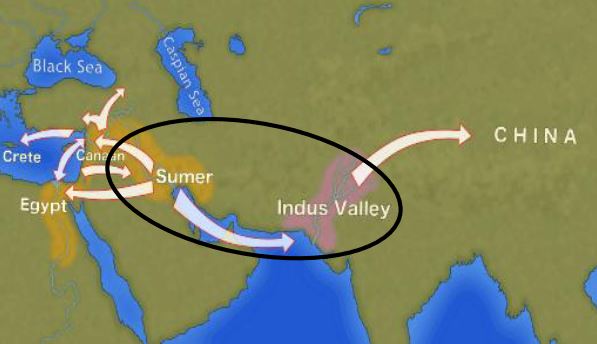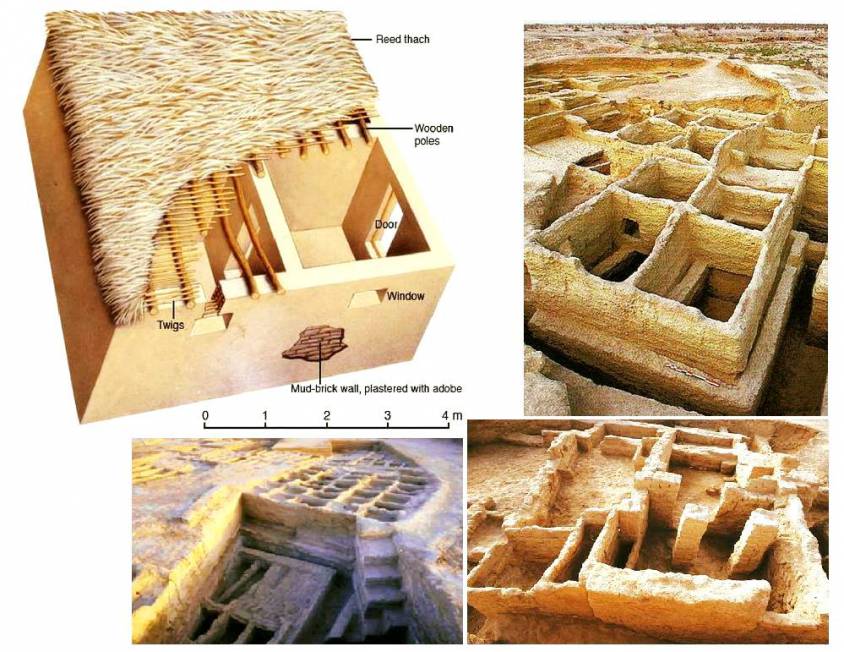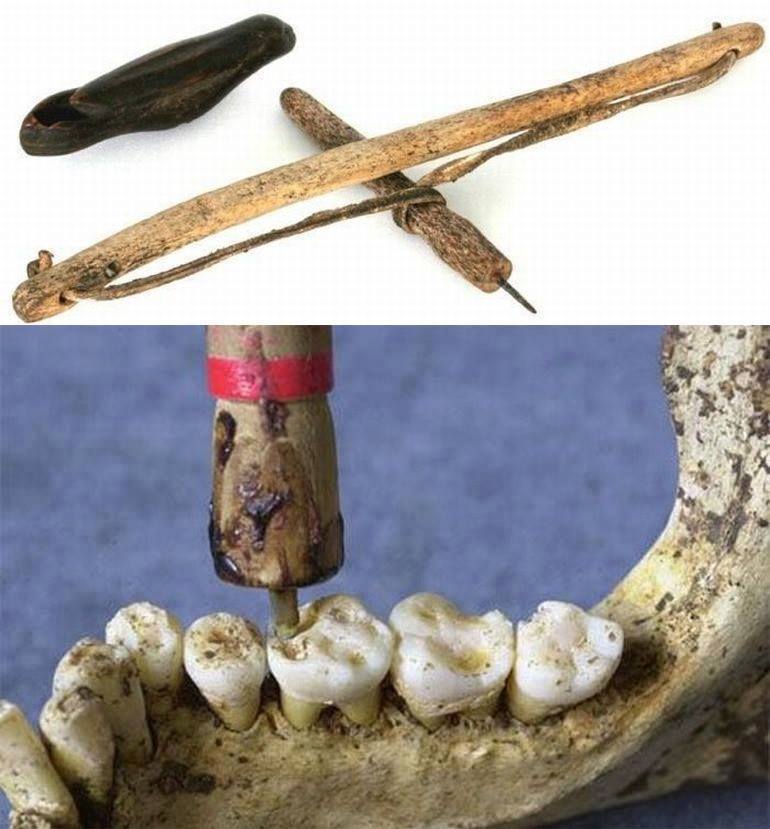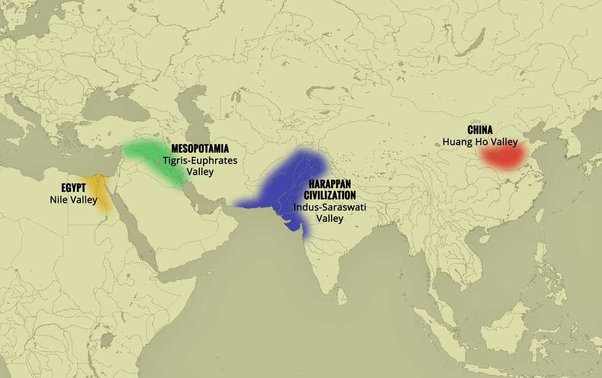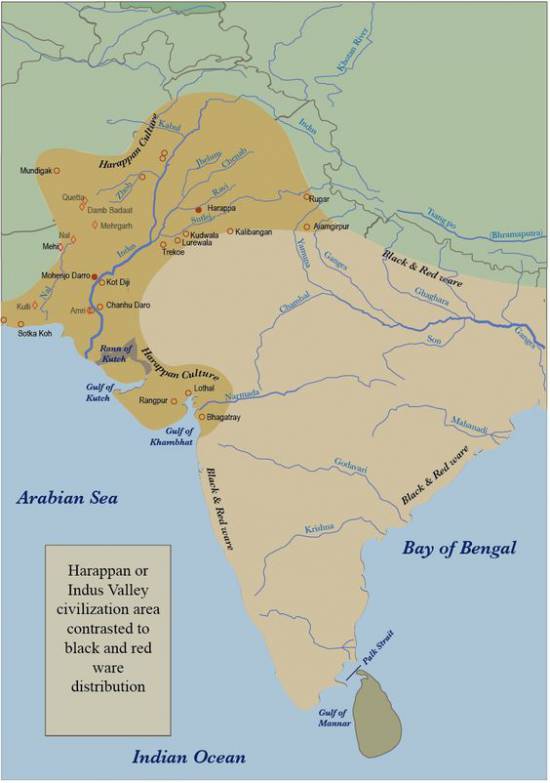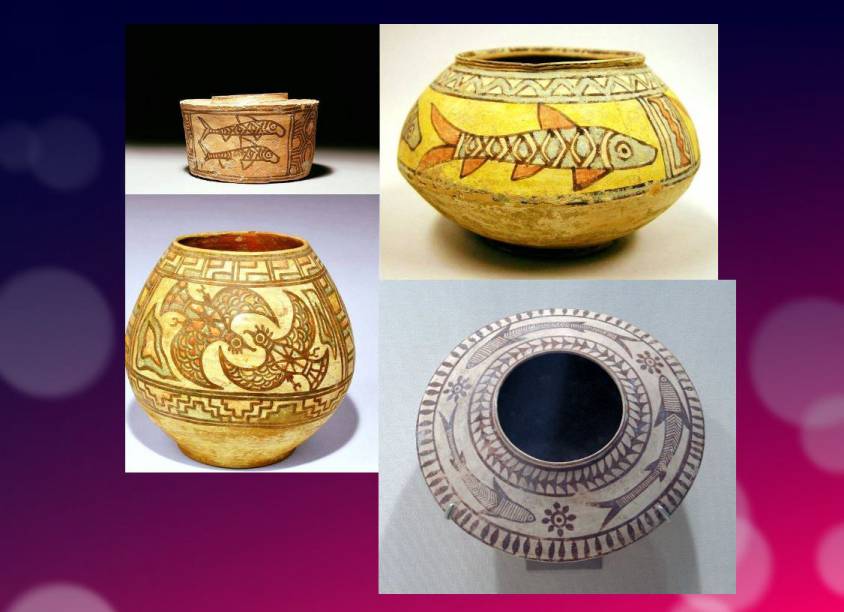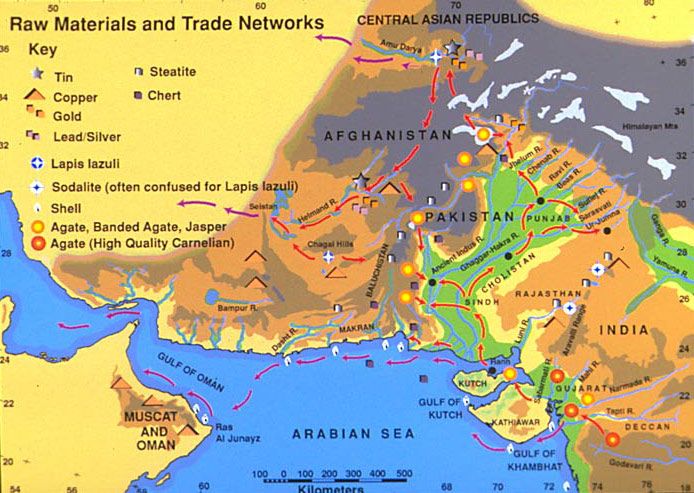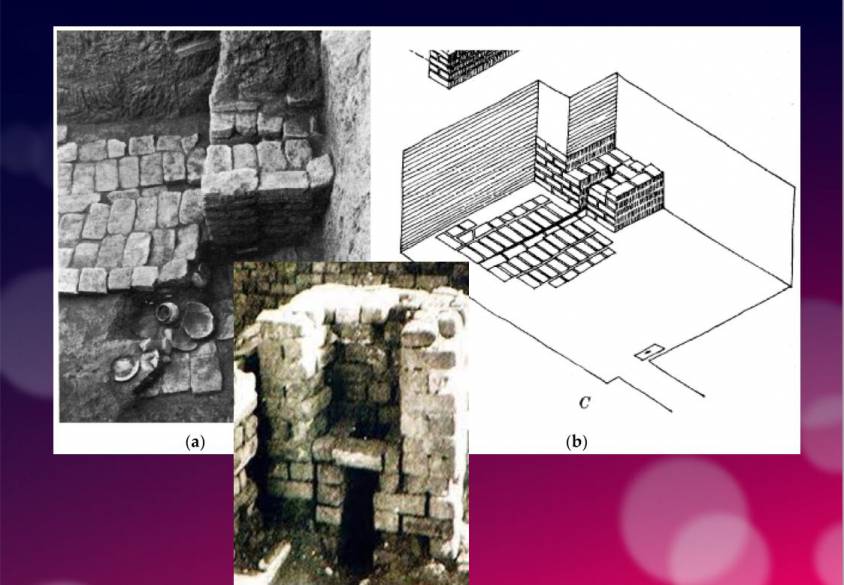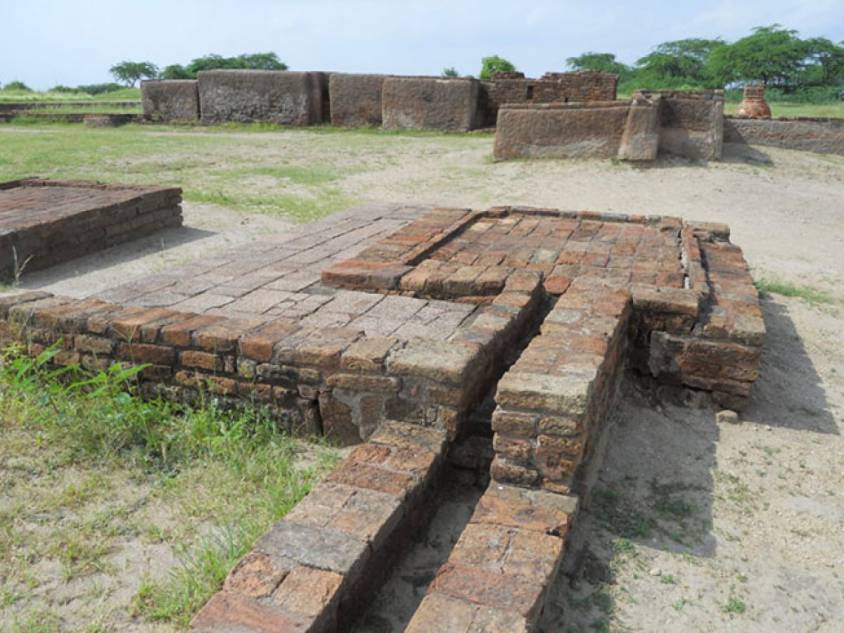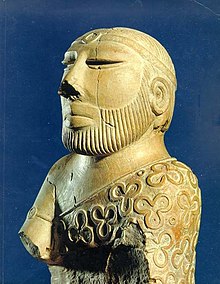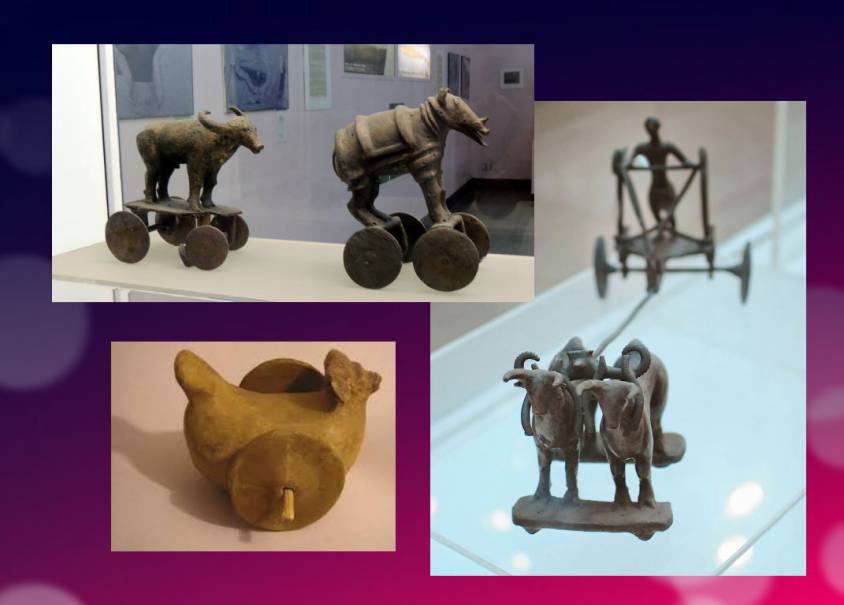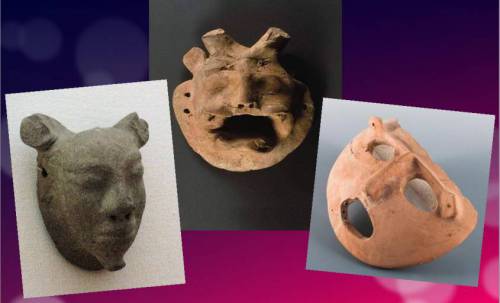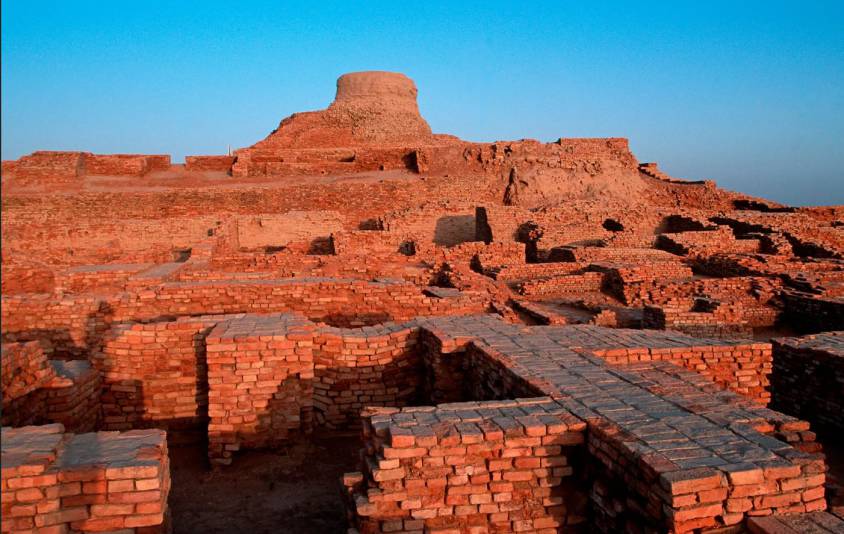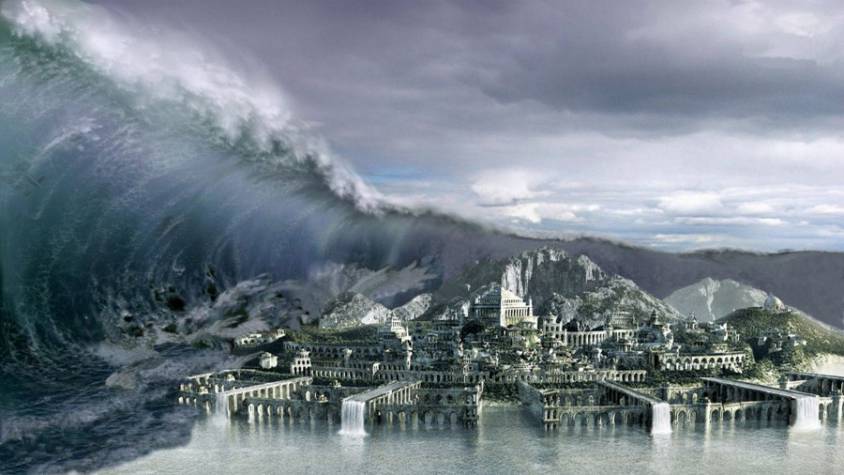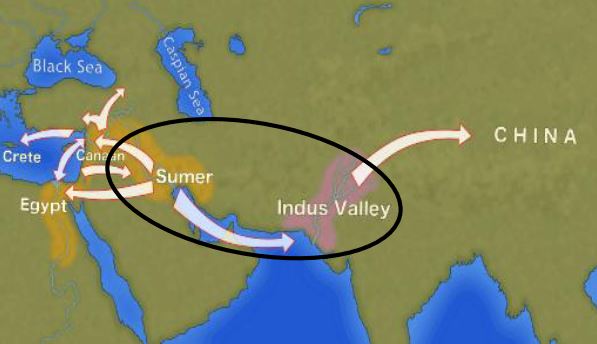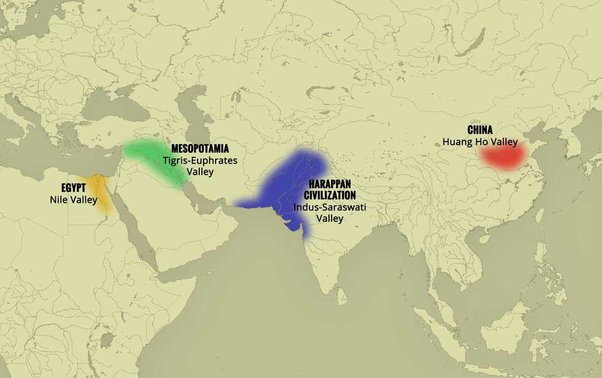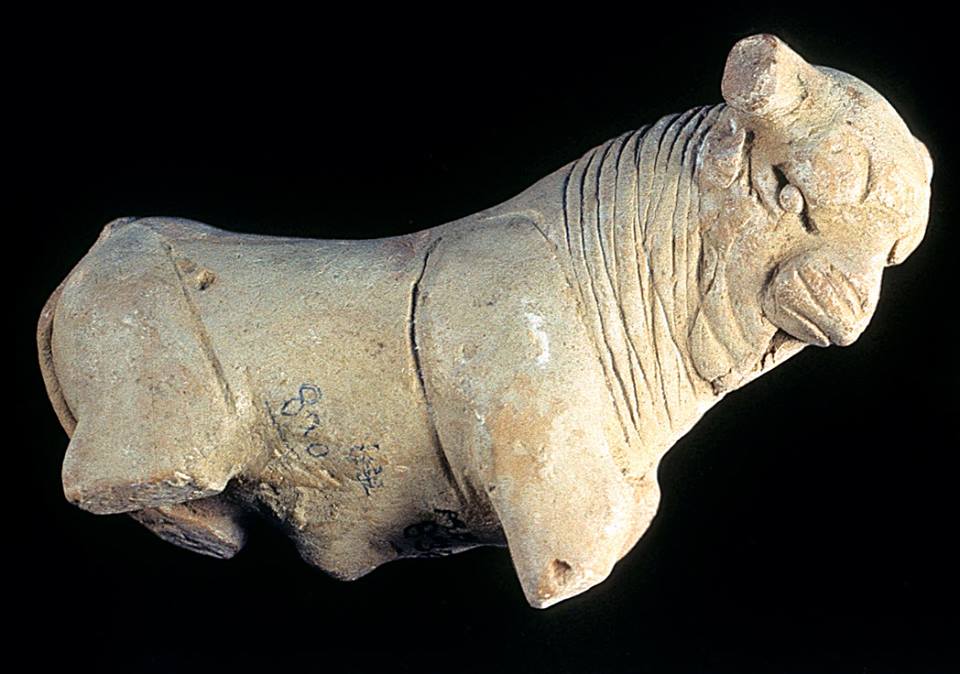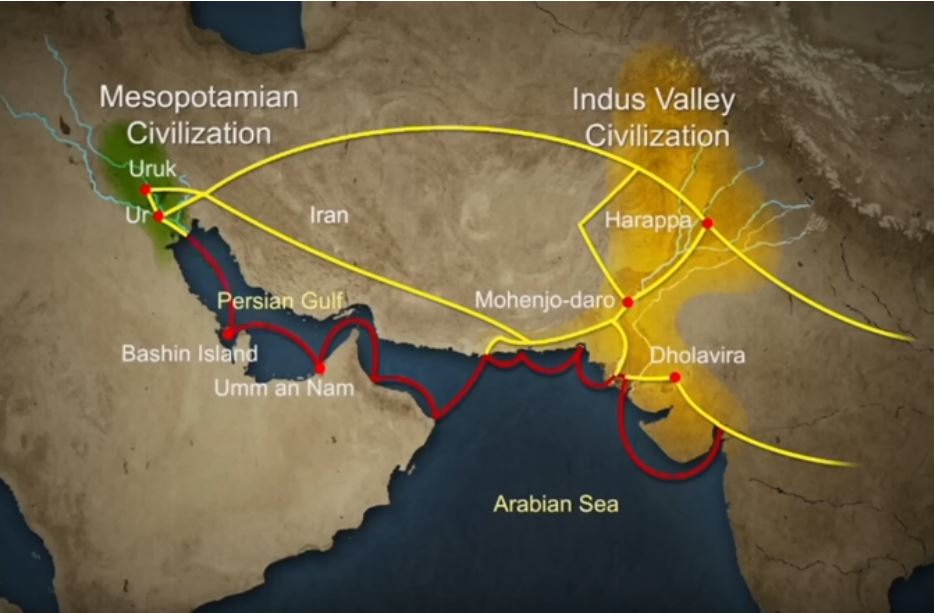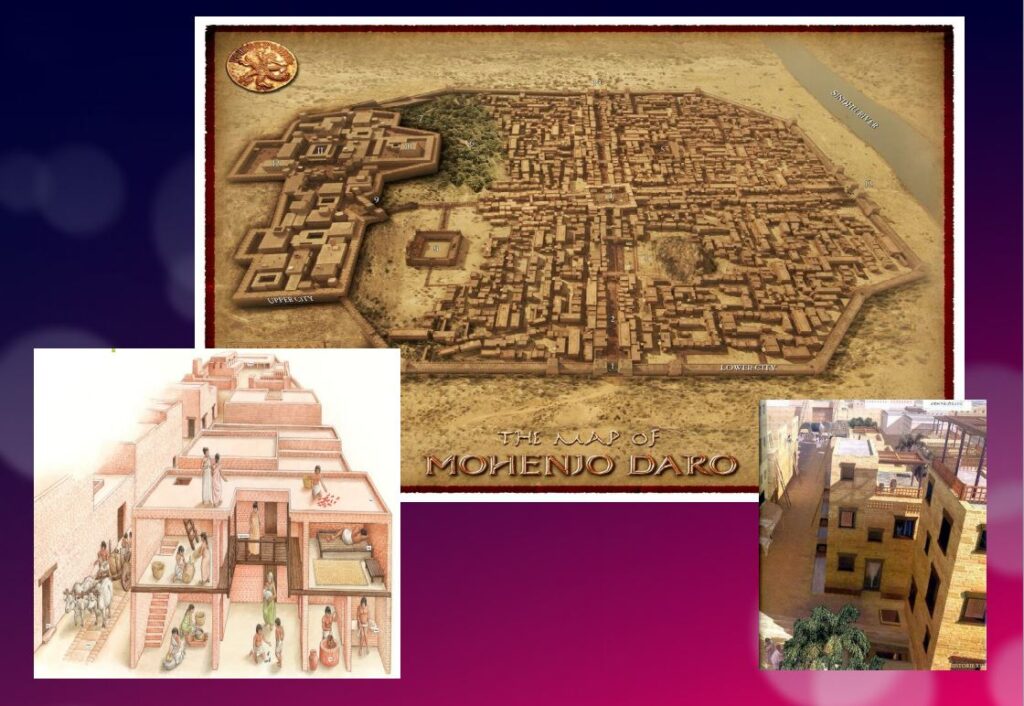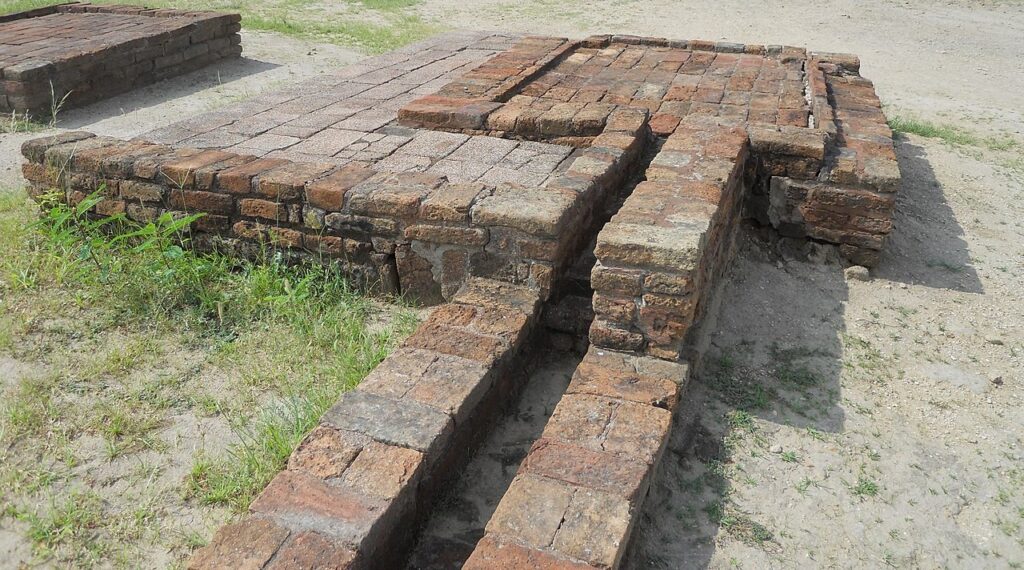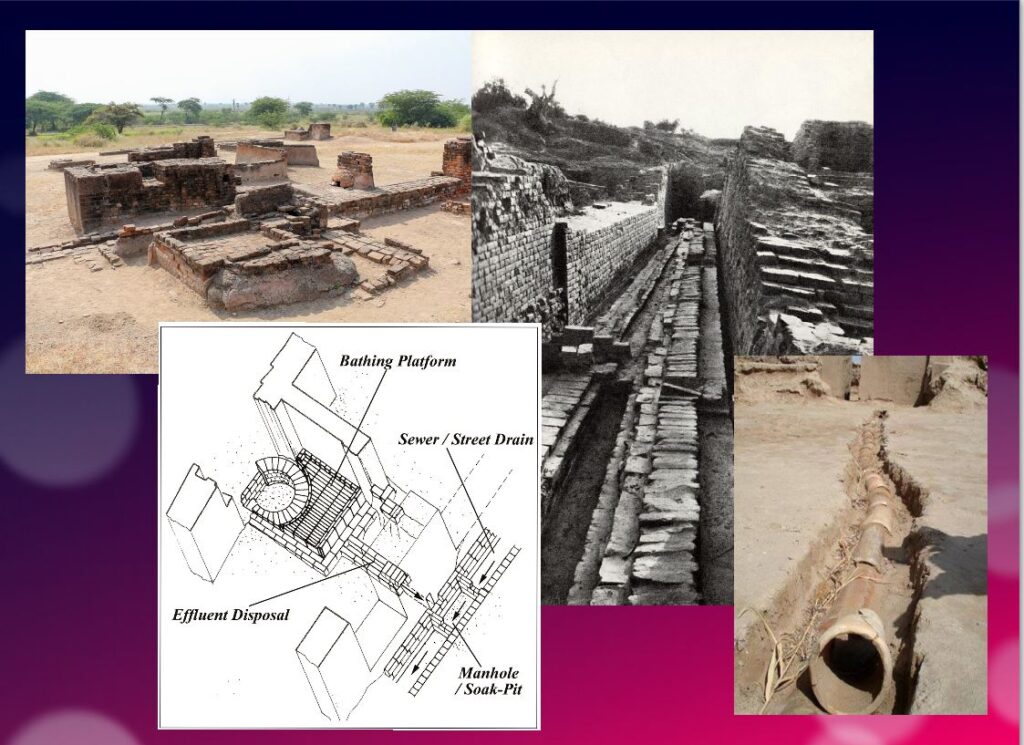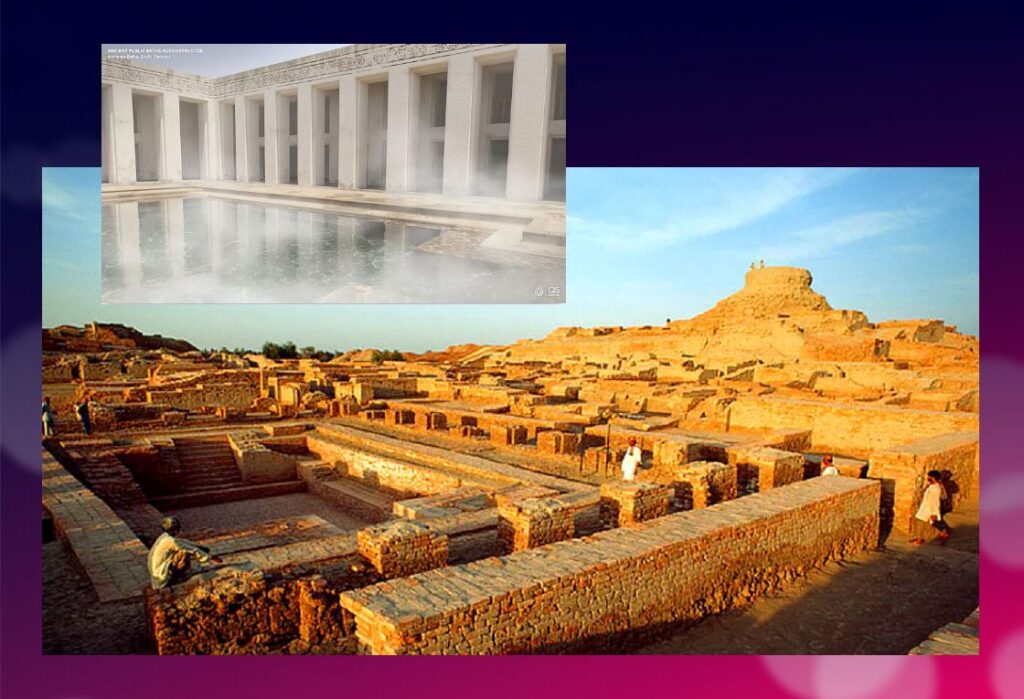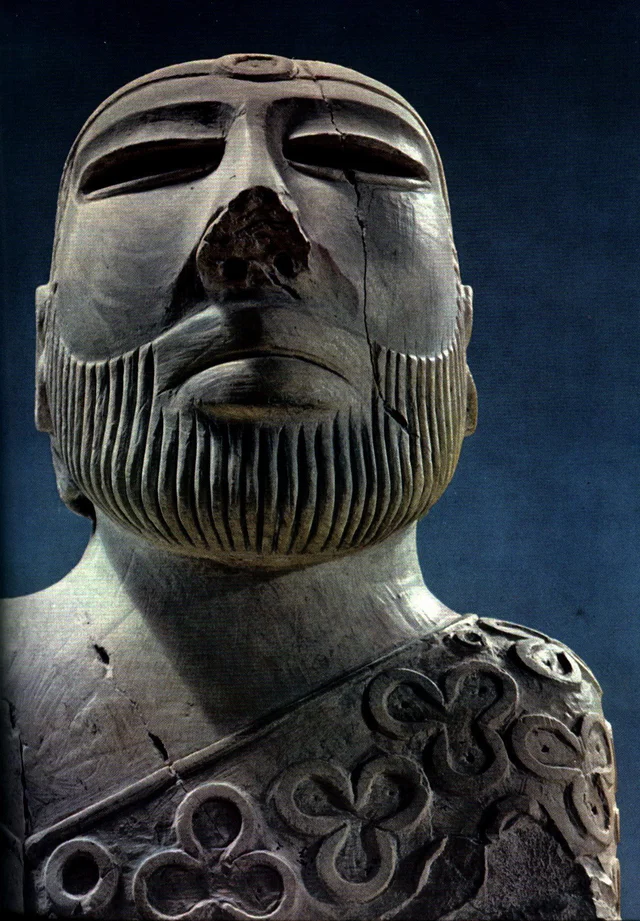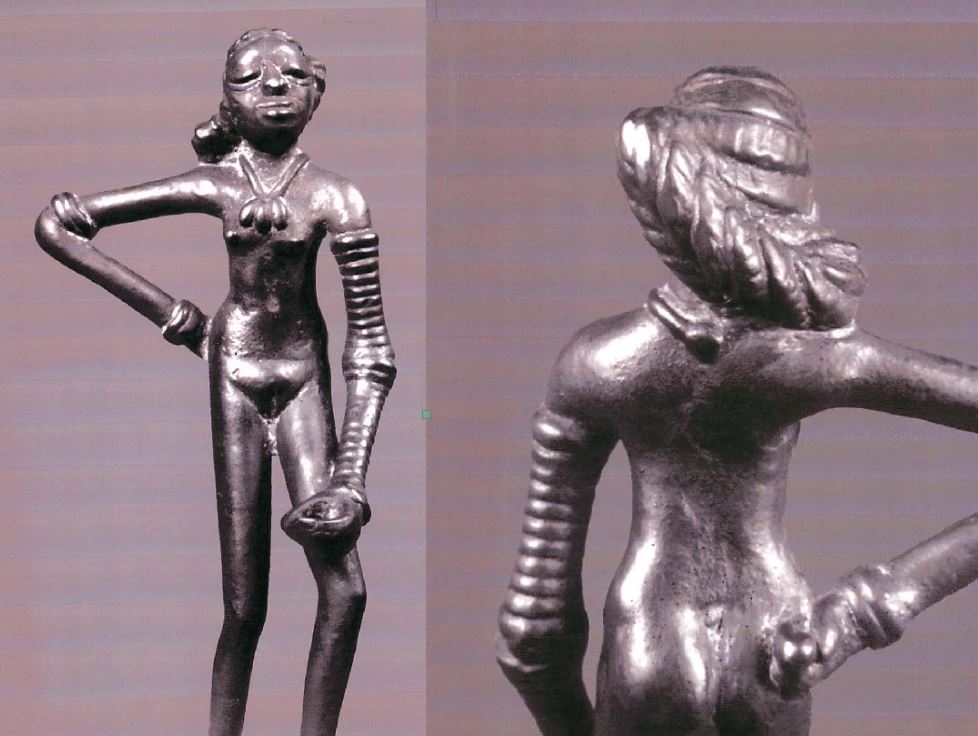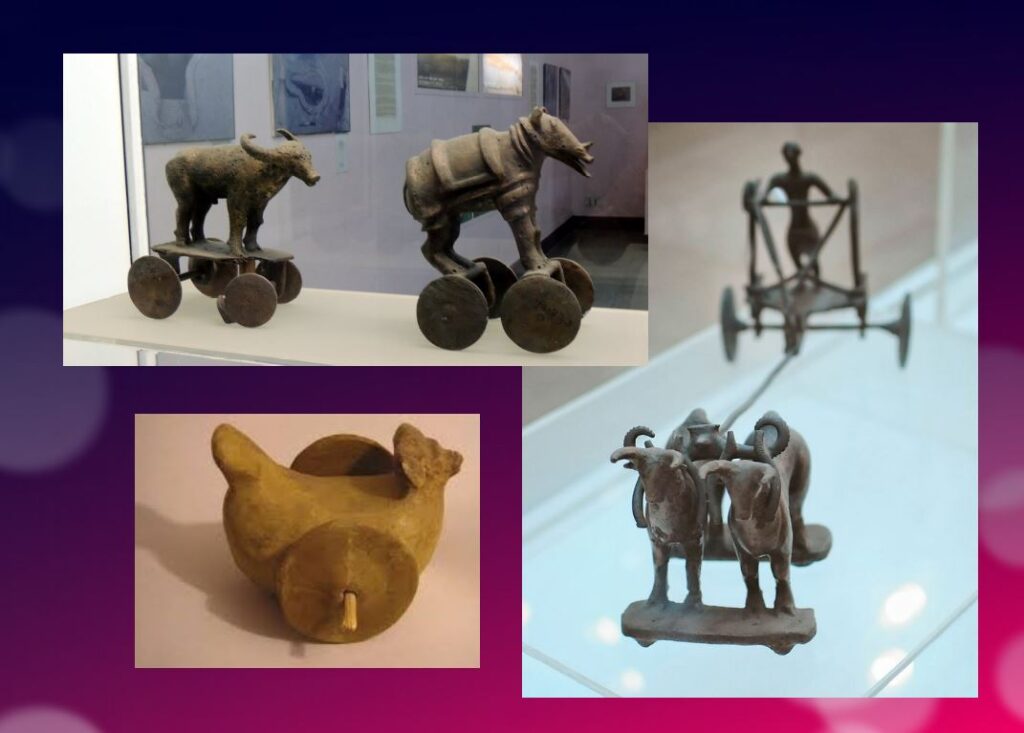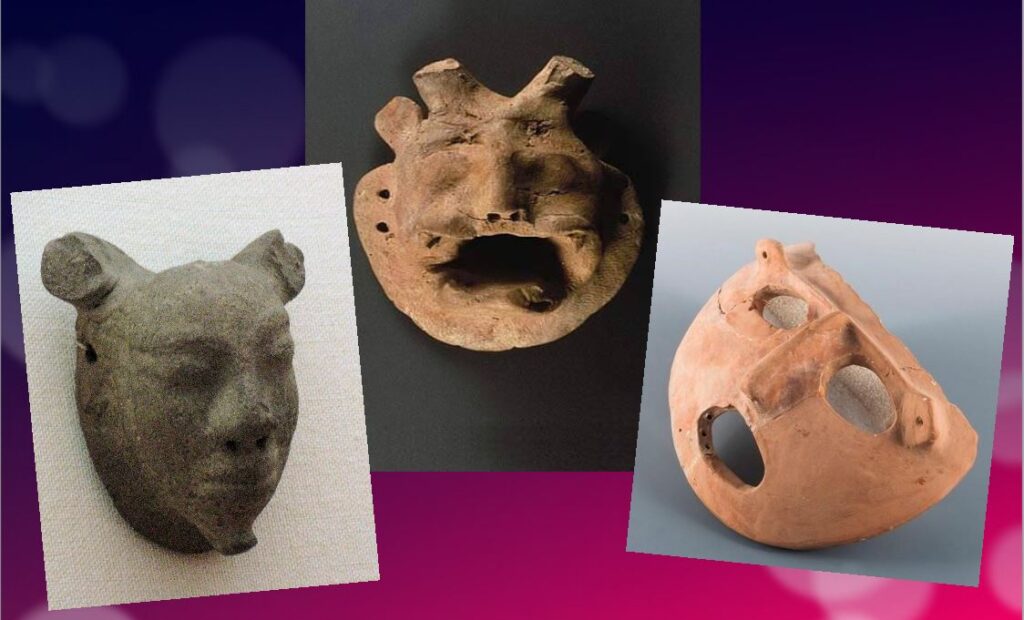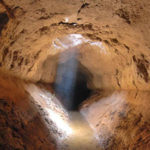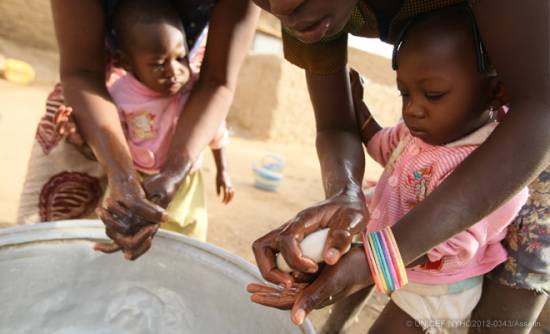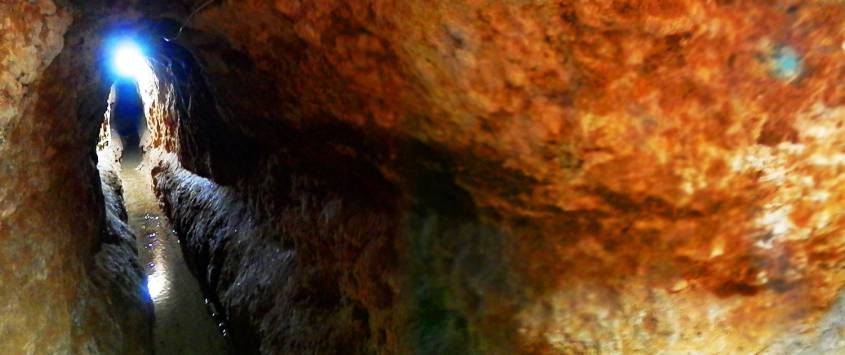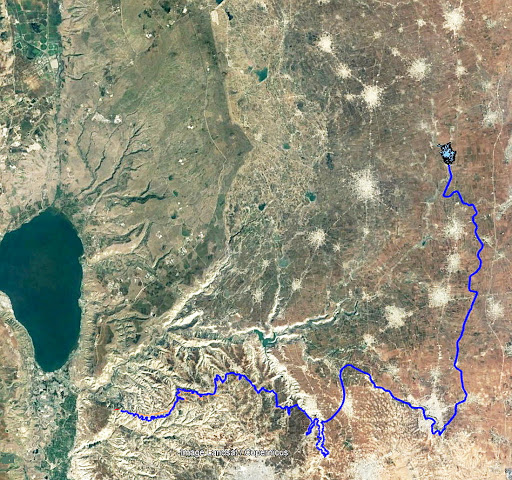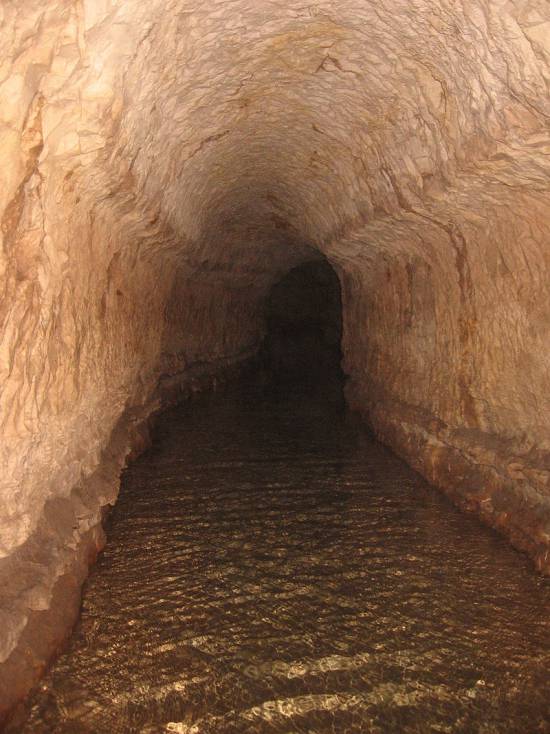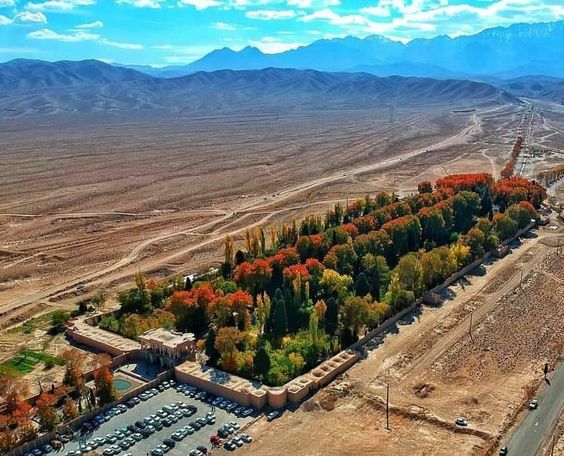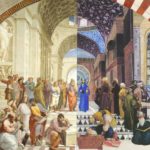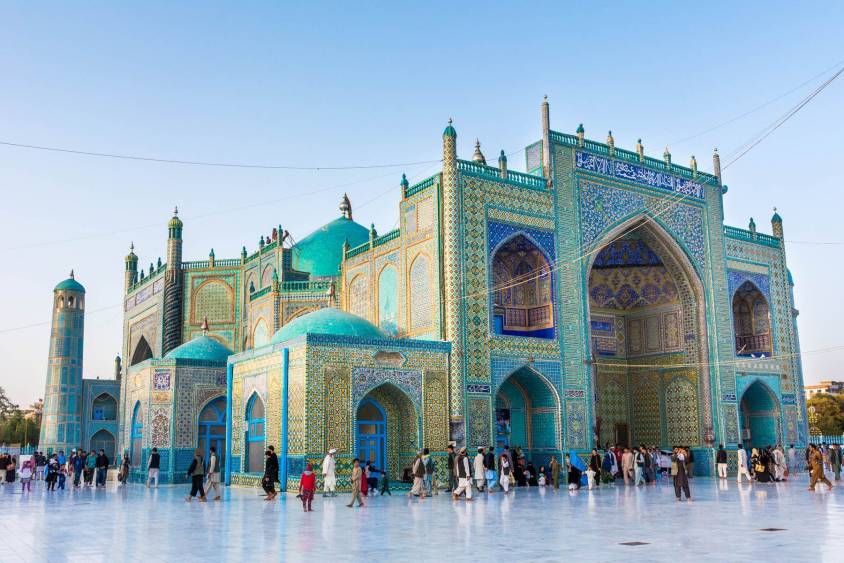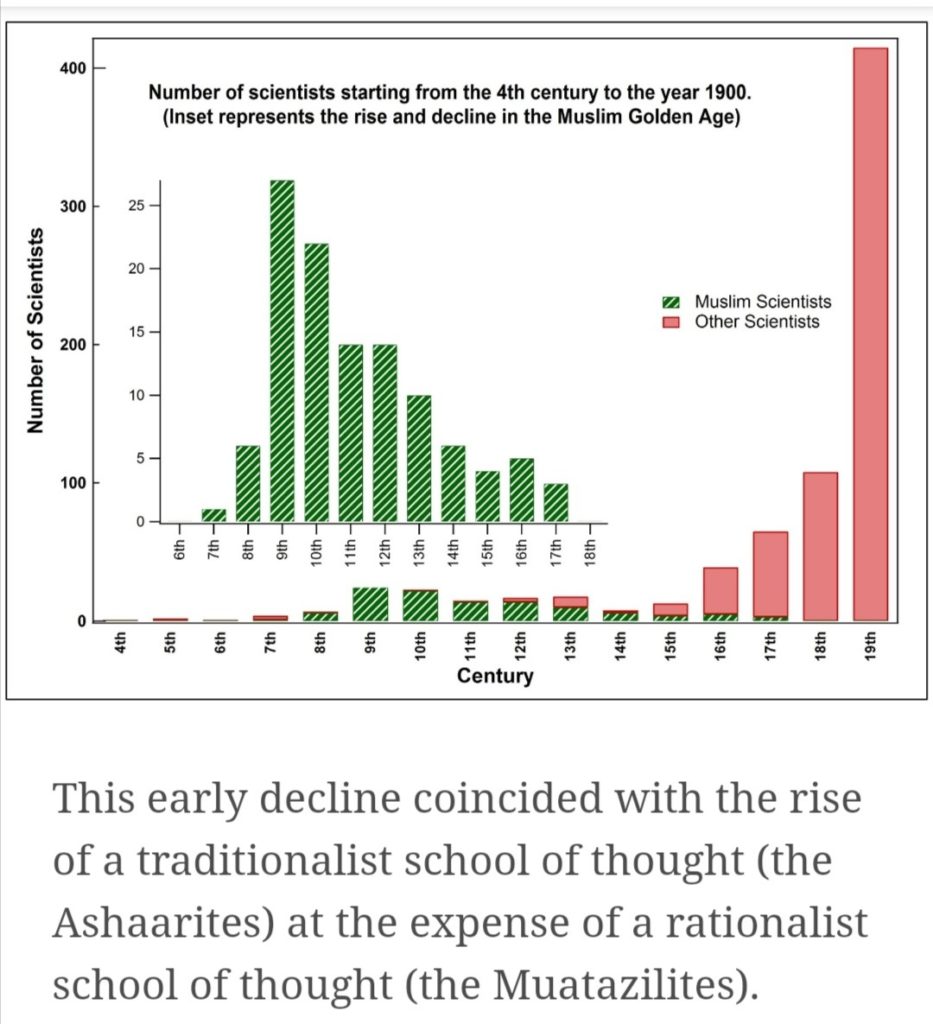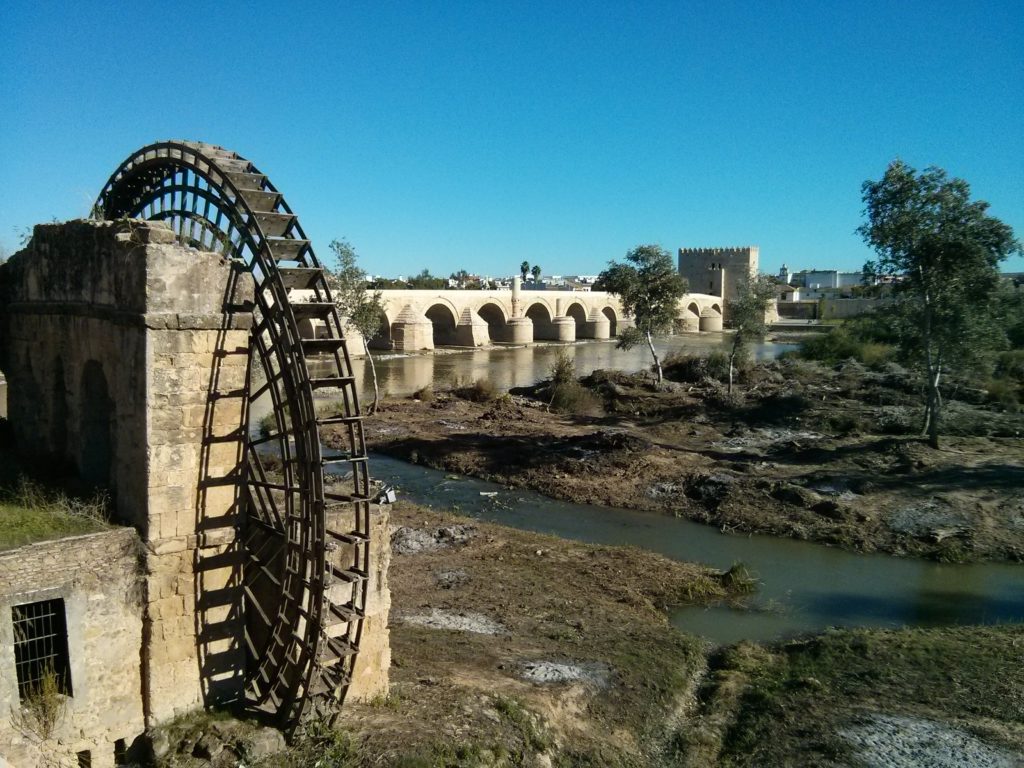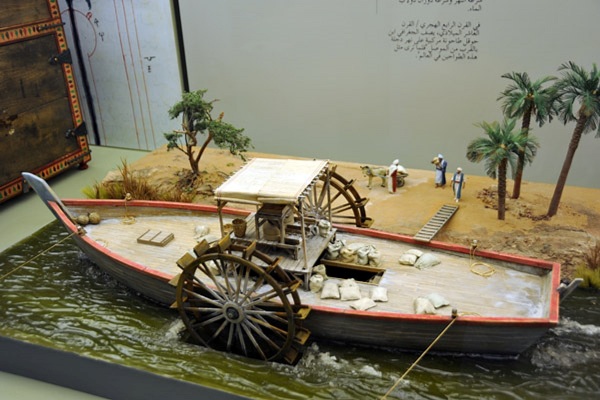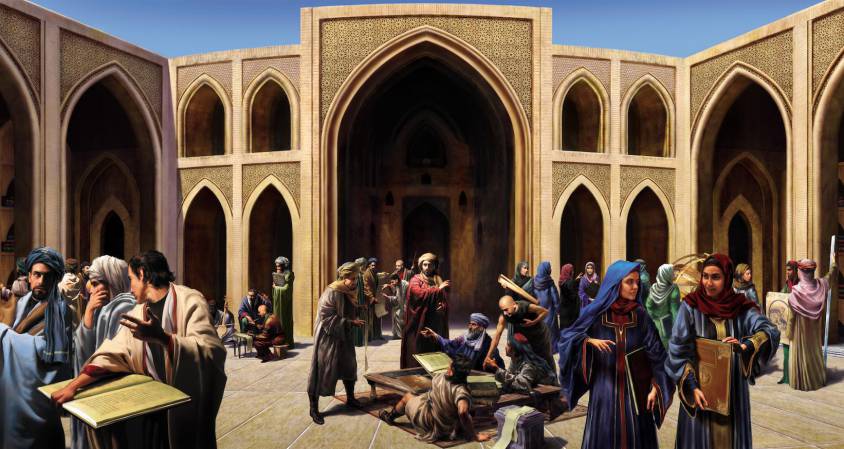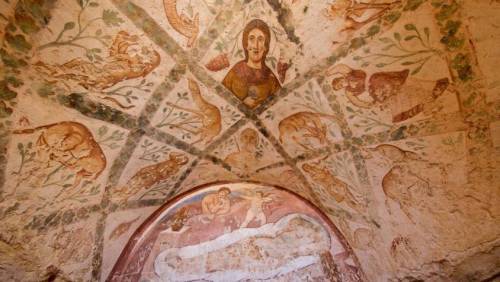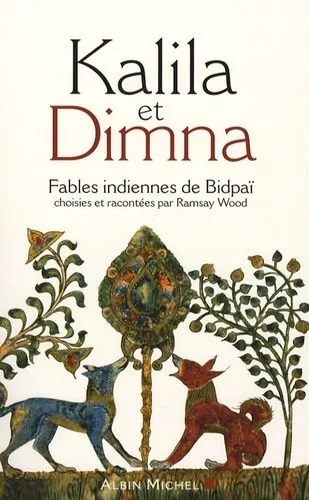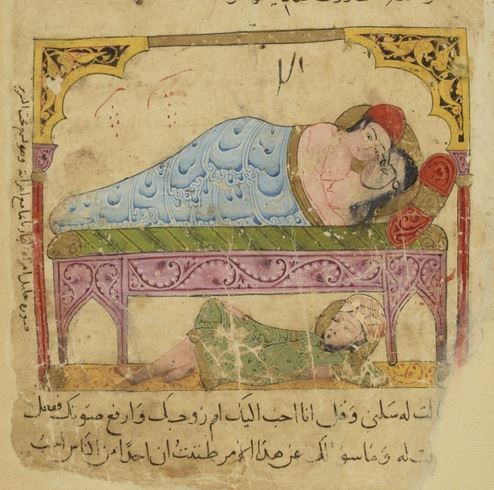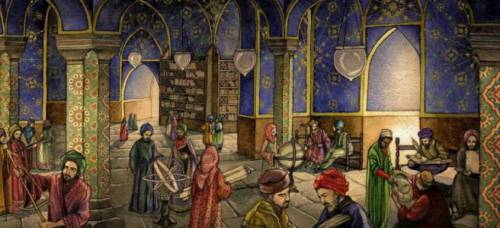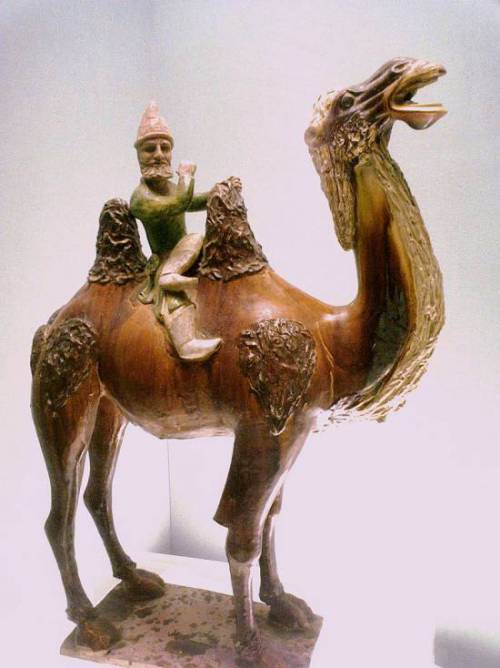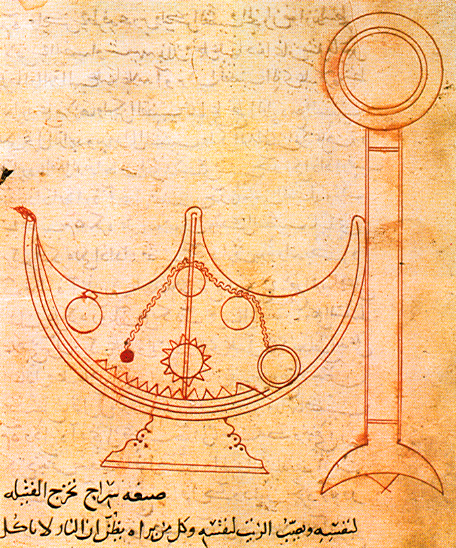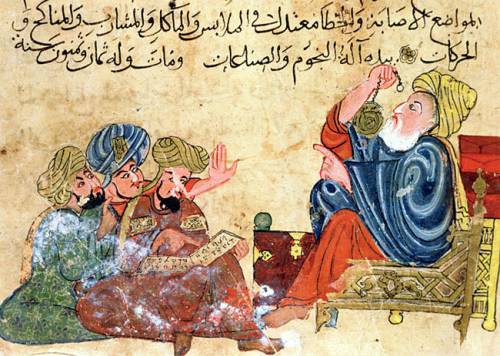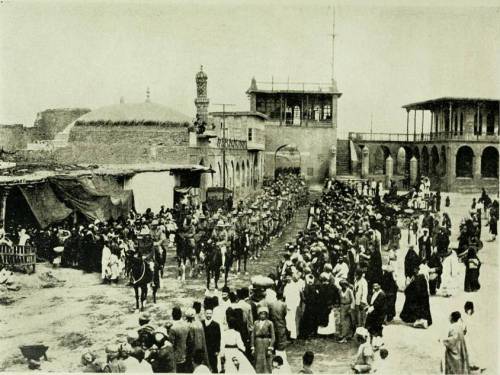Étiquette : Afghanistan
Le « miracle » du Gandhara : quand Bouddha s’est fait homme


C’est lors de mon voyage en Afghanistan, en novembre 2023, que j’ai réalisé à quel point j’ignorais tout de cette partie du monde. Si aujourd’hui l’islam prévaut en Afghanistan et au Pakistan, on oublie souvent qu’une région commune à ces deux pays, historiquement connue sous le nom de Gandhara, a joué, du Ier au IIIe siècle de notre ère, un rôle majeur dans l’épopée du bouddhisme, une spiritualité qui, en refusant toute idée de caste, va bousculer l’ordre du monde.
Carrefour obligé sur les Routes de la soie reliant l’Europe à l’Inde et à la Chine, c’est au Gandhara, qu’a eu lieu un véritable dialogue entre les cultures eurasiatiques, perses, turques, grecques, chinoises et indiennes.
Bouddha. C’est par le volontarisme de deux grands rois d’Asie centrale (Ashoka et Kanishka) que le bouddhisme, né au Népal, trouvera l’énergie et la détermination pour gagner les esprits et les cœurs du monde.
Enfin, c’est au Gandhara que l’art bouddhique, en rupture avec les consignes du maître, va s’approprier les plus belles formes de diverses cultures artistiques grecques, indiennes, perses et autres, pour présenter bouddha sous une forme humaine aux fidèles, un homme éclairé, plein de sagesse et animé de compassion.
En offrant fraîcheur, poésie et un sens du mouvement spectaculairement moderne, les premiers artistes bouddhistes du Gandhara nous invitent à identifier en nous-mêmes, un saut vers l’auto-perfectionnement. A ce titre, ils sont les précurseurs de l’humanisme classique et de bien des Renaissances.
N’est-il pas temps de reconnaître la juste place que mérite leur contribution à la civilisation universelle ?
Enfin, vu la situation actuelle du monde, je tiens à citer le Premier Ministre indien Nehru, qui, le 3 octobre 1960 s’adressait à l’Assemblée générale des Nations unies avec des paroles qui n’ont cessé de gagner en pertinence : « Dans un passé lointain, un grand fils de l’Inde, le Bouddha, a dit que la seule vraie victoire était celle où tous étaient également victorieux et où personne n’était vaincu. Dans le monde d’aujourd’hui, c’est la seule victoire concrète ; toute autre voie mène au désastre. »
- Introduction
- Bouddha, bio-express
- Les quatre vérités et l’octuple sentier
- Réincarnation
- Les Aryens et le védisme
- Les Brahmanes et le système des castes
- L’Inde avant le Bouddhisme
- Les grands conciles bouddhistes
- L’arrivée des Grecs
- L’Empire Maurya
- Le règne d’Ashoka le Grand
- Edits d’Ashoka
- Contenu des édits
- L’Empire Kouchan
- Le miracle de Gandhara
a) La poésie
b) La littérature
c) L’urbanisme
d) L’architecture, l’invention des stupa
e) Sculpture
–Aniconisme
–Fin de l’aniconisme
–Différence de forme, différence de contenu
1) Ecole greco-bouddhique de Gandhara
2) Ecole de Mathura
3) Ecole d’Andrah Pradesh
4) Ecole de la période Gupta. - Lorsque l’Asie rencontre la Grèce
a) Pièces de monnaies kouchanes
b) Reliquaire bimaran
c) Triade de Harra
d) Prendre la terre à témoin
e) Tous Bodhisattva - Le Bouddhisme aujourd’hui, l’exemple de Nehru
- Science et religion, Albert Einstein et Buddha.
Introduction
Les Ve et IVe siècles avant J.-C. furent une période d’effervescence intellectuelle mondiale. C’est l’époque des grands penseurs, tels que Socrate, Platon et Confucius, mais aussi Panini et Bouddha.
Dans le nord de l’Inde, c’est l’âge du Bouddha, après la mort duquel émerge une foi non théiste (Bouddha n’est qu’un homme…), qui se répand bien au-delà de sa région d’origine. Avec entre 500 millions et un milliard de croyants, le bouddhisme constitue aujourd’hui l’une des principales croyances religieuses et philosophiques du monde et sans doute une force potentielle redoutable pour la paix.
Bouddha, bio-express

« Le bouddha » (l’éveillé) est le nom donné à un homme appelé Siddhartha Gautama Shakyamuni (le muni ou sage du clan des Shakya). Il aurait atteint l’âge d’environ quatre-vingts an. Craignant l’idolâtrie, il refuse toute représentation de sa personne sous forme d’image.
Les traditions divergent sur les dates exactes de sa vie que la recherche moderne tend à situer de plus en plus tard : vers 623-543 av. J.-C. selon la tradition theravâda, vers 563-483 av. J.-C. selon la majorité des spécialistes du début du XXe siècle, tandis que d’autres le situent aujourd’hui entre 420 et 380 av. J.-C. (sa vie n’aurait pas dépassé les 40 ans).
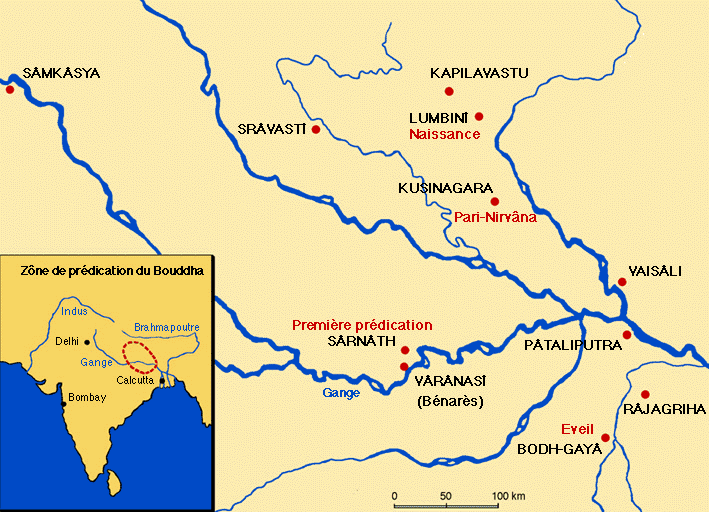
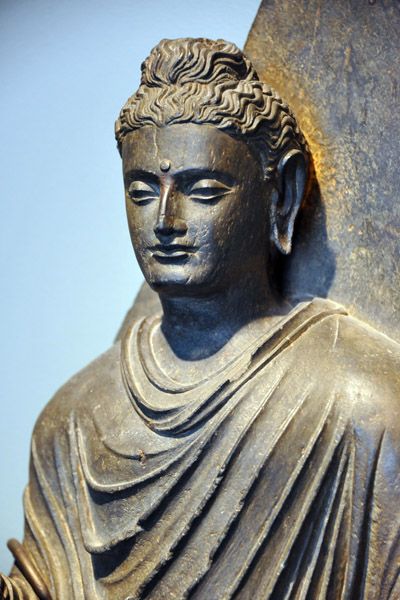
Selon la tradition, Siddhartha Gautama est né à Lumbini (dans l’actuel Népal) en tant que prince de la famille royale de la ville de Kapilavastu, un petit royaume situé dans les contreforts de l’Himalaya, dans l’actuel Népal.
Un astrologue aurait mis en garde le père du garçon, le roi Suddhodana : lorsque l’enfant grandirait, il deviendrait soit un brillant souverain, soit un moine influent, en fonction de sa lecture du monde. Farouchement déterminé à en faire son successeur, le père de Siddhartha ne le laissa donc jamais voir le monde en dehors des murs du palais. Tout en lui offrant tous les plaisirs et distractions possibles, il en fait un prisonnier virtuel jusqu’à l’âge de 29 ans.
Lorsque le jeune homme s’échappe de sa cage dorée, il découvre l’existence de personnes affectées par leur grand âge, la maladie et la mort. Bouleversé par la souffrance des gens ordinaires qu’il rencontre, Siddhartha abandonne les plaisirs éphémères du palais pour rechercher un but plus élevé dans la vie. Il se soumet d’abord à un ascétisme draconien, qu’il abandonne six ans plus tard, estimant qu’il s’agissait d’un exercice futile.
Il s’assoit alors sous un grand figuier pour méditer et y fait l’expérience du nirvana (la bodhi : libération ou, en sanskrit, extinction). On le désigne désormais sous le nom de « Bouddha » (l’éveillé ou l’éclairé).
Les « quatre vérités » et « l’octuple sentier »
Avant d’en esquisser le développement politique, quelques mots sur la philosophie sous-jacente au bouddhisme.
A ses jeunes disciples, Bouddha enseigne la « Voie du milieu », entre les deux extrêmes de la mortification et de la satisfaction des désirs.
Et il énonce les Quatre nobles vérités :
- La noble vérité de la souffrance.
- La noble vérité de l’origine de la souffrance.
- La noble vérité de la cessation de la souffrance.
- La noble vérité de la voie menant à la cessation de la souffrance, celle du Noble Chemin octuple.
Ainsi que le feront Augustin et plus encore les Frères de la Vie commune dans le monde chrétien, le bouddhisme insiste sur le fait que notre attachement à l’existence terrestre implique la souffrance.
Chez les chrétiens, c’est ce qui conduirait au « péché », notion inexistante dans le bouddhisme, pour qui l’errance vient de l’ignorance du bon chemin.
Pour Bouddha, il faut combattre, voire éteindre tout sens démesuré du moi (on dirait ego aujourd’hui). Il est possible de mettre fin à notre souffrance en transcendant ce fort sentiment de « moi », afin d’entrer dans une plus grande harmonie avec les choses en général. Les moyens d’y parvenir sont résumés dans le Noble Chemin octuple, parfois représenté par les huit rayons d’une Roue de la Loi (dharmachakra) que Bouddha mettra en marche, la Loi signifiant ici le dharma, un ensemble de préceptes moraux et philosophiques.
Ces huit points du Noble Chemin octuple sont :
- la vue juste
- la pensée juste
- la parole juste
- l’action juste
- les moyens d’existence justes
- l’effort juste
- la pleine conscience
- la concentration juste
– La vision juste est importante dès le départ, car sans cela, on ne peut pas voir la vérité des quatre nobles vérités.
– La pensée juste en découle naturellement. Le terme « juste » signifie ici « en accord avec les faits », c’est-à-dire avec la façon dont les choses sont (qui peut être différente de la façon dont je voudrais qu’elles soient).
– La pensée juste, la parole juste, l’action juste et les moyens d’existence justes impliquent une retenue morale – s’abstenir de mentir, de voler, de commettre des actes violents et gagner sa vie d’une manière qui ne soit pas préjudiciable aux autres. La retenue morale ne contribue pas seulement à l’harmonie sociale générale, elle nous aide aussi à contrôler et à diminuer le sentiment démesuré du « moi ». Comme un enfant gâté, le « moi » grandit et devient indiscipliné à mesure que nous le laissons agir à sa guise.
– Ensuite, l’effort juste est important parce que le « moi » prospère dans l’oisiveté et le mauvais effort ; certains des plus grands criminels sont les personnes les plus énergiques, donc l’effort doit être approprié à la diminution du « moi » (son ego, dirait-on aujourd’hui). Dans tous les cas, si nous ne sommes pas prêts à faire des efforts, nous ne pouvons pas espérer obtenir quoi que ce soit, ni dans le sens spirituel ni dans la vie. Les deux dernières étapes de la voie, la pleine conscience et la concentration ou absorption, représentent la première étape permettant de nous libérer de la souffrance.
Les ascètes qui avaient écouté le premier discours du Bouddha devinrent le noyau d’un sangha (communauté, mouvement) d’hommes (les femmes devaient entrer plus tard) qui suivaient la voie décrite par le Bouddha dans sa Quatrième noble vérité, celle précisant le Noble Chemin octuple.
Pour rendre le nirvana bouddhiste accessible au citoyen ordinaire, l’imagination bouddhiste a inventé le concept très intéressant de bodhisattva, mot dont le sens varie selon le contexte. Il peut aussi bien désigner l’état dans lequel se trouvait Bouddha lui-même avant son « éveil », qu’un homme ordinaire ayant pris la résolution de devenir un bouddha et ayant reçu d’un bouddha vivant la confirmation ou la prédiction qu’il en serait ainsi.
Dans le bouddhisme theravâda (l’école ancienne), seules quelques personnes choisies peuvent devenir des bodhisattvas, comme Maitreya, présenté comme le « Bouddha à venir ».
Mais dans le bouddhisme mahâyâna (Grand Véhicule), un bodhisattva désigne toute personne qui a généré la bodhicitta, un souhait spontané et un esprit compatissant visant à atteindre l’état de bouddha pour le bien de « tous les êtres sensibles », hommes aussi bien qu’animaux. Etant donné qu’une personne peut, dans une vie future, se réincarner dans un animal, le respect des animaux s’impose.
Réincarnation
Tout en voulant construire sa propre vision sur certains fondements de l’hindouisme, l’une des plus anciennes religions du monde, Siddhartha introduisit néanmoins des changements révolutionnaires aux implications politiques importantes.
Dans la plupart des croyances impliquant la réincarnation (hindouisme, jaïnisme, sikhisme), l’âme humaine est immortelle et ne se disperse pas après la disparition du corps physique. Après la mort, l’âme transmigre simplement (métempsychose) dans un nouveau-né ou un animal pour poursuivre son immortalité. La croyance en la renaissance de l’âme a été exprimée par les penseurs grecs anciens, à commencer par Pythagore, Socrate et Platon.
Le but du bouddhisme est d’apporter un bonheur durable et inconditionnel. Celui de l’hindouisme est de se libérer du cycle de naissance et de renaissance (samsara) pour atteindre, finalement, le moksha, qui en est la libération.
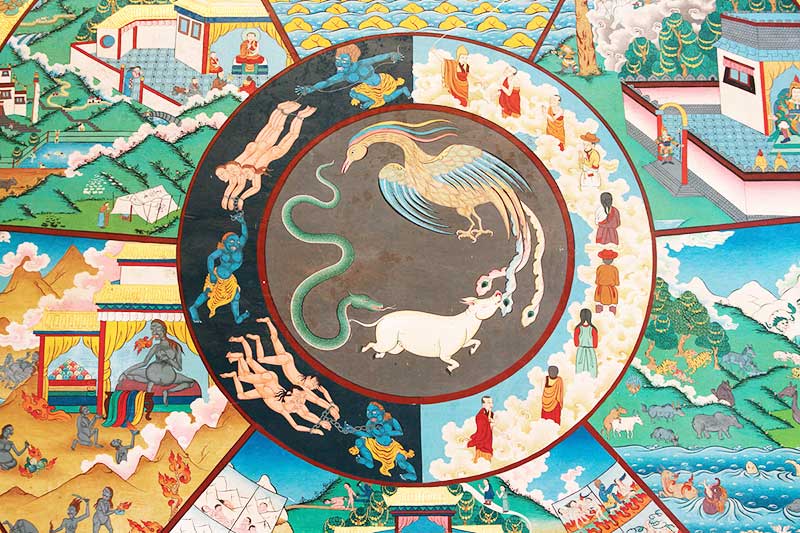
Le bouddhisme et l’hindouisme s’accordent sur le karma, le dharma, le moksha et la réincarnation. Mais ils diffèrent politiquement dans la mesure où le bouddhisme se concentre sur l’effort personnel de chacun et accorde par conséquent une moindre importance aux prêtres et aux rituels formels que l’hindouisme. Enfin, le bouddhisme ne reconnaît pas la notion de caste et prône donc une société plus égalitaire.
Alors que l’hindouisme soutient que l’on ne peut atteindre le nirvana que dans une vie ultérieure, le bouddhisme, plus volontariste et optimiste, soutient qu’une fois qu’on a réalisé que la vie est souffrance, on peut mettre un terme à cette souffrance dans sa vie présente.
Les bouddhistes décrivent leur renaissance comme une bougie vacillante qui vient en allumer une autre, plutôt que comme une âme immortelle ou un « moi » passant d’un corps à un autre, ainsi que le croient les hindous. Pour les bouddhistes, il s’agit d’une renaissance sans « soi », et ils considèrent la réalisation du non-soi ou du vide comme le nirvana (extinction), alors que pour les hindous, l’âme, une fois libérée du cycle des renaissances, ne s’éteint pas, mais s’unit à l’Être suprême et entre dans un éternel état de félicité divine.
Les Aryens et le védisme
L’une des grandes traditions ayant façonné l’hindouisme est la religion védique (védisme), qui s’est épanouie chez les peuples indo-aryens du nord-ouest du sous-continent indien (Pendjab et plaine occidentale du Gange) au cours de la période védique (1500-500 av. J.-C.).
Au cours de cette période, des peuples nomades venus du Caucase et se désignant eux-mêmes comme « Aryens » (« noble », « civilisé » et « honorable ») pénétrèrent en Inde par la frontière nord-ouest.

Le terme « aryen » a une très mauvaise connotation historique, en particulier depuis le XIXe siècle, lorsque plusieurs antisémites virulents, tels qu’Arthur de Gobineau, Richard Wagner et Houston Chamberlain, ont commencé à promouvoir le mythe d’une « race aryenne », soutenant l’idéologie suprémaciste blanche de l’aryanisme qui dépeint la race aryenne comme une « race des seigneurs », les non-aryens étant considérés non seulement comme génétiquement inférieurs (Untermensch, ou sous-homme) mais surtout comme une menace existentielle à exterminer.

D’un point de vue purement scientifique, dans son livre The Arctic Home (1903), le patriote indien Bal Gangadhar Tilak (1856-1920), s’appuyant sur son analyse des observations astronomiques contenues dans les hymnes védiques, émet l’hypothèse selon laquelle le pôle Nord aurait été le lieu de vie originel des Aryens pendant la période préglaciaire, région qu’ils auraient quittée vers 8000 avant J.-C. à cause de changements climatiques, migrant vers les parties septentrionales de l’Europe et de l’Asie. Gandhi disait de Tilak, l’un des pères du mouvement de l’indépendance du pays, qu’il était « l’artisan de l’Inde moderne ».
Les Aryens arrivant du Nord étaient probablement moins barbares qu’on ne l’a suggéré jusqu’à présent. Grâce à leur supériorité militaire et culturelle, ils conquirent toute la plaine du Gange, avant d’étendre leur domination sur les plateaux du Deccan.
Cette conquête a laissé des traces jusqu’à nos jours, puisque les régions occupées par ces envahisseurs parlent des langues indo-européennes issues du sanskrit. (*1)

En réalité, la culture védique est profondément enracinée dans la culture eurasienne des steppes Sintashta (2200-1800 avant notre ère) du sud de l’Oural, dans la culture Andronovo d’Asie centrale (2000-900 avant notre ère), qui s’étend du sud de l’Oural au cours supérieur de l’Ienisseï en Sibérie centrale, et enfin dans la Civilisation de la vallée de l’Indus (Harappa) (4000-1500 avant notre ère).
Cette culture védique se fonde sur les fameux Védas (savoirs), quatre textes religieux consignant la liturgie des rituels et des sacrifices et les plus anciennes écritures de l’hindouisme. La partie la plus ancienne du Rig-Veda a été composée oralement dans le nord-ouest de l’Inde (Pendjab) entre 1500 et 1200 av. JC., c’est-à-dire peu après l’effondrement de la Civilisation de la vallée de l’Indus.
Le philologue, grammairien et érudit sanskrit Panini, qu’on croit être un contemporain de Bouddha, est connu pour son traité de grammaire sanskrite en forme de sutra, qui a suscité de nombreux commentaires de la part d’érudits d’autres religions indiennes, notamment bouddhistes.
Les Brahmanes et le système des castes
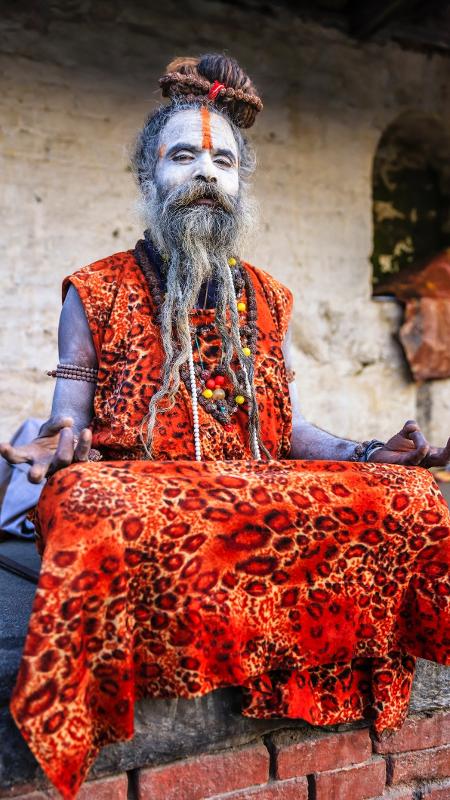
Cependant, avec l’émergence de cette culture aryenne apparut ce que l’on appelle le « brahmanisme », c’est-à-dire la naissance d’une caste toute puissante de grands prêtres.
« De nombreuses études linguistiques et historiques font état de troubles socioculturels résultant de cette migration et de la pénétration de la culture brahmanique dans diverses régions, de l’ouest de l’Asie du Sud vers l’Inde du Nord, l’Inde du Sud et l’Asie du Sud-Est », constate aujourd’hui Gajendran Ayyathurai, un anthropologue indien de l’Université de Göttingen en Allemagne.
Le brahman, littéralement « supérieur », est un membre de la caste sacerdotale la plus élevée (à ne pas confondre avec les adorateurs du dieu hindou Brahma). Bien que le terme apparaisse dans les Védas, les chercheurs modernes tempèrent ce fait et soulignent qu’il « n’existe aucune preuve dans le Rig-Veda d’un système de castes élaboré, très subdivisé et très important ».

Mais avec l’émergence d’une classe dirigeante de brahmanes, devenus banquiers et propriétaires terriens, notamment sous la période Gupta (de 319 à 515 après J.-C.), un redoutable système de castes se met graduellement en place. La classe dirigeante féodale, ainsi que les prêtres, vivant des recettes des sacrifices, mettront l’accent sur des dieux locaux qu’ils intégreront progressivement au brahmanisme afin de séduire les masses. Même parmi les souverains, le choix des divinités indiquait des positions divergentes : une partie de la dynastie Gupta soutenait traditionnellement le dieu Vishnou, tandis qu’une autre soutenait le dieu Shiva.
Ce système déshumanisant des castes fut ensuite amplifié et utilisé à outrance par la Compagnie britannique des Indes orientales, une entreprise et une armée privée à la tête de l’Empire britannique, pour imposer son pouvoir aristocratique et colonial sur les Indes, une politique qui perdure encore aujourd’hui, surtout dans les esprits.
Le système hindou des castes s’articule autour de deux concepts clés permettant de catégoriser les membres de la société : le varṇa et la jati. Le varna (littéralement « couleur ») divise la société en une hiérarchie de quatre grandes classes sociales :
- Brahmanes (la classe sacerdotale)
- Kshatriyas (guerriers et dirigeants)
- Vaishyas (marchands)
- Shudras (travailleurs manuels)
En outre, la jati fait référence à plus de 3000 classifications hiérarchiques, à l’intérieur des quatre varnas, entre les groupes sociaux en fonction de la profession, du statut social, de l’ascendance commune et de la localité…
La justification de cette stratification sociale est intimement liée à la vision hindouiste du karma. Car la naissance de chacun est directement liée au karma, véritable bilan de sa vie précédente. Ainsi, la naissance dans le varna brahmanique est le résultat d’un bon karma…
« Ceux qui ont eu une bonne conduite ici auront rapidement une bonne naissance – naissance en tant que brahmane, kshatriya ou vaishya. Mais ceux dont la conduite ici a été mauvaise obtiendront rapidement une mauvaise naissance – naissance en tant que chien, porc ou chandala (bandit). »
(Chandogya Upanishad 5.10.7)
Selon cette théorie, le karma détermine la naissance de l’individu dans une classe, ce qui définit son statut social et religieux, qui fixe à son tour ses devoirs et obligations au regard de ce statut spécifique.
En 2021, une enquête a révélé que trois Indiens sur dix (30 %) s’identifient comme membres des quatre varnas et seulement 4,3 % des Indiens (60,5 millions) comme des brahmanes.
Certains d’entre eux sont prêtres, d’autres exercent des professions telles qu’éducateurs, législateurs, érudits, médecins, écrivains, poètes, propriétaires terriens et politiciens. Au fur et à mesure de l’évolution de ce système de castes, les brahmanes ont acquis une forte influence en Inde et ont exercé une discrimination à l’encontre des autres castes « inférieures ».

L’immense partie restante des Indiens (70 %), y compris parmi les hindous, déclare faire partie des dalits, encore appelés intouchables, des individus considérés, du point de vue du système des castes, comme hors castes et affectés à des fonctions ou métiers jugés impurs. Présents en Inde, mais également dans toute l’Asie du Sud, les dalits sont victimes de fortes discriminations. En Inde, une écrasante majorité de bouddhistes se déclarent dalits.
Dès le Ier siècle, le philosophe bouddhiste, dramaturge, poète, musicien et orateur indien Asvaghosa (v. 80 – v. 150 ap. J.-C.) a élevé la voix pour condamner ce système des castes, avec des arguments empruntés pour certains aux textes les plus vénérés des brahmanes eux-mêmes, et pour d’autres, fondés sur le principe de l’égalité naturelle entre tous les hommes.
Selon Asvaghosa,
« la qualité de brahmane n’est inhérente ni au principe qui vit en nous, ni au corps dans lequel réside ce principe, et elle ne résulte ni de la naissance, ni de la science, ni des pratiques religieuses, ni de l’observation des devoirs moraux, ni de la connaissance des Védas. Puisque cette qualité n’est ni inhérente ni acquise, elle n’existe pas, ou plutôt tous les hommes peuvent la posséder. »
Une allégorie bouddhiste rejette clairement et se moque de l’idée même du système de castes:
« De même que le sable ne devient pas de la nourriture simplement parce qu’un enfant le dit, lorsque de jeunes enfants jouant sur une route principale construisent des pâtés de sable et leur donnent des noms, en disant ‘Celui-ci est du lait, celui-ci de la viande et celui-ci du lait caillé’, il en va de même pour les quatre varnas, tels que vous, les brahmanes, les décrivez. »
L’Inde avant le bouddhisme
L’époque du Bouddha est celle de la deuxième urbanisation de l’Inde et d’une grande contestation sociale.
L’essor des shramaṇas, des philosophes ou moines errants ayant rejeté l’autorité des Védas et des brahmanes, était nouveau. Bouddha n’était pas le seul à explorer les moyens d’obtenir la libération (moksha) du cycle éternel des renaissances (saṃsara).
Le constat que les rituels védiques ne menaient pas à une libération éternelle conduisit à la recherche d’autres moyens. Le bouddhisme primitif, le yoga et des courants similaires de l’hindouisme, jaïnisme, ajivika, ajnana et chârvaka, étaient les shramanas les plus importants.
Malgré le succès obtenu en diffusant des idées et des concepts qui allaient bientôt être acceptés par toutes les religions de l’Inde, les écoles orthodoxes de philosophie hindoue (astika) s’opposaient aux écoles de pensée shramaṇiques et réfutèrent leurs doctrines en les qualifiant d’hétérodoxes (nastika), parce qu’elles refusaient d’accepter l’autorité épistémique des Védas.
Pendant plus de quarante ans, le Bouddha sillonna l’Inde à pied pour diffuser son dharma, un ensemble de préceptes et de lois sur le comportement de ses disciples. À sa mort, son corps fut incinéré, comme c’était la coutume en Inde, et ses cendres furent réparties dans plusieurs reliquaires, enterrés dans de grands monticules hémisphériques connus sous le nom de stupas. Alors déjà, sa religion était répandue dans tout le centre de l’Inde et dans de grandes villes indiennes comme Vaishali, Shravasti et Rajagriha.
Les grands conciles bouddhistes

Quatre grands conciles bouddhistes furent organisés, à l’instigation de différents rois qui cherchaient en réalité à briser l’omnipuissante caste des brahmanes.
Le premier eut lieu en 483 avant J.-C., juste après la mort du Bouddha, sous le patronage du roi Ajatasatru (492-460 av. J.-C.) du Royaume du Magadha, le plus grand des seize royaumes de l’Inde ancienne, afin de préserver les enseignements du Bouddha et de parvenir à un consensus sur la manière de les diffuser.
Le deuxième intervint en 383 avant J.-C., soit cent ans après la mort du Bouddha, sous le règne du roi Kalashoka. Des divergences d’interprétation s’installant sur des points de discipline au fur et à mesure que les adeptes s’éloignaient les uns des autres, un schisme menaçait de diviser ceux qui voulaient préserver l’esprit originel et ceux qui défendaient une interprétation plus large.
Le premier groupe, appelé Thera (signifiant « ancien » en pâli), est à l’origine du bouddhisme theravâda, engagé à préserver les enseignements du Bouddha dans l’esprit originel.
L’autre groupe était appelé Mahasanghika (Grande Communauté). Ils interprétaient les enseignements du Bouddha de manière plus libérale et nous ont donné le bouddhisme Mahâyâna.
Les participants au concile tentèrent d’aplanir leurs divergences, sans grande unité mais sans animosité non plus. L’une des principales difficultés venait du fait qu’avant d’être consignés dans des textes, les enseignements du Bouddha n’avaient été transmis qu’oralement pendant trois à quatre siècles. (*2)
L’arrivée des Grecs
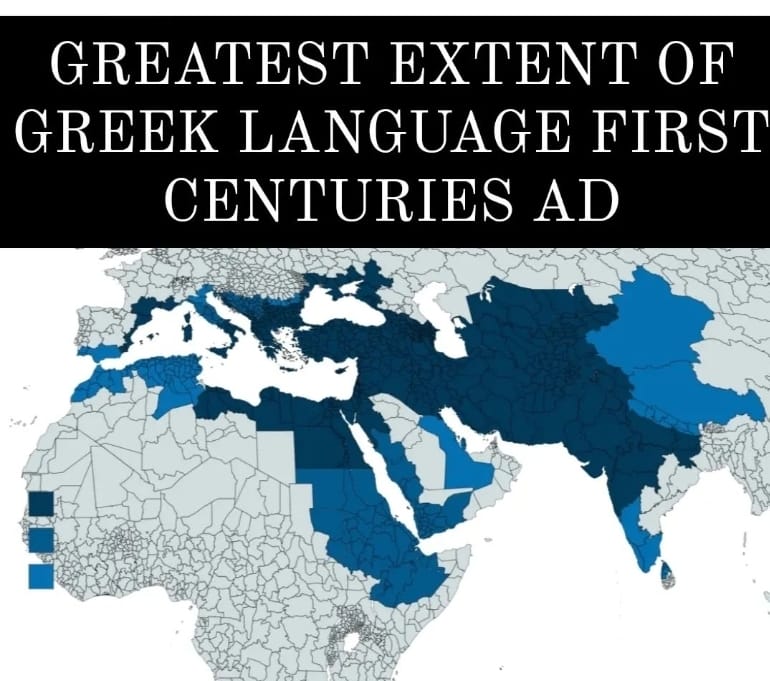
Ainsi que nous l’avons documenté par ailleurs, l’Asie centrale, et l’Afghanistan en particulier, furent le lieu de rencontre entre les civilisations perses, chinoises, grecques et indiennes.
C’est au Gandhara, région à cheval entre le Pakistan et l’Afghanistan, au cœur des Routes de la soie, que le bouddhisme prendra à deux reprises un envol majeur, donnant naissance à un art dit « gréco-bouddhiste », qui parviendra à faire la synthèse entre plusieurs cultures à travers des œuvres d’une beauté incomparable.

Les premiers Grecs commencèrent à s’installer dans la partie nord-ouest du sous-continent indien à l’époque de l’Empire perse achéménide. Après avoir conquis la région, le roi perse Darius le Grand (521 – 486 av. J.-C.) colonisa également une grande partie du monde grec, qui comprenait à l’époque toute la péninsule anatolienne occidentale.
Lorsque des villages grecs se rebellaient sous le joug perse, ils faisaient parfois l’objet d’un nettoyage ethnique et leurs populations étaient déportées à l’autre bout de l’empire.
C’est ainsi que de nombreuses communautés grecques virent le jour dans les régions indiennes les plus reculées de l’empire perse.
Au IVe siècle avant J.-C., Alexandre le Grand (356 – 323 av. J.-C.) vainquit et conquit l’empire perse. En 326 avant J.-C., cet empire comprenait la partie nord-ouest du sous-continent indien jusqu’à la rivière Beas (que les Grecs nommaient l’Hyphase). Alexandre établit des satrapies et fonde plusieurs colonies. Il se tourne vers le sud lorsque ses troupes, conscientes de l’immensité de l’Inde, refusent de pousser plus loin encore vers l’est.
Après sa mort, son empire se délite. De 180 av. J.-C. à environ l’an 10 de notre ère, plus de trente rois hellénistiques se succèdent, souvent en conflit entre eux. Cette époque est connue dans l’histoire sous le nom des « Royaumes indo-grecs ».
L’un d’eux a été fondé lorsque le roi gréco-bactrien Démétrius envahit l’Inde en 180 avant notre ère, créant ainsi une entité faisant sécession avec le puissant royaume gréco-bactrien, la Bactriane (comprenant notamment le nord de l’Afghanistan, une partie de l’Ouzbékistan, etc.).
Pendant les deux siècles de leur règne, ces rois indo-grecs intégrèrent dans une seule culture des langues et des symboles grecs et indiens, comme en témoignent leurs pièces de monnaie, et mêlèrent les anciennes pratiques religieuses grecques, hindoues et bouddhistes, comme le montrent les vestiges archéologiques de leurs villes et les signes de leur soutien au bouddhisme.
L’Empire Maurya
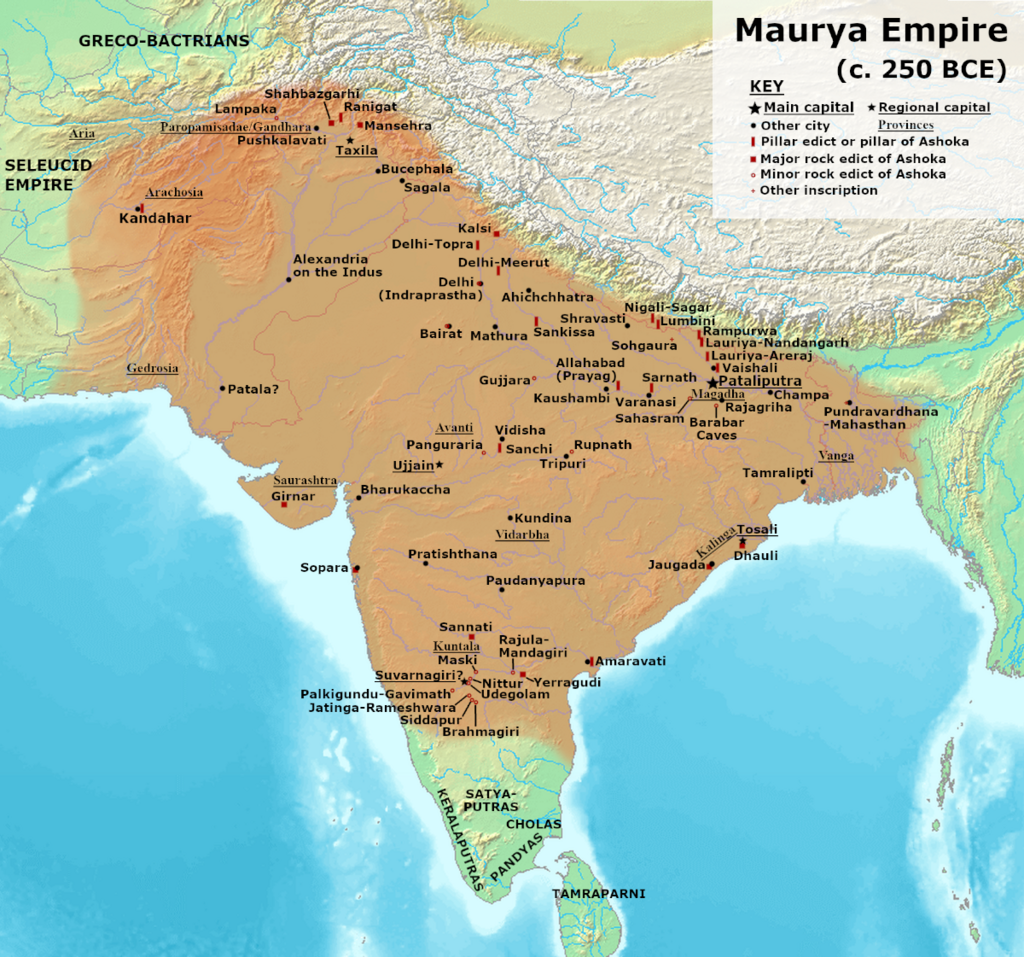
Vers 322 avant J.-C., les Grecs appelés Yona (Ioniens) ou Yavana dans les sources indiennes, participent, avec d’autres populations, au soulèvement de Chandragupta Maurya (né v. -340 et mort v. – 297), le fondateur de l’Empire maurya.
Le règne de Chandragupta ouvre une ère de prospérité économique, de réformes, d’expansion des infrastructures et de tolérance. De nombreuses religions ont ainsi prospéré dans son royaume et dans l’empire de ses descendants. Bouddhisme, jaïnisme et ajivika prennent de l’importance aux côtés des traditions védiques et brahmaniques, tout en respectant les religions minoritaires telles que le zoroastrisme et le panthéon grec.
Le règne d’Ashoka le Grand
(de 268 à 231 av. JC)
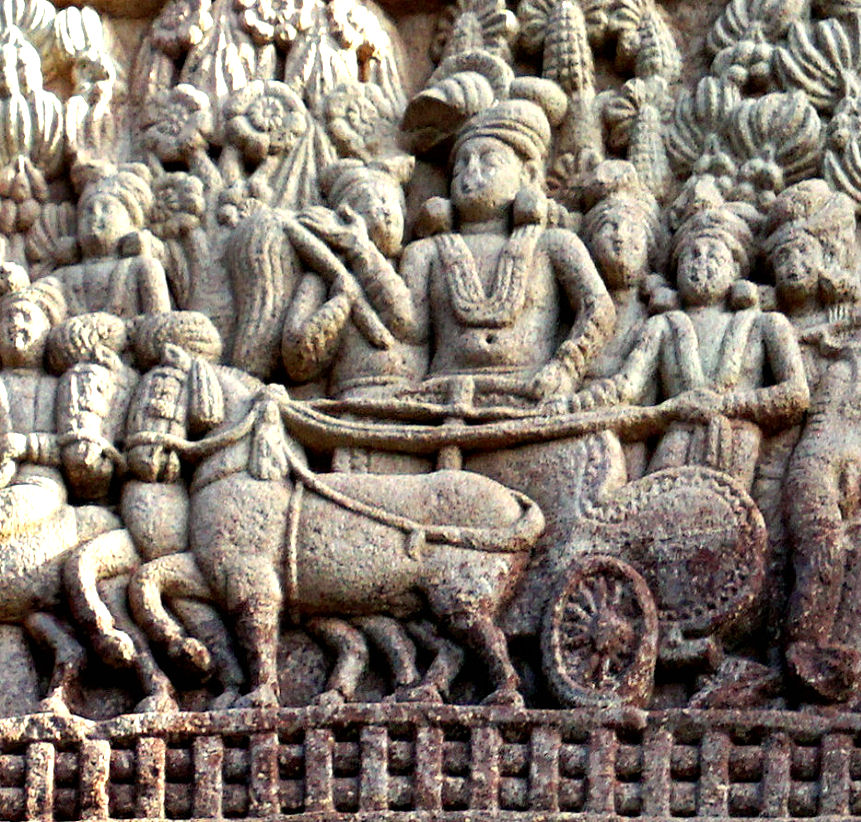
L’Empire Maurya atteint son apogée sous le règne du petit-fils de Chandragupta, Ashoka le Grand, de 268 à 231 av. J.-C. (parfois écrit Asoka).
Huit ans après sa prise de pouvoir, Ashoka mène une campagne militaire pour conquérir le Kalinga, un vaste royaume côtier du centre-est de l’Inde. Sa victoire lui permet de conquérir un territoire plus vaste que celui de tous ses prédécesseurs. Grâce aux conquêtes d’Ashoka, l’Empire Maurya devient une puissance centralisée couvrant une grande partie du sous-continent indien, s’étendant de l’actuel Afghanistan à l’ouest à l’actuel Bangladesh à l’est, avec sa capitale à Pataliputra (proche de l’actuelle Patna en Inde).
Alors que l’Empire Maurya avait existé dans un certain désordre jusqu’en 185 av. J.-C., Ashoka va transformer le royaume en recourant à une violence extrême qui caractérise le début de son règne. On parle de 100 000 à 300 000 morts, rien que lors de la conquête du Kalinga !
Mais le poids d’un tel carnage plonge le roi dans une grave crise personnelle. Ashoka est gravement choqué par la multitude de vies arrachées par ses armées. L’édit N° 13 d’Ashoka reflète le profond remords ressenti par le roi après avoir observé la destruction de Kalinga :
« Sa Majesté a éprouvé des remords à cause de la conquête de Kalinga car, lors de l’assujettissement d’un pays non conquis auparavant, il y a nécessairement des massacres, des morts et des captifs, et Sa Majesté en éprouve une profonde tristesse et un grand regret. »
Ashoka renonce alors aux démonstrations de force militaires et autres formes de violence, y compris la cruauté envers les animaux. Conquis par le bouddhisme, il se consacre alors à répandre sa vision du dharma, une conduite juste et morale. Il va encourager la diffusion du bouddhisme dans toute l’Inde. Selon l’archéologue et érudit français François Foucher, même si les cas de mauvais traitements envers les animaux ne disparurent pas du jour au lendemain, la croyance en la fraternité de tous les êtres vivants est plus florissante en Inde que partout ailleurs.
En 250 avant J.-C., Ashoka convoque le troisième concile bouddhique. Les sources theravâda mentionnent qu’en plus de régler les différends intérieurs, la principale fonction du concile était de planifier l’envoi de missionnaires bouddhistes dans différents pays afin d’y répandre la doctrine.
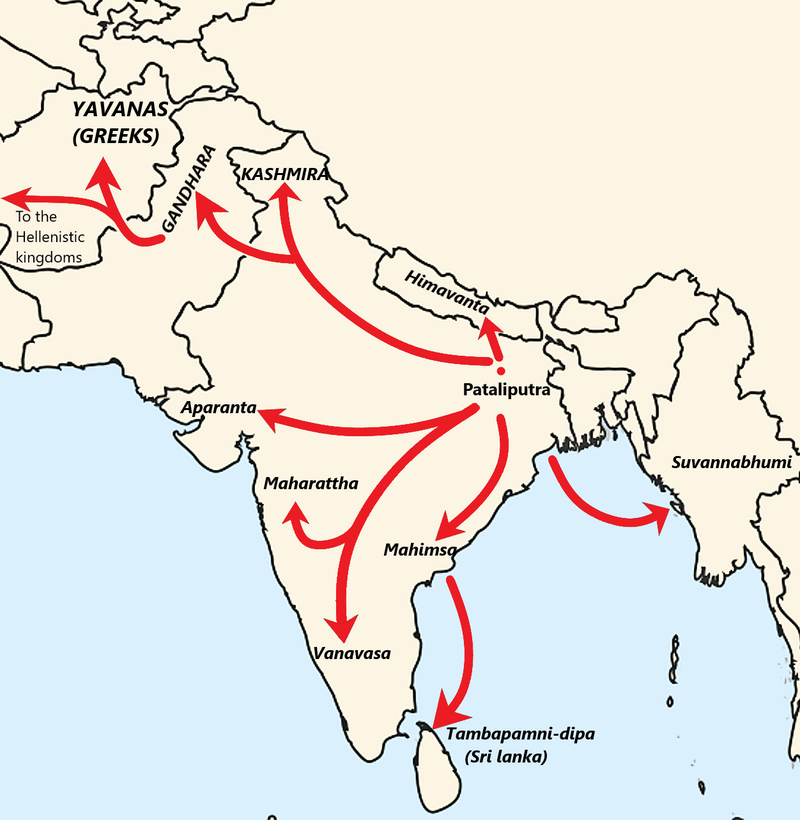
Ces missionnaires allèrent jusqu’aux royaumes hellénistiques de l’ouest, en commençant par la Bactriane voisine. Des missionnaires furent également envoyés en Inde du sud, au Sri Lanka et en Asie du Sud-Est (peut-être en Birmanie).
La forte implication de ces missions dans l’éclosion du bouddhisme en Asie à l’époque d’Ashoka est solidement étayée par des preuves archéologiques. Le bouddhisme ne s’est pas répandu par pur hasard, mais dans le cadre d’une opération politique créative, stimulante et bien planifiée, tout au long des Routes de la soie.
Le Mahavamsa ou Grande chronique (XII, 1er paragraphe), relatant l’histoire des rois cinghalais et tamouls de Ceylan (aujourd’hui Sri Lanka), donne la liste des missionnaires bouddhistes envoyés par le Concile et Ashoka :
- Le vieux Majjhantika prit la tête de la mission au Cachemire et au Gandhara (aujourd’hui le nord-ouest du Pakistan et l’Afghanistan) ;
- L’aîné Mahadeva dirigea la mission dans le sud-ouest de l’Inde (Mysore, Karnataka) ;
- Rakkhita, celle du sud-est de l’Inde (Tamil Nadu) ;
- Le vieux Yona (Ionien, Grec) Dharmaraksita partit vers Aparantaka (« frontière occidentale », comprenant le nord du Gujarat, le Kathiawar, le Kachch et le Sindh, toutes des parties de l’Inde à l’époque) ;
- L’aîné Mahadharmaraksita dirigea la mission de Maharattha (région péninsulaire occidentale de l’Inde) ;
- Maharakkhita (Maharaksita Thera) fut envoyé au pays des Yona (Ioniens), probablement la Bactriane et peut-être le royaume séleucide ;
- Majjhima Thera conduisit la mission dans la région d’Himavant (nord du Népal, contreforts de l’Himalaya) ;
- Sona Thera et Uttara Thera, celles de Suvannabhumi (quelque part en Asie du Sud-Est, peut-être au Myanmar ou en Thaïlande) ;
- Enfin, Mahinda, fils aîné d’Ashoka et donc le Prince de son royaume, accompagné de ses disciples Utthiya, Ittiya, Sambala et Bhaddasala, se rendit à Lankadipa (Sri Lanka).
Certaines de ces missions furent couronnées de succès, permettant d’implanter le bouddhisme en Afghanistan, au Gandhara et au Sri Lanka, par exemple.
Le bouddhisme gandharien, le gréco-bouddhisme et le bouddhisme cinghalais ont puissamment inspiré le développement du bouddhisme dans le reste de l’Asie, notamment en Chine, et ceci pendant des générations.
Si les missions dans les royaumes hellénistiques méditerranéens semblent avoir été moins fructueuses, il est possible que des communautés bouddhistes se soient établies pendant une période limitée dans l’Alexandrie égyptienne, ce qui pourrait être à l’origine de la secte dite des Therapeutae, mentionnée dans certaines sources anciennes comme Philon d’Alexandrie (v. 20 av. J.-C. – 50 apr. J.-C.).
Le courant juif des Esséniens et les Thérapeutes d’Alexandrie seraient des communautés fondées sur le modèle du monachisme bouddhique. « C’est l’Inde qui serait, selon nous, au départ de ce vaste courant monastique qui brilla d’un vif éclat durant environ trois siècles dans le judaïsme même », affirme l’historien français André Dupont-Sommer, et cette influence aurait même contribué, selon lui, à l’émergence du christianisme.
Edits d’Ashoka


Ashoka transmettait ses messages par le biais d’édits gravés sur des piliers et des rochers en divers lieux du royaume, proches des stupas, sur des lieux de pèlerinage et le long de routes commerciales très fréquentées.
Une trentaine d’entre eux ont été conservés. Ils sont souvent rédigés non pas en sanskrit, mais en grec (la langue du royaume gréco-bactrien voisin et des communautés grecques du royaume d’Ashoka), en araméen (langue officielle de l’ancien empire achéménide) ou en divers dialectes du prâkrit (une langue indo-aryenne moyenne), y compris le gândhârî ancien, langue parlée au Gandhara. (*3)
Ces édits utilisaient la langue pertinente pour la région. Par exemple, en Bactriane, ou les Grecs dominaient, on trouve près de l’actuelle Kandahar un édit rédigé uniquement en grec et en araméen.
Contenu des édits

Certains d’entre eux reflètent l’adhésion profonde d’Ashoka aux préceptes du bouddhisme et ses relations étroites avec le Sangha, l’ordre monastique bouddhiste. Il utilise également le terme spécifiquement bouddhiste de dharma pour désigner les qualités du cœur qui sous-tendent l’action morale.
Dans son édit mineur sur rocher N° 1, le roi se déclare « adepte laïc de l’enseignement du Bouddha depuis plus de deux ans et demi », mais avoue que jusqu’ici, il n’a « pas fait grand progrès ». « Depuis un peu plus d’un an, je me suis rapproché de l’Ordre », ajoute-t-il.
Dans l’édit mineur sur rocher N° 3 de Calcutta-Bairat, il affirme : « Tout ce qui a été dit par le Bouddha a été bien dit », décrivant les enseignements du Bouddha comme le véritable dharma.
Ashoka a reconnu les liens étroits entre l’individu, la société, le roi et l’État. Son dharma peut être compris comme la moralité, la bonté ou la vertu, et l’impératif de le poursuivre lui a donné le sens du devoir. Les inscriptions expliquent que le dharma intègre la maîtrise de soi, la pureté de la pensée, la libéralité, la gratitude, la dévotion ferme, la véracité, la protection de la parole et la modération dans les dépenses et les possessions.
Le dharma a également un aspect social. Il comprend l’obéissance aux parents, le respect des aînés, la courtoisie et la libéralité envers les adorateurs de Brahma, la courtoisie envers les esclaves et les serviteurs, et la libéralité envers les amis, les connaissances et les parents.
La non-violence, qui consiste à s’abstenir de blesser ou de tuer tout être vivant, était un aspect important du dharma d’Ashoka. Ne tuer aucun être vivant est décrit comme faisant partie du bien (Édit mineur sur rocher N° 11), de même que la douceur à leur égard (Édit mineur sur rocher N° 9). L’accent mis sur la non-violence s’accompagne de l’incitation à une attitude positive d’attention, de douceur et de compassion.
Ashoka adopte et préconise une politique fondée sur le respect et la tolérance des autres religions. L’un de ses édits préconise :
« Tous les hommes sont mes enfants. A mes enfants, je souhaite prospérité et bonheur dans ce monde et dans l’autre ; mes vœux sont les mêmes pour tous les hommes. »
Loin d’être sectaire, Ashoka, s’appuyant sur la conviction que toutes les religions partagent une essence commune et positive, encourage la tolérance et la compréhension des autres religions :
« Le bien-aimé des dieux, le roi Piyadassi (c’est-à-dire Ashoka), souhaite que toutes les sectes puissent habiter en tous lieux, car toutes recherchent la maîtrise de soi et la pureté de l’esprit. » (Édit majeur sur rocher N° 7)
Et il précise :
« Car quiconque loue sa propre secte ou blâme les autres sectes, –par pure dévotion à sa propre secte, dans le simple but de la glorifier, – en agissant ainsi, il porte au contraire gravement préjudice à sa propre secte. Mais la concorde est méritoire, (c’est-à-dire) que tous doivent écouter et obéir à la morale de l’autre. » (Édit majeur sur rocher N° 12)
Ashoka avait l’idée d’un empire politique et d’un empire moral, le second englobant le premier. Sa conception de sa circonscription s’étendait au-delà de ses sujets politiques pour inclure tous les êtres vivants, humains et animaux, vivant à l’intérieur comme à l’extérieur de son domaine politique. Ses inscriptions expriment sa conception paternelle de la royauté et décrivent ses mesures d’aide sociale, notamment la fourniture de traitements médicaux, la plantation d’herbes, d’arbres et de racines pour les hommes et les animaux, et le creusement de puits le long des routes (Edit majeur sur rocher N°2). Les efforts du roi pour propager son dharma ne se limitaient pas à son propre domaine politique, mais s’étendaient aux royaumes des autres souverains.
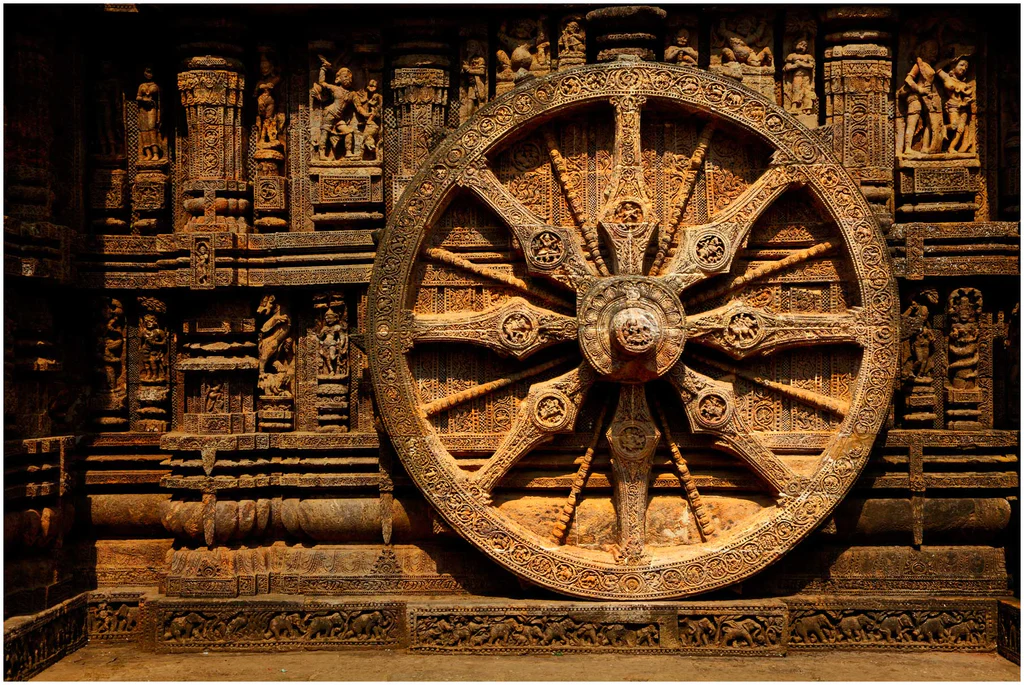
L’empereur est devenu un sage. Il dirige un gouvernement centralisé depuis Pataliputra, capitale de l’Empire Maurya. Son administration perçoit des impôts et il demande à ses inspecteurs de lui rendre des comptes. L’agriculture se développe grâce à des canaux d’irrigation. Il fait construire des routes de qualité pour relier les points stratégiques et les centres politiques, exigeant, des siècles avant notre grand Sully en France, qu’elles soient bordées d’arbres d’ombrage, de puits et d’auberges.
Si l’existence même d’Ashoka en tant que personnage historique a été quasiment oubliée, depuis le déchiffrement de sources écrites en brahmi au XIXe siècle, il est désormais considéré comme l’un des plus grands empereurs indiens. La roue bouddhiste d’Ashoka figure d’ailleurs sur le drapeau indien.
Comme nous l’avons déjà dit, Ashoka et ses descendants ont utilisé leur pouvoir pour construire des monastères et répandre l’influence bouddhiste en Afghanistan, dans de vastes régions de l’Asie centrale, au Sri Lanka et, au-delà, en Thaïlande, Birmanie, Indonésie, puis en Chine, en Corée et au Japon.
Des statues en bronze de son époque ont été déterrées dans les jungles d’Annam, de Bornéo et des Célèbes. La culture bouddhiste s’est implantée dans l’ensemble de l’Asie du Sud-Est, même si chaque région a su conserver une partie de sa personnalité et de son caractère propres.
L’Empire Kouchan
(du Ier siècle av. JC au IIIe siècle)
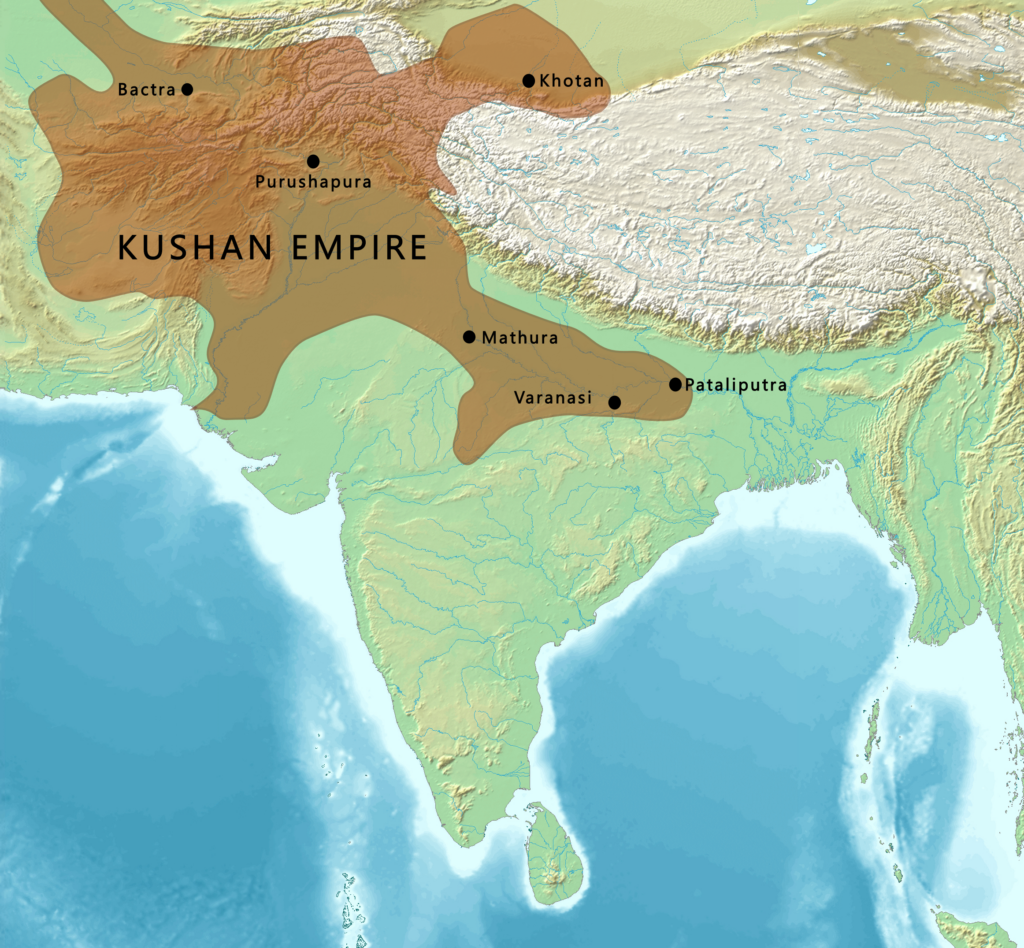
L’Empire Maurya, qui régnait sur la Bactriane et d’autres anciennes satrapies grecques, s’effondra en 185 avant J.-C., à peine cinq décennies après la mort d’Ashoka, accusé d’avoir trop dépensé pour les temples et les missions bouddhistes. Les mafias brahmaniques, qui avaient abhorré son règne, revinrent immédiatement au pouvoir.
Mais la période est turbulente. Au premier siècle avant J.C., les Kouchans, l’une des cinq branches de la confédération nomade chinoise Yuezhi, émigrent du nord-ouest de la Chine (Xinjiang et Gansu) et s’emparent, après les nomades iraniens Saka, de l’ancienne Bactriane.
Ils forment l’Empire kouchan dans les territoires de la Bactriane. Cet empire s’étend assez vite à une grande partie de ce qui est aujourd’hui l’Ouzbékistan, l’Afghanistan, le Pakistan et le nord de l’Inde, au moins jusqu’à Saketa et Sarnath, près de la ville de Varanasi (Bénarès).

Le fondateur de la dynastie kouchane, Kujula Kadphisès, qui suit les idées culturelles et l’iconographie grecques après la tradition gréco-bactrienne, est un adepte de la secte shivaïte de l’hindouisme. Deux rois kouchans ultérieurs, Vima Kadphisès et Vasudeva II, furent également des mécènes de l’hindouisme et du bouddhisme. La patrie de leur empire se trouvait en Bactriane, où le grec était initialement la langue administrative, avant d’être remplacé par le bactrien écrit en caractères grecs jusqu’au VIIIe siècle, lorsque l’islam le remplace par l’arabe.

Les Kouchans devinrent également de grands mécènes du bouddhisme, en particulier l’empereur Kanishka le Grand (78-144 après J.-C.), qui joua un rôle important dans sa diffusion, via les Routes de la soie, vers l’Asie centrale et la Chine, inaugurant une période de paix relative de 200 ans, parfois décrite comme la « Pax Kouchana ».
Il semble également que dès ses débuts, le bouddhisme ait prospéré dans la classe des marchands, à qui la naissance interdisait l’accès aux ordres religieux de l’Inde et de l’Himalaya. La pensée et l’art bouddhistes se développèrent grâce aux routes commerciales entre l’Inde, l’Himalaya, l’Asie centrale, la Chine, la Perse, l’Asie du Sud-Est et l’Occident. Les voyageurs recherchaient la protection des images bouddhistes et faisaient des offrandes aux sanctuaires le long de la route, ramassant des objets et des sanctuaires portables pour leur usage personnel.
Le terme quatrième concile bouddhiste désigne deux évènements différents selon les écoles theravâda et mahâyâna.
1) La tradition theravâda : afin d’éviter que ne se perde l’enseignement du Bouddha, qui se serait jusqu’alors transmis oralement, cinq cents moines menés par le Vénérable Maharakkhita se réunirent à Tambapanni (Sri Lanka), sous le patronage du roi Vattagamani (r. 103 – 77 av. J.-C.) afin de coucher par écrit sur des feuilles de palme le Canon pâli. (*4)
Le travail, qui aurait duré trois ans, se serait déroulé dans la grotte Aloka lena, près de l’actuel Matale.
2) Selon la tradition mahâyâna, c’est 400 ans après l’extinction du Bouddha que cinq cents moines sarvastivadin se réunirent en 72 après J.-C. au Cachemire pour compiler et clarifier leurs doctrines sous la direction de Vasumitra et sous le patronage personnel de l’empereur Kanishka. Ils auraient ainsi produit le Mahavibhasa (Grande exégèse) en sanskrit.
Selon plusieurs sources, le moine bouddhiste indien Asvaghosa, considéré comme le premier dramaturge classique sanskrit et dont nous avons évoqué plus haut les attaques contre le système des castes, était le conseiller spirituel du roi Kanishka dans les dernières années de sa vie.
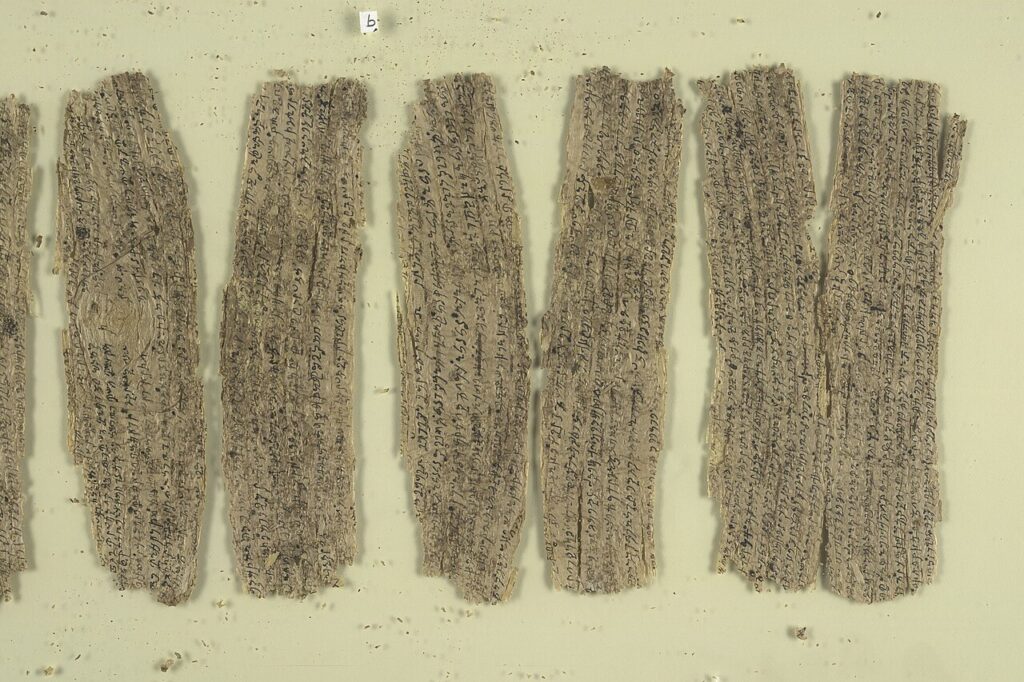
A noter que les plus anciens manuscrits bouddhiques découverts à ce jour, tels que les vingt-sept rouleaux d’écorce de bouleau acquis par la British Library en 1994 et datant du Ier siècle, ont été trouvés, non pas en Inde, mais enterrés dans les anciens monastères du Gandhara, la région centrale de l’empire maurya et kouchan, qui comprend les vallées de Peshawar et de Swat (Pakistan) et s’étend vers l’ouest jusqu’à la vallée de Kaboul en Afghanistan et vers le nord jusqu’à la chaîne du Karakoram
Ainsi, après le grand élan donné par le roi Ashoka le Grand, la culture du Gandhara connaîtra un second souffle sous le règne du roi kouchan Kanishka Ier.
Les villes de Begram, Taxila, Purushapura (aujourd’hui Peshawar) et Surkh Kotal atteignent alors des sommets de développement et de prospérité.
Le miracle de Gandhara

C’est peu dire que le Gandhara, surtout à l’époque kouchane, fut au cœur d’une véritable renaissance de la civilisation, avec une incroyable concentration de productions artistiques et une inventivité sans pareil. Si l’art bouddhiste était principalement centré sur les temples et les monastères, les objets de dévotion personnelle étaient très courants.
Grâce à l’art du Gandhara, le bouddhisme se mua en une grande force de beauté, d’harmonie et de paix, conquérant le monde.
Il favorisa alors une création artistique qui élève la pensée et la moralité en faisant appel à des paradoxes métaphoriques.
Les médiums et supports qui prévalent sont la peinture sur soie, les fresques, les livres illustrés et gravures, la broderie et autres arts du tissu, la sculpture (bois, métal, ivoire, pierre, jade) et l’architecture. Quelques exemples :
A. La poésie
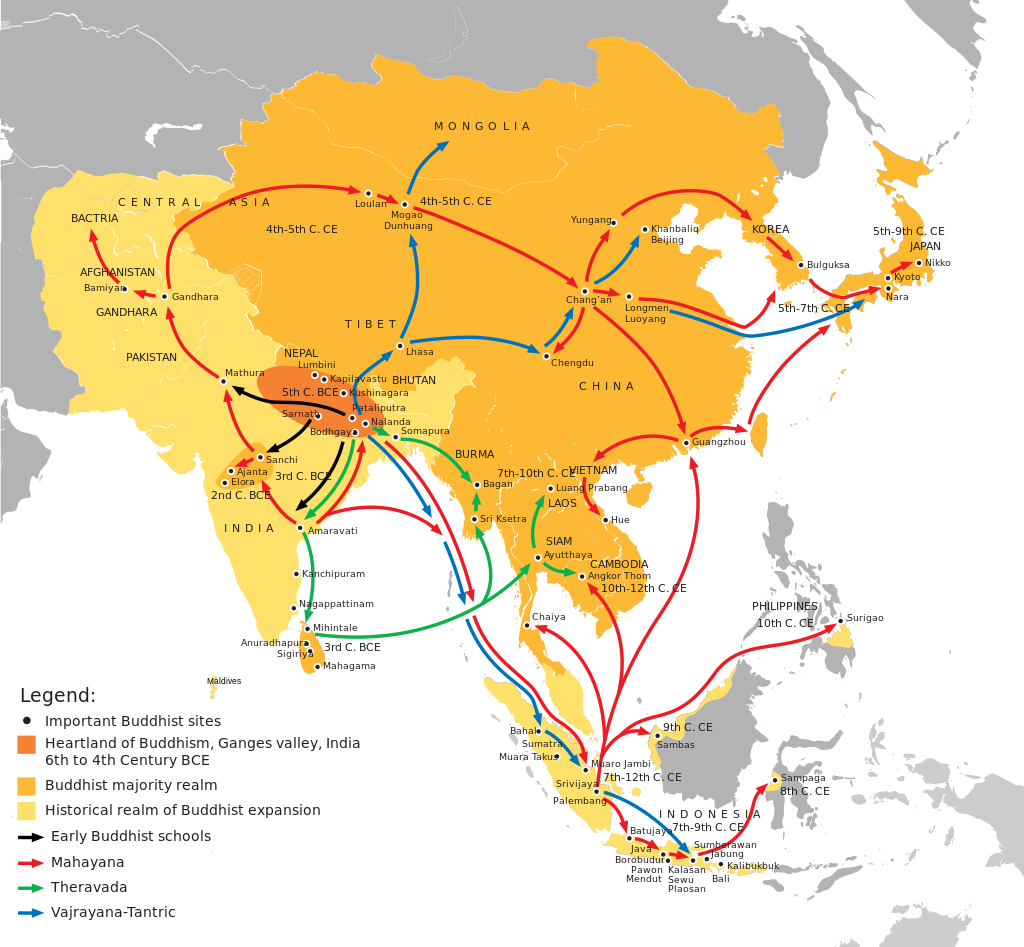
Pour la plupart des Occidentaux, le bouddhisme est une émanation typique de la culture asiatique, généralement associée à l’Inde, au Tibet, au Népal, mais aussi à la Chine et à l’Indonésie.
Peu de gens savent que les plus anciens manuscrits bouddhistes connus à ce jour (Ier siècle de notre ère) ont été découverts, non pas en Asie, mais en Asie centrale, dans d’anciens monastères bouddhistes du Gandhara.
A l’origine, avant leur transcription en sanskrit (pendant longtemps la langue des élites), ils étaient écrits en gândhârî, une langue indo-aryenne du groupe prâkrit, transcrit avec l’alphabet kharosthi (une ancienne écriture indo-iranienne). Le gândhârî était la lingua franca de la pensée bouddhiste à ses débuts. Preuve en est, les manuscrits bouddhistes écrits en gândhârî qui ont voyagé jusqu’en Chine orientale pour se retrouver dans les inscriptions de Luoyang et d’Anyang.
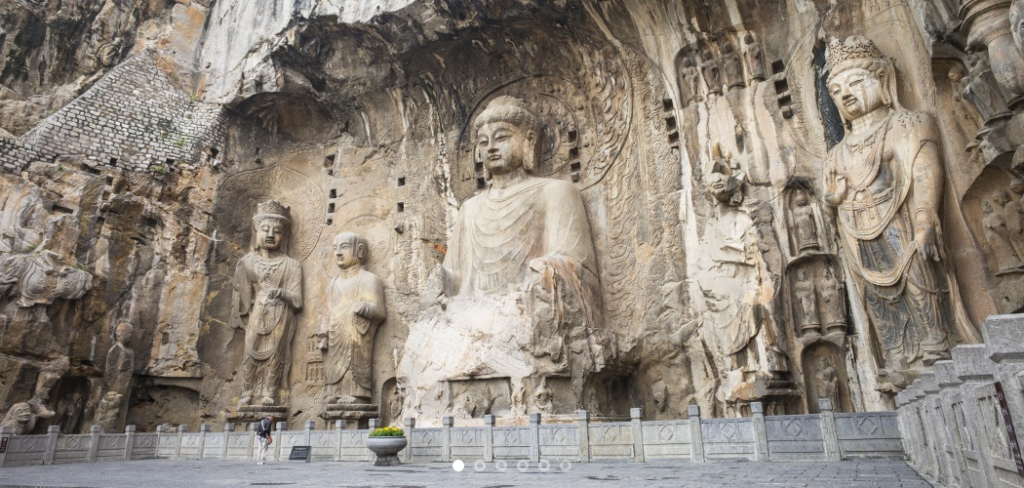
Afin de préserver leurs écrits, les bouddhistes étaient à l’avant-garde de l’adoption des technologies chinoises liées à la fabrication de livres, notamment le papier et la xylographie. Cette technique d’impression consiste à reproduire le texte à imprimer sur une feuille de papier transparente qui est retournée et gravée sur une planche de bois tendre. L’encrage des parties saillantes permet ensuite des tirages multiples. C’est ce qui explique que le premier livre entièrement imprimé est le Sutra du diamant bouddhique (vers 868) réalisé par ce procédé
Le Khaggavisana Sutta, littéralement « la corne du rhinocéros », est une expression authentique de la poésie religieuse bouddhiste originale. Connu sous le nom de Sutra du rhinocéros, cette œuvre poétique fait partie du recueil pâli de textes courts Kuddhhaka Nikava, la cinquième partie du Sutta Pitaka, écrit au Ier siècle de notre ère.
Parce que la tradition accorde au rhinocéros asiatique une vie solitaire dans la forêt, l’animal n’aime pas les troupeaux, ce sutra (enseignement) porte le titre approprié d’essai « sur la valeur de la vie solitaire et errante ». L’allégorie du rhinocéros permet de communiquer aux dévots un sens aigu de la souveraineté individuelle que requièrent les engagements moraux prescrits par le Bouddha pour mettre fin à la souffrance en se déconnectant des plaisirs et des douleurs terrestres.

Extrait :
Refuser la violence à l’égard de tous les êtres,
ne jamais faire de mal à un seul d’entre eux,
aider avec compassion et un cœur aimant ;
erre seul comme un rhinocéros.
Celui qui tient compagnie nourrit l’affection
et de l’affection naît la souffrance.
Réalisant le danger qui découle de l’affection,
erre seul comme un rhinocéros.
En sympathisant avec les amis et les compagnons,
l’esprit se fixe sur eux et perd son chemin.
Percevoir ce danger, c’est la familiarité,
erre seul comme un rhinocéros.
Les préoccupations que l’on a pour ses fils et ses femmes
sont comme une pensée et un bambou enchevêtré.
Reste démêlé comme un jeune bambou,
erre seul comme un rhinocéros.
Comme un cerf qui erre librement dans la forêt,
va où il veut en broutant,
un homme sage, qui chérit sa liberté,
erre seul comme le rhinocéros.
Laissez derrière vous vos fils, vos femmes et votre argent,
tous vos biens, vos parents et vos amis.
Abandonnez tous vos désirs, quels qu’ils soient,
erre seul comme le rhinocéros. (…)
B. La littérature
Deux autres chefs-d’œuvre tirés du même recueil sont d’une part les célèbres Jataka (Récits des vies antérieures du Bouddha), et d’autre part, le Milindapanha (Les questions du roi Milinda).
Les Jataka, qui mettent en scène de nombreux animaux, montrent comment, avant la dernière incarnation humaine au cours de laquelle il atteignit le nirvana, le Bouddha lui-même s’était réincarné d’innombrables fois en animal (en diverses sortes de poissons, en crabe, coq, pivert, perdrix, francolin, caille, oie, pigeon, corbeau, zèbre, buffle, plusieurs fois en singe ou en éléphant, en antilope, cerf et cheval).
Et puisque c’est Bouddha qui est incarné dans cet animal, celui-ci a soudainement des propos d’une grande sagesse.
Mais en d’autres occasions, ce sont des personnages qui sont des animaux alors que notre Bodhisattva apparaît sous forme humaine. Ces contes sont souvent pimentés d’un humour piquant. On sait d’ailleurs qu’elles ont inspiré La Fontaine, qui a dû les entendre du docteur François Bernier, qui les avait lui-même apprises alors qu’il était médecin en Inde pendant huit ans.

Les questions du roi Milinda est un compte-rendu imagé, véritable dialogue platonicien entre le roi grec de Bactriane, Milinda (le Grec, Ménandre), qui régnait au Pendjab, et le sage bouddhiste Bhante Nagasena. Leur dialogue animé, dramatique et spirituel, éloquent et inspiré, explore les divers problèmes de la pensée et de la pratique bouddhistes du point de vue d’un intellectuel grec perspicace, à la fois perplexe et fasciné par la religion étrangement rationnelle qu’il découvre sur le sous-continent indien.
Par le biais de paradoxes, Nagasena amène le « rationaliste » grec à s’élever jusqu’à la dimension spirituelle, au-delà de la logique et de la simple rationalité. Car le nirvana, tout comme l’espace, n’a « pas de cause » formelle et, bien qu’il peut se produire, « ne peut pas être causé ». Mince, comment faire alors pour y aboutir ?
Et à l’un de ses disciples qui un jour lui posa la question de savoir si l’univers était fini ou infini, éternel ou non, si l’âme était distincte du corps, ce que devenait l’homme après la mort, le Bouddha répondit par une parabole :
« Supposons qu’un homme soit gravement atteint d’une flèche, que l’on l’amène chez un médecin, et que l’homme dise : “Je ne laisserai pas retirer cette flèche, avant de savoir qui m’a blessé, de quel caste il est, de quel village il est né, de quel arc il s’est servi, de quelle matière a été faite la flèche, de quelle direction elle a été tirée…” Alors cet homme mourrait certainement avant d’avoir les réponses. »
C. Urbanisme
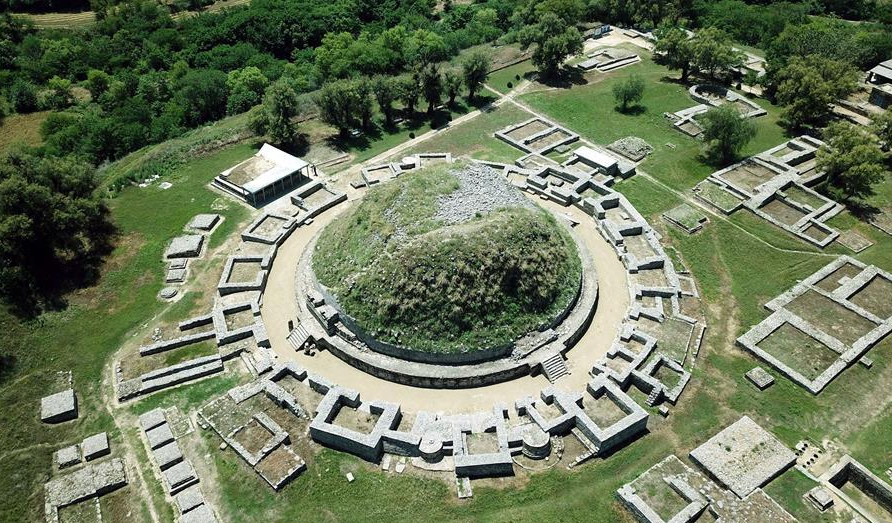
Taxila ou Takshashila (aujourd’hui au Pendjab), l’un des grands centres urbains et, pendant un certain temps, la capitale du Gandhara, fut fondée vers 1000 avant J.-C. sur les ruines d’une cité datant de la période Harappa et située sur la rive orientale de l’Indus, point de jonction entre le sous-continent indien et l’Asie centrale.
Certaines ruines de Taxila datent de l’époque de l’empire perse achéménide, suivi successivement par l’Empire Maurya, le royaume indo-grec, les Indo-Scythes et l’empire kouchan.
D’après certains témoignages, l’université de l’ancienne Taxila (des siècles avant l’université bouddhiste résidentielle de Nalanda fondée en 427 après J.-C.) peut être considérée comme l’un des premiers centres d’enseignement d’Asie du Sud. Dès 800 av. J.-C., la ville fonctionnait en grande partie comme une université, offrant des études supérieures. Avant d’y être admis, les étudiants devaient avoir terminé ailleurs leurs études primaires et secondaires. L’âge minimum requis était de seize ans. Non seulement les Indiens, mais aussi les étudiants de contrées voisines comme la Chine, la Grèce et l’Arabie affluaient dans cette ville d’apprentissage.
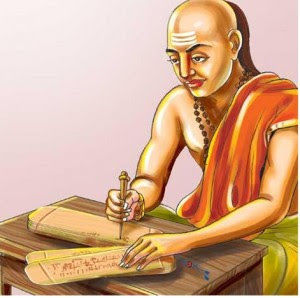
Vers 321 avant J.-C., c’est le grand philosophe, enseignant et économiste du Gandhara, Chanakya (375 à 283 av. J.-C.) qui aida le premier empereur maurya, Chandragupta, à accéder au pouvoir.
Sous la tutelle de Chanakya, Chandragupta avait reçu une éducation complète à Taxila, englobant les différents arts de l’époque, y compris l’art de la guerre, pendant sept à huit ans.
En 303 avant J.-C., Taxila tomba entre leurs mains et sous Ashoka le Grand, le petit-fils de Chandragupta, la ville devint un grand centre de l’enseignement et de l’art bouddhiste.
Chanakya, dont les écrits n’ont été redécouverts qu’au début du XXe siècle et qui fut le principal conseiller des deux empereurs Chandragupta et de son fils Bindusara, est considéré comme ayant joué un rôle majeur dans l’établissement de l’Empire Maurya.
Également connu sous les noms de Kauṭilya et Vishnugupta, Chanakya est l’auteur de l’Arthashastra, un traité politique sanskrit sur l’art de gouverner, la science politique, la politique économique et la stratégie militaire. L’Arthashastra aborde également la question d’une éthique collective assurant la cohésion de la société.
Il conseille au roi de lancer de grands projets de travaux publics dans les régions dévastées par la famine, les épidémies et autres catastrophes naturelles, ou par la guerre, tels que la création de voies d’irrigation et la construction de forts autour des principaux centres de production et villes stratégiques, et d’exonérer d’impôts les personnes touchées par ces catastrophes.

Au IIe siècle avant notre ère, Taxila fut annexée par le royaume indo-grec de Bactriane qui y érigea une nouvelle capitale nommée Sirkap, où des temples bouddhistes côtoyaient des temples hindous et grecs, signe de tolérance religieuse et de syncrétisme. Sirkap fut construite selon le plan quadrillé hippodamien (*5) caractéristique des villes grecques
Elle s’organise autour d’une avenue principale et de quinze rues perpendiculaires, couvrant une surface d’environ 1200 mètres sur 400, avec un mur d’enceinte de 5 à 7 mètres de large et de 4,8 kilomètres de long.
Après sa construction par les Grecs, la ville fut reconstruite lors des incursions des Indo-Scythes, puis par les Indo-Parthiens, après un tremblement de terre en l’an 30 de notre ère.
Certaines parties de la ville, notamment le stupa (reliquaire) bouddhiste de l’aigle bicéphale et le temple du dieu Soleil, furent construites par Gondophares, le premier roi du royaume indo-parthien. Enfin, des inscriptions datant de l’an 76 de notre ère démontrent que la ville était déjà passée sous la domination des Kouchans. Le souverain kouchan Kanishka érigera Sirsukh, à environ 1,5 km au nord-est de l’ancienne Taxila.
Des sutras bouddhistes de la région du Gandhara sont étudiés en Chine dès 147 de notre ère, lorsque le moine kouchan Lokakṣema (né en 147) commença à traduire en chinois certains des premiers sutras bouddhistes. Les plus anciennes de ces traductions montrent qu’elles ont été faites à partir de la langue
D. Architecture, l’invention des stupas
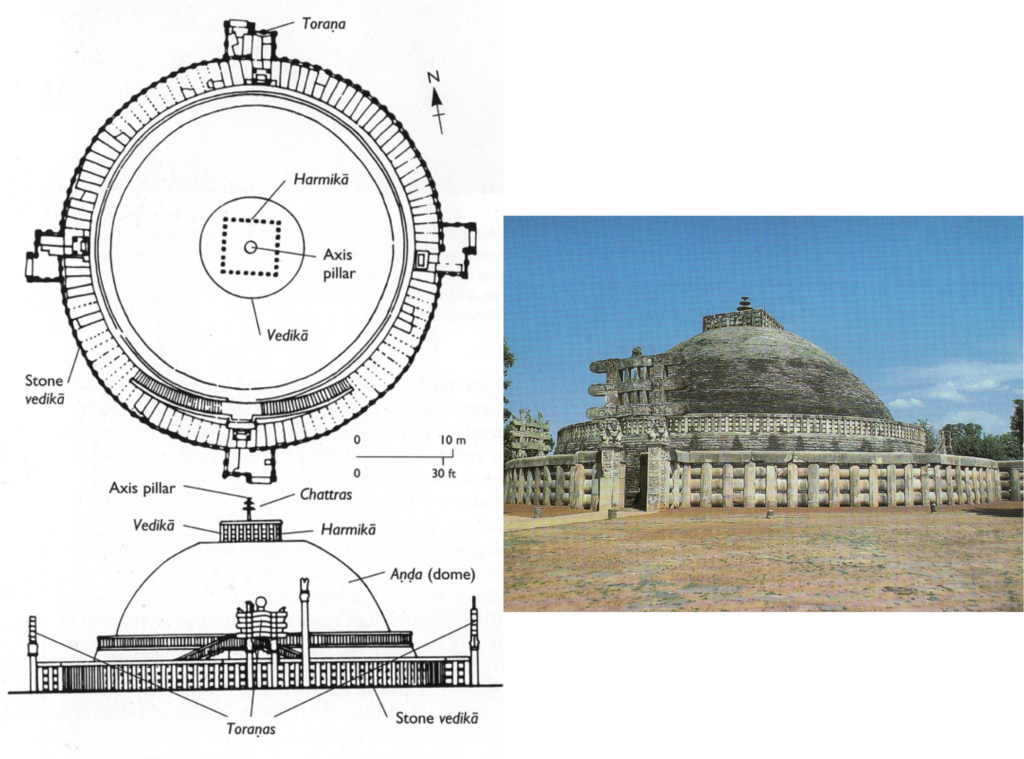
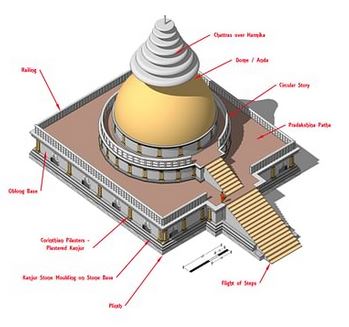
A l’origine, les édifices religieux sous forme de stupa (reliquaire) ont été érigés en Inde comme monuments commémoratifs associés à la conservation des reliques sacrées du Bouddha.
Construits en forme de dôme, ils sont entourés d’une balustrade qui sert de rampe pour la circumambulation rituelle. On accède à la zone sacrée par des portes situées aux quatre points cardinaux. Les stupas se situent souvent à proximité de sites funéraires préhistoriques beaucoup plus anciens, associés notamment à la Civilisation de la vallée de l’Indus.

Des grilles et des portails en pierre, recouverts de sculptures, leur ont été ajoutés. Les thèmes favoris sont les événements de la vie historique du Bouddha, ainsi que de ses vies antérieures, au nombre de 550, décrites avec beaucoup d’ironie dans les Jatakas. (Voir B)

Les bas-reliefs des stupas sont comme des bandes dessinées qui nous racontent la vie quotidienne et religieuse du Gandhara : amphores, coupes à vin (kantaros), bacchanales, instruments de musique, vêtements grecs ou indiens, ornements, coiffures arrangées à la grecque, artisans, leurs outils, etc.
Sur un vase trouvé à l’intérieur d’un stupa, on trouve l’inscription d’un Grec, Théodore, gouverneur civil d’une province au Ier siècle avant J.-C., expliquant en alphabet kharosthi comment les reliques ont été déposées dans le stupa.
On pense que de nombreux stupas datent de l’époque d’Ashoka, comme celui de Sanchi (Inde centrale) ou de Kesariya (Inde de l’Est), où il a également érigé des piliers avec ses édits, et peut-être ceux de Bharhut (Inde centrale), Amaravati (sud-est de l’Inde) ou Dharmarajika (Taxila) dans le Gandhara (Pakistan).
Selon la tradition bouddhiste, l’empereur Ashoka aurait récupéré les reliques du Bouddha dans des stupas plus anciens et en aurait fait ériger 84 000 pour répartir l’ensemble de ces reliques sur tout le territoire indien.
Marchant dans les pas d’Ashoka, Kanishka ordonna la construction à Purushapura (Peshawar) du grand stupa de 400 pieds qui figure parmi les plus hauts édifices du monde antique.

Les archéologues qui en ont redécouvert la base en 1908-1909 ont estimé que ce stupa avait un diamètre de 87 mètres. Selon les rapports de pèlerins chinois tels que Xuanzang, il faisait environ 200 mètres de haut et était recouvert de pierres précieuses. Sous les Kouchans également, d’immenses statues du Bouddha furent érigées dans les monastères ou sculptées à flanc de colline.
E. Sculpture
—PERIODE ANICONIQUE
Il est important de rappeler que dans les premiers temps, Bouddha n’était jamais représenté sous forme humaine.

Pendant plus de quatre siècles, sa présence est simplement suggérée par des éléments symboliques tel qu’une empreinte de pieds, une fleur de lotus (indiquant la pureté de sa naissance), une roue à huit rayons (symbolisant la dharma), un trône vide, un espace inoccupé sous un parasol, un cheval sans cavalier ou encore le figuier sous lequel il a atteint le nirvana.
–FIN DE L’ANICONISME
Ce qui a conduit les bouddhistes à renoncer aux représentations aniconiques reste un vaste mystère. Un tel développement est assez unique dans l’histoire des religions. Imaginons soudainement les musulmans promouvant des statues du prophète Mohammed !
Les explications avancées jusqu’ici nous laissent sur la faim.
Pour les uns, les bouddhistes auraient voulu séduire une clientèle grecque, mais aussi bien les populations grecques que le bouddhisme était au Gandhara bien avant la révolution iconographique en question.
Pour les autres, les pratiquants, en l’absence de Bouddha lui-même, auraient cherché désespérément un centre d’intérêt visuel, soit une statue, une peinture ou mêmes quelques cheveux… Ces représentations symboliques, on l’a vu, répondaient à cette demande.
« Le Jataka de Kalingabodhi (écrit majeur sur les vies multiples de Bouddha) relate la frustration des habitants de Sravasti, en découvrant un jour qu’ils n’ont personne à vénérer lorsqu’ils se rendent au Jetavana et trouvent le Bouddha ‘absent’, parti en voyage. Pour remédier à cette situation, à son retour, le Bouddha permet à [son disciple] Ananda de planter un figuier Bodhi devant le [monastère de] Jetavana (…) qui sert de centre de substitution pour les dévotions des gens, chaque fois que le Bouddha n’est pas en résidence », écrit John Strong, dans Reliques du Bouddha.
Bouddha, rapporte-t-on, aurait refusé qu’il soit représenté d’aucune façon, craignant de voir prospérer l’idolâtrie.
Avec le temps, le bouddhisme va évoluer. Au Gandhara, c’est le bouddhisme mahâyâna (Grand Véhicule) qui s’épanouit. Pour ce courant, l’objectif ne se limite plus à atteindre le nirvana à titre personnel mais de libérer toute l’humanité de la souffrance.
Si pour le bouddhisme theravâda, Siddhartha Gautama n’était qu’un homme éclairé donnant l’exemple, pour le bouddhisme mahâyâna, il s’agit indubitablement, avec Bouddha, d’une tentative (réussie) de personnifier le dharma (la force spirituelle omniprésente, le principe ultime et suprême de la vie) dans la conception du premier de tous les bouddhas. Une sorte de Jésus, un dieu devenu homme pour ainsi dire…
Comme plus tard Jésus dans le christianisme à partir du Ve siècle, Bouddha pouvait dès lors être représenté sous une forme humaine.
Certains bouddhas du Gandhara représentent également des états d’âme spécifiques, tels que la sagesse, la tendresse et la compassion.
Contrairement à de nombreux artistes chrétiens chez nous, qui, conformément à la doxa, ont représenté le Christ souffrant sur la Croix (événement fondamental de la foi chrétienne), les artistes du Gandhara présentent Bouddha comme un être totalement détaché de la douleur humaine, regardant avec compassion l’humanité tout entière.
Le but étant d’éliminer la souffrance chez tous les hommes, la compassion n’est pas une notion passive chez les bouddhistes. Ce n’est pas seulement de l’empathie, mais plutôt un altruisme empathique qui s’efforce activement de libérer les autres de la souffrance, un acte de bienveillance empreinte à la fois de sagesse et d’amour.
DIFFERENCES DE FORME, DIFFERENCE DE CONTENU

Avant de discuter de leurs différences, pour faire simple, distinguons ici, parmi tant d’autres, quatre types de représentations de bouddha:
- L’école dite « greco-bouddhique » de Gandhara produite dans la région qui va de Hadda (Afghanistan) à Taxila (Pundjab) en passant par Peshawar (Pakistan);
- L’école dite « indo-bouddhique » de Mathura;
- L’école d’Andra Pradesh, au sud de l’Inde;
- L’école de la période Gupta (3e au 5e siècle).
1. Greco-Bouddhique au Gandhara
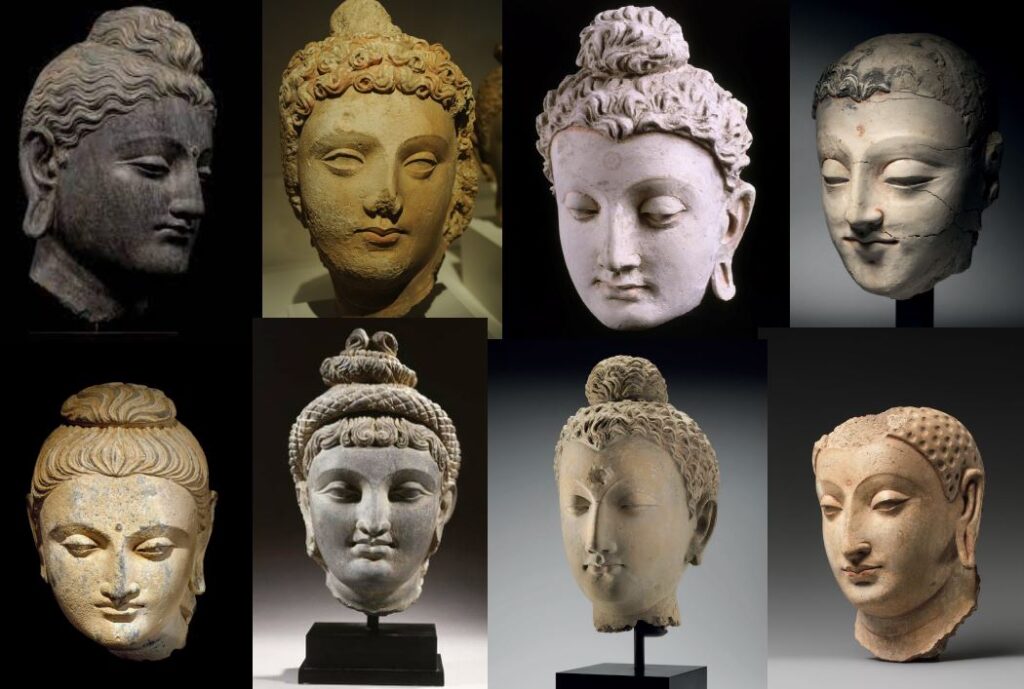
Le terme « greco-bouddhique », renvoie à la thèse de l’archéologue Alfred Foucher (1865-1952) soutenue à la Sorbonne en 1905 sur l’art du Gandhara.
Comme l’écrivait André Malraux (1901-1976) dans les « Voix du silence », en 1951, l’art gréco-bouddhique est cette rencontre entre hellénisme et bouddhisme. Au lieu de dire que l’art venu de Grèce s’était métamorphosé en art bouddhique comme le disait Malraux, je pense plutot qu’au Gandhara, c’est l’art bouddhique qui s’est approprié le meilleur de l’esthétique indienne, grecque et des steppes.
Cependant, Foucher avait raison d’insister, contre ses amis anglais, qu’il s’agit bien d’une influence hellénique et non pas romaine. De leur coté, avec l’Inde s’émancipant de l’Empire britannique, les savants indiens ont tenté de valider la thèse d’une création autochtone de l’image de Buddha, opposant au style du Gandhara, que Foucher voulait gréco-bouddhique, le style de Mathura, dans la région de Delhi, lui aussi englobé dans l’empire des Kouchans, et vu par certains comme contemporain, même s’il est beaucoup moins prolixe que l’art du Gandhara.

L’art du Gandhara prit véritablement son essor à l’époque kouchane, et plus particulièrement sous le règne du roi Kanishka.
Des milliers d’images furent produites et répandues dans tous les coins de la région, depuis les bouddhas portatifs jusqu’aux statues monumentales des lieux de culte sacrés.
Au Gandhara, pour figurer Bouddha, on représente d’une façon très réaliste une belle personne, souvent un jeune homme, voire une femme. La charge spirituelle est telle que le genre n’est plus essentiel. On ne sait pas s’il s’agit de beaux portraits pris sur le vif, ou de purs fruits de l’imagination des artistes.
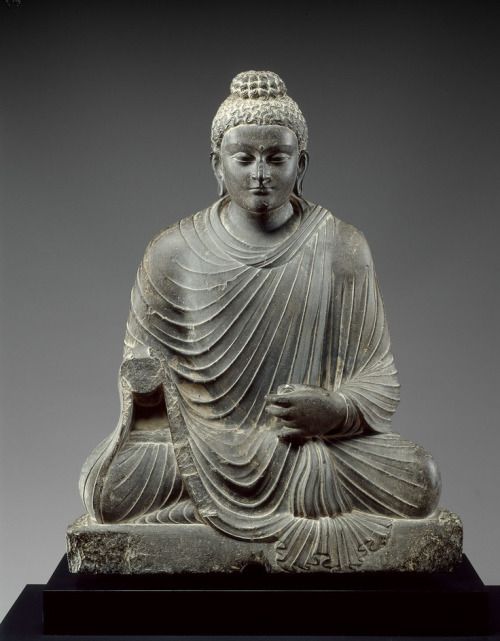

Bouddha y est souvent montré en posture méditative afin d’évoquer le moment où il atteint le nirvana.
Couronné d’une auréole, le visage grave ou souriant, les yeux mi-clos, il irradie la lumière. Plein de sérénité, il incarne le détachement, la concentration, la sagesse et la bienveillance.
Ses cheveux en chignon (l’ushnisha) au sommet du crâne indiquent qu’il est doué d’une connaissance supramondaine. Le point noire entre les deux yeux symbolise le troisième œil, celui de l’éveil.
Dans certaines sculptures, cette cavité contient une perle de cristal, symbole de lumière irradiante. Les lobes d’oreilles sont allongés et servent à accueillir les lourds bijoux que portait autrefois le jeune prince Siddhartha, durant sa jeunesse princière.
Le positionnement des mains, comme dans le reste de l’art indien, répond à des codes. Il peut s’agir de « l’abhayamudra », le geste qui rassure, la paume de la main tournée vers l’extérieur ; de la « varamudra », qui symbolise le don, la main pendante et ouverte avec le bras à demi plié, ou encore de la « vitarkamudra », qui symbolise l’argumentation, la main levée à hauteur de la poitrine, à demi fermée, paume en avant, l’index recourbé vers le pouce.
Au Gandhara, Bouddha est vêtu d’un manteau monastique qui lui couvre les deux épaules. L’étoffe n’est ni taillée, ni cousue, mais simplement drapée à la grecque autour du corps. Les plis à peine stylisés suivent les volumes naturels.
Le roi Kanitscha encouragea à la fois l’école d’art gréco-bouddhique du Gandhara (à Taxila, Peshawar et Hadda) et l’école indo-bouddhique (à Mathura, plus proche de l’Inde).
2. Ecole de Mathura


A Mathura, les artistes ont produit un Bouddha très différent. Son corps est dilaté par le souffle sacré (prana) et sa robe monastique est drapée à l’indienne de manière à laisser l’épaule droite dénudée.
On pense que les artistes, pour plaire à un public local, se sont inspirés des statues de yaksha, des esprits de la nature.
Dans les mythologies hindoue, jaïne et bouddhiste, le yakṣha a une double personnalité.
D’un côté, ce peut être une fée de nature inoffensive, associée aux forêts et aux montagnes ; mais il existe une version beaucoup plus sombre du yakṣa, qui est une sorte d’ogre, de fantôme ou de démon anthropophage qui harcèle et dévore les voyageurs.
3. Ecole d’Andrah Pradesh

Un troisième type de bouddha influent s’est développé dans l’Andhra Pradesh, au sud de l’Inde, où des représentations aux proportions imposantes, au visage grave, sans sourire, sont vêtues de robes qui laissent également apparaître l’épaule droite.
Ces sites méridionaux ont servi d’inspiration artistique à la terre bouddhiste du Sri Lanka, à la pointe sud de l’Inde, et les moines sri-lankais s’y rendaient régulièrement. Un certain nombre de statues de ce style se sont également répandues dans toute l’Asie du Sud-Est.
4. Ecole Gupta
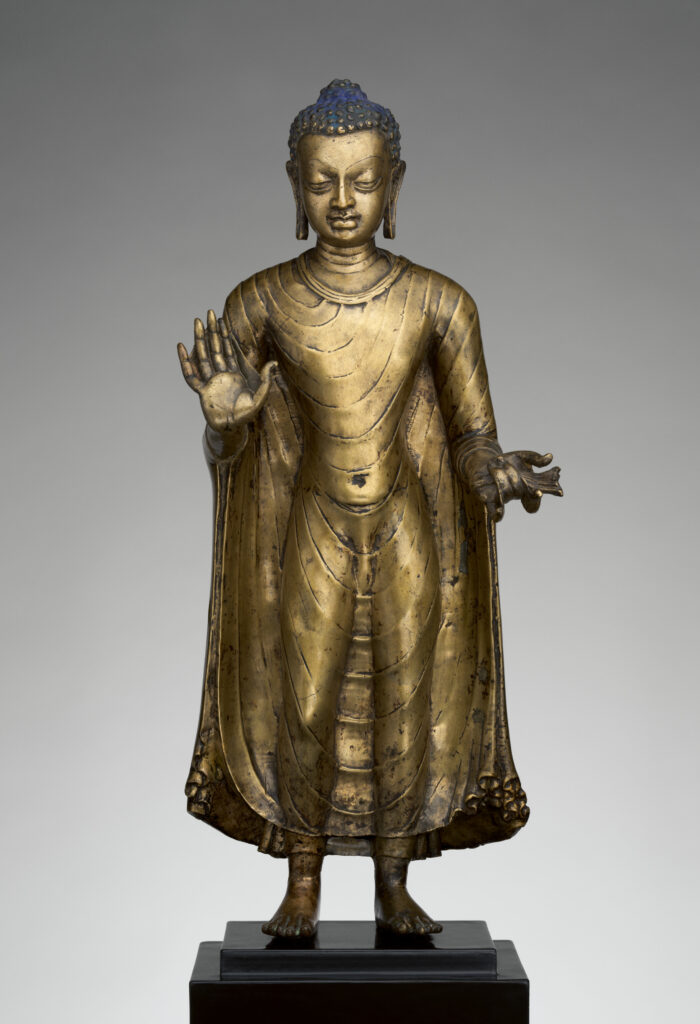
La période Gupta, du IVe au VIe siècle de notre ère, dans le nord de l’Inde, souvent qualifiée d’âge d’or, est supposée avoir synthétisé les deux courants. En réalité, en cherchant une image idéale, elle a sombré dans le maniérisme. Les bouddhas gupta ont les cheveux disposés en petites boucles individuelles et leur tunique arbore un réseau de cordelettes suggérant les plis des draperies (comme à Mathura).
Avec leurs yeux baissés et leur aura spirituelle, les bouddhas gupta deviendront le modèle des futures générations d’artistes, que ce soit dans l’Inde post-Gupta et Pala ou au Népal, en Thaïlande et en Indonésie.
Des statues métalliques gupta du Bouddha, emportées par les pèlerins, ont également été disséminées le long de la Route de la soie jusqu’en Chine.
Mais les Bouddhas du Gandhara sont uniques et vraiment à part. Ce sont de véritables individualités échappant à toute codification et aux normes. Ils ont été fabriqués par des artistes habités d’une spiritualité élevée, explorant de nouvelles frontières de la beauté, du mouvement et de la liberté, et non produisant des objets pour satisfaire un marché émergent.
Aujourd’hui, Pakistanais, Indiens, Afghans et Européens aiment à se quereller. Tous prétendent avoir été les principaux parrains et auteurs du « miracle de Gandhara », mais peu se demandent comment il s’est produit.
Dès le Ier siècle avant J.-C., les artistes locaux délaissent les matériaux périssables avec lesquels ils travaillaient, comme la brique, le bois, le chaume et le bambou, pour adopter la pierre. Le nouveau matériau utilisé était principalement une pierre de schiste allant du gris clair au gris foncé (dans la vallée de la rivière Kaboul et la région de Peshawar). Les périodes ultérieures se caractérisent par l’utilisation du stuc et de l’argile (spécialité de Hadda).
Les techniques utilisées pour les sculptures et les pièces de monnaie du Gandhara sont très proches de celles de la Grèce. Ont-elles été créées par des sculpteurs grecs itinérants ou par des artistes locaux qu’ils ont formés ? Rien n’a été prouvé, mais est-ce vraiment important ?
Lorsque l’Asie rencontre la Grèce
Examinons maintenant des expressions artistiques attestant la belle rencontre entre la culture hellénique et les cultures indiennes et locales.
A. Pièces de monnaie kouchanes

Tout en soutenant toutes les religions qu’il jugeait dignes, Kanishka ne cachait pas sa préférence pour le bouddhisme.
Une pièce d’or datant de 120 après J.-C. montre le roi vêtu d’un lourd manteau kouchan et de longues bottes, des flammes sortant de ses épaules, un étendard dans la main gauche et faisant un sacrifice sur un autel, avec cette légende en caractères grecs : « Roi des rois, Kanishka le Kouchan. » Le revers de la même pièce représente un bouddha debout, en costume grec, faisant de la main droite le geste « ne craignez rien » (abhaya mudra) et tenant un pli de sa robe dans la main gauche. La légende en caractères grecs se lit désormais ΒΟΔΔΟ (Boddo), pour Bouddha.
B. Reliquaire bimaran
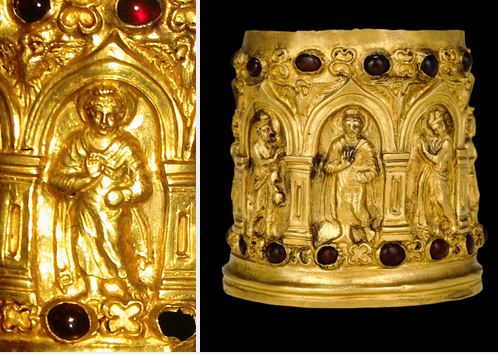
Un véritable thème classique du répertoire de tout artiste de l’époque consiste à montrer Bouddha entouré, accueilli et protégé des divinités d’autres croyances et de religions plus anciennes. La plus ancienne représentation de ce type connue à ce jour figure sur un reliquaire trouvé dans le stupa de Bimaran, au nord-ouest du Gandhara.
Sur cette petite urne en or, généralement datée de 50-60 après J.-C., figure, à l’intérieur de niches voûtées d’architecture gréco-romaine, une représentation hellénistique du Bouddha (coiffure, contrapposto, himation d’élite, etc.), entourée des divinités indiennes Brahma et Sakra.
Tout comme Ashoka, Kanishka, presque laïque, entendait régner, non pas contre mais avec, et surtout au-dessus de toutes les religions. Ainsi, à l’occasion, les divinités grecques, représentées sur les pièces de monnaie (Zeus, Apollon, Héraclès, Athéna, etc.), côtoient les divinités du védisme, du zoroastrisme et du bouddhisme.
Autre exemple, à Ellora, au centre de l’Inde, la grotte et le temple taillés dans le roc où se côtoient les représentants des trois religions (bouddhisme, hindouisme et jaïnisme).
C. Triade de Hadda


Un autre exemple exquis de cet art gandharien est un groupe sculptural connu sous le nom de Triade de Hadda, excavé à Tapa Shotor, un grand monastère sarvastivadin près de Hadda en Afghanistan, datant du IIe siècle après J.-C.
Pour donner une idée de son activité, ce sont quelque 23 000 sculptures gréco-bouddhiques, en argile et en plâtre, qui ont été mises au jour rien qu’à Hadda, entre les années 1930 et 1970.
Le site, fortement endommagé lors des dernières guerres, possédait de belles statues, notamment un bouddha assis, vêtu d’une chlamyde grecque (manteau blanc), les cheveux bouclés, accompagné d’Héraclès et de Tyché (déesse grecque de la fortune et de la prospérité), vêtue d’un chiton (robe à la grecque) et tenant une corne d’abondance.
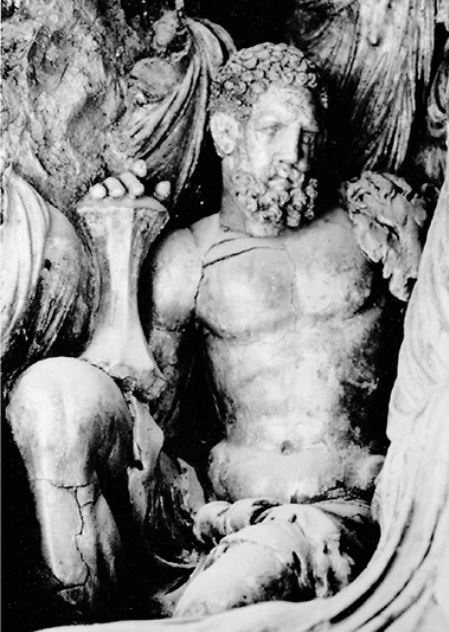
Seule adaptation aux traditions locales de l’iconographie grecque, Héraclès tient en main, non plus son habituelle massue, mais la foudre de Vajrapani (du sanskrit vajra, signifiant « foudre », et pani « en main »), l’une des trois premières divinités protectrices entourant le Bouddha.
C’est un bodhisattva. Il apparaît dès le IIe siècle dans l’iconographie mahāyāna comme doué d’une grande force et comme protecteur du Bouddha. Dans l’art gréco-bouddhique il ressemble à Héraclès ou Zeus, tenant en main une courte massue en forme de vajra, un foudre stylisé. On l’identifie au protecteur, « puissant comme un éléphant », qui aurait veillé sur Bouddha à sa naissance.
Une autre statue rappelle le portrait d’Alexandre le Grand.

De cet ensemble sculptural, il ne reste malheureusement que des photographies.
Selon l’archéologue afghan Zemaryalai Tarzi, le monastère de Tapa Shotor, avec ses sculptures en argile datées du IIe siècle de notre ère, représente le « chaînon manquant » entre l’art hellénistique de Bactriane et les sculptures en stuc plus tardives trouvées à Hadda, généralement datées du IIIe-IVe siècle de notre ère.
Traditionnellement, l’afflux d’artistes, maître de l’art hellénistique, a été attribué à la migration des populations grecques des villes gréco-bactriennes d’Aî-Khanoum et de Takht-I-Sangin (Nord de l’Afghanistan).
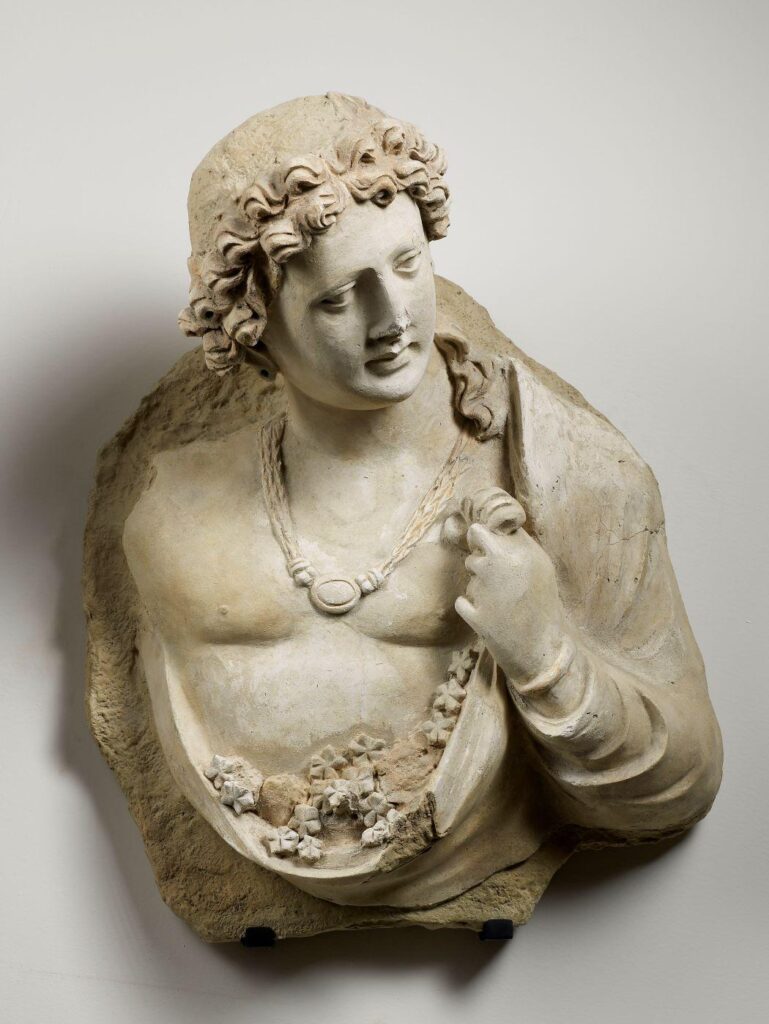
Tarzi suggère que les populations grecques se sont établies dans les plaines de Jalalabad, qui comprennent Hadda, autour de la ville hellénistique de Dionysopolis, et qu’elles sont à l’origine des créations bouddhistes de Tapa Shotor, au IIe siècle de notre ère.
Les colons grecs restés au Gandhara (les Yavanas) après le départ d’Alexandre, soit par choix, soit en tant que populations condamnées à l’exil par Athènes, ont grandement embelli les expressions artistiques de leur nouvelle spiritualité.
Offrant fraîcheur, poésie et un sens du mouvement spectaculairement moderne, les premiers artistes bouddhistes du Gandhara, saisissant des instants de « mouvement-changement » permettant à l’esprit humain d’appréhender un saut vers la perfection, sont une contribution inestimable à la culture de l’humanité tout entière. N’est-il pas temps de reconnaître ce magnifique travail ?
D. Prendre la terre à témoin

Parmi les autres types productions artistiques de Gandhara, ce magnifique bas-relief, aujourd’hui conservée au musée de Cleveland, illustre la lutte du Bouddha pour atteindre le nirvana.

Au centre de la composition se trouve l’arbre de la Bodhi, sous lequel le Bouddha atteignit l’illumination. Ce figuier sacré est vénéré depuis des temps ancestraux par les villageois locaux, car il passe pour être la résidence d’une divinité de la nature. L’autel lui-même est recouvert de kusha, herbe utilisée pour des offrandes sacrificielles.
Il y a environ 2500 ans, après être resté en méditation pendant 49 jours, assis sous cet arbre, le Bouddha est défié par des démons cauchemardesques qui remettent en cause l’authenticité de son illumination.
Leur chef Mara (littéralement, la mort), qui se tient à droite dans une posture arrogante, entouré de ses filles, fait tout pour empêcher Bouddha d’atteindre le nirvana (l’éveil).
Il le menace et encourage ses propres filles à le séduire. Innocemment, il lui demande s’il est sûr de pouvoir trouver quelqu’un pour témoigner qu’il a véritablement atteint le nirvana. En réponse à ce défi, le Bouddha touche alors la terre et la prend à témoin.
Selon la mythologie, la jeune déesse de la Terre surgit alors du sol et commença à essorer les eaux déferlant de ses cheveux pour noyer Mara. Sur la sculpture, on peut la voir, toute petite, au pied de l’autel, agenouillée devant Bouddha en signe de révérence. Elle a également pris forme humaine en sortant de terre. Les anciennes religions interviennent ici pour défendre et protéger la nouvelle, celle de Bouddha.
Semblant, eux aussi, regretter les anciens dieux et déesses de leur panthéon, les Indiens convertis au bouddhisme les ajoutent au-dessus de la tête de Bouddha ou à côté, comme, par exemple, le dieu védique Indra.
E. Tous bodhisattva ?

Enfin, pour conlure cette section sur la sculpture, deux mots sur le bodhisattva, figure très intéressante sortie de l’imaginaire bouddhiste pour rendre la spiritualité bouddhiste accessible au citoyen ordinaire.

Il peut s’agir soit d’une représentation de Bouddha en personnage princier orné de bijoux, avant son renoncement à la vie de palais, soit d’un humain ordinaire, déjà conscient qu’il est sur la voie de l’illumination et qu’il est devenu un outil au service du bien.
Animé d’altruisme et obéissant les disciplines destinées aux bodhisattvas, il doit aider par compassion d’abord les autres êtres sensibles à s’éveiller, y compris en retardant sa propre libération !
Les bodhisattvas se distinguent par de grandes qualités spirituelles telles que les « quatre demeures divines » que sont:

- l’amour bienveillant (maitri),
- la compassion (karuna),
- la joie empathique (mudita) et
- l’équanimité (upekṣa),
ainsi que les diverses perfections (paramitas), qui comprennent la prajnaparamita (« connaissance transcendante » ou « perfection de la sagesse ») et les moyens habiles (upaya).
Des bodhisattvas spirituellement avancés tels qu’Avalokiteshvara (ci-dessus), Maitreya et Manjushri, largement vénérés dans le monde bouddhiste mahâyâna, sont censés posséder un grand pouvoir, qu’ils utilisent pour aider tous les êtres vivants.
Pour certains courants bouddhistes, seul Maitreya mérite le titre de « Bouddha du futur ». Dans l’art on le représente à la fois comme un bouddha vêtu d’une robe monastique et comme un bodhisattva princier avant l’illumination.
Un magnifique bodhisattva de Gandhara peut être admiré au Dallas Museum of Art (ci-dessous).
Cette sculpture en terre cuite représente un « Bodhisattva pensant » de la région de Hadda en Afghanistan, une production typique du Gandhara.

Avec très peu d’éléments visuels, l’artiste réussit un travail gigantesque. Les piliers de sa large chaise sont des lions au regard un peu fou, représentation allégorique de ces passions qui nous font souffrir et qui sont maintenues sous un sage contrôle par l’effort hautement réflexif du Bodhisattva héroïque au centre de l’œuvre.
Le bouddhisme aujourd’hui, l’exemple de Nehru

Paradoxalement, le bouddhisme, en tant que religion, a presque cessé d’exister dans son propre berceau, l’Inde, depuis le XIIe siècle de notre ère.
Bel exemple de la lutte incessante des meilleurs esprits indiens pour l’émancipation, en 1956, près d’un demi-million « d’intouchables » se sont convertis au bouddhisme sous l’impulsion du dirigeant politique à la tête du comité chargé de rédiger la Constitution de l’Inde, le réformateur social B. R. Ambedkar (1891-1956), et du Premier ministre indien et chef du Parti du Congrès Jawaharlal Nehru (1889-1964), lui-même issu d’une famille de brahmanes.
En juin de la même année, le Courrier de l’UNESCO consacrait son édition à « 25 siècles d’art et de culture bouddhistes ».
En Inde, les deux hommes d’État ont orchestré une année de célébration en l’honneur de « 2500 ans de bouddhisme », non pas pour ressusciter une ancienne religion en soi, mais pour s’approprier le statut de berceau de cette vieille religion et renvoyer au monde une image de champion de la non-violence et du pacifisme.

Quelques années plus tard, lors de sa visite d’État à la Maison Blanche, le 9 novembre 1961, le Premier ministre indien Nehru offrit une sculpture bouddhiste au président John F. Kennedy
Comme beaucoup d’hindous, Mahatma Gandhi vénérait Bouddha. Pour lui, le bouddhisme n’était qu’une « autre forme d’hindouisme » et sa critique venait donc « de l’intérieur de l’hindouisme ».
Un point de vue que ne partageait pas le Premier ministre indien Jawaharlal Nehru. Profondément troublé par certaines caractéristiques intrinsèques à l’hindouisme, telles que le ritualisme et les castes, Nehru ne pouvait pas placer le bouddhisme, qui abhorrait ces institutions, dans la même rubrique…
Nehru fut fortement influencé par le bouddhisme. C’est ainsi qu’il appela sa fille (la future Première ministre Indira Gandhi) Indira Priyadarshini, du nom de « Priyadarshi » adopté par le grand empereur Ashoka, après être devenu un prince bouddhiste de la paix !

Par ailleurs, Nehru contribua à faire de l’Ashoka Chakra (la Roue bouddhiste intégrée au drapeau national) le symbole de l’Inde. Chaque fois qu’il se rendait au Sri Lanka, il visitait la statue du Bouddha à Anuradhapura.
Le dirigeant indien, qui ne cessait d’exhorter les Indiens superstitieux et ritualistes à cultiver un « tempérament scientifique » et à faire entrer l’Inde dans l’ère de l’âge atomique, était naturellement attiré par le rationalisme prôné par le Bouddha.
« Bouddha ne demandait à personne de croire en quoi que ce soit d’autre que ce qui pouvait être prouvé par l’expérience et l’essai. Tout ce qu’il voulait, c’était que les hommes recherchent la vérité et n’acceptent rien sur la foi d’un autre homme, même s’il s’agissait du Bouddha lui-même. Il me semble que c’est là l’essence de son message », alléguait Nehru.
Et d’ajouter :
« Lui-même a eu le courage d’accepter la vérité et de ne rien accepter sur la foi d’un autre (…) Bouddha a eu le courage de s’attaquer à la religion populaire, à la superstition, au cérémonial et à la prêtrise, ainsi qu’à tous les intérêts qui s’y rattachent. Il a également condamné les perspectives métaphysiques et théologiques, les miracles, les révélations et les relations avec le surnaturel. Il fait appel à la logique, à la raison et à l’expérience ; il met l’accent sur l’éthique (…) Toute son approche est comme le souffle du vent frais des montagnes après l’air vicié de la spéculation métaphysique (…) Bouddha n’a pas attaqué directement les castes, mais dans son propre ordre, il ne les a pas reconnues, et il ne fait aucun doute que toute son attitude et son activité ont affaibli le système des castes. »
L’influence du Bouddha s’est manifestée dans la politique étrangère de Nehru. Cette politique était motivée par un désir de paix, d’harmonie internationale et de respect mutuel. Elle visait à résoudre les conflits par des méthodes pacifiques. Le 28 novembre 1956, Nehru déclare :
« C’est essentiellement grâce au message du Bouddha que nous pouvons envisager nos problèmes dans la bonne perspective et nous éloigner des conflits et de la concurrence dans le domaine des conflits, de la violence et de la haine. »
Visiblement inspirés par les préceptes bouddhistes, les concepts de non-alignement et le Traité de Panchsheel de Nehru, communément appelé « Traité des cinq principes de coexistence pacifique », ont été formellement énoncés pour la première fois dans l’Accord sur le commerce et les relations entre le Tibet chinois et l’Inde, signé le 29 avril 1954.
Cet accord stipulait, dans son préambule, que les deux gouvernements,
« ont décidé de conclure le présent accord sur la base des principes suivants :
1) respect mutuel de l’intégrité territoriale et de la souveraineté de l’autre,
2) non-agression mutuelle,
3) non-ingérence mutuelle,
4) égalité et avantage mutuel,
5) coexistence pacifique. »
Le 29 novembre 1952, lors de la Conférence culturelle bouddhiste internationale à Sanchi, où Kanitscha avait entamé la construction du plus haut stupa de l’Antiquité, Nehru précisait :
« Le message que Bouddha a transmis il y a 2500 ans a éclairé non seulement l’Inde et l’Asie, mais le monde entier. La question qui se pose inévitablement est la suivante : le grand message du Bouddha peut-il s’appliquer au monde d’aujourd’hui ? Peut-être que oui, peut-être que non, mais je sais que si nous suivons les principes énoncés par le Bouddha, nous gagnerons la paix et la tranquillité pour le monde. »
Le 3 octobre 1960, Nehru s’adressait à l’Assemblée générale des Nations unies :
« Dans un passé lointain, un grand fils de l’Inde, le Bouddha, a dit que la seule vraie victoire était celle où tous étaient également victorieux et où personne n’était vaincu. Dans le monde d’aujourd’hui, c’est la seule victoire concrète ; toute autre voie mène au désastre. »
Nehru a fait de son mieux pour appliquer les enseignements du Bouddha dans la gestion des affaires intérieures de l’Inde. Sa conviction que le changement social ne peut être obtenu que par le consensus social le plus large découle de l’influence du Bouddha, d’Ashoka et de Gandhi.
Dans son discours du 15 août 1956 à l’occasion de la fête de l’indépendance, Nehru fixe les défis à relever :
« Nous sommes fiers que le sol sur lequel nous sommes nés ait produit de grandes âmes comme le Bouddha Gautama et Gandhi. Rafraîchissons-nous la mémoire une fois de plus et rendons hommage à Gautama Bouddha et à Gandhi, ainsi qu’aux grandes âmes qui, comme eux, ont façonné ce pays. Suivons la voie qu’ils nous ont montrée avec force, détermination et coopération. »
Science et religion, Albert Einstein et Bouddha
Pour conclure, je vous invite à méditer quelques citations d’Albert Einstein discutant les rapports entre la science et la religion où il évoque l’importance de Bouddha :

Le sentiment religieux cosmique
« Il existe un troisième état d’expérience religieuse… que j’appellerai le sentiment religieux cosmique. Il est très difficile d’expliquer ce sentiment à quelqu’un qui en est totalement dépourvu, d’autant plus qu’il n’y a pas de conception anthropomorphique de Dieu qui lui corresponde. L’individu ressent le néant des désirs et des objectifs humains, ainsi que la sublimité et l’ordre merveilleux qui se révèlent tant dans la nature que dans le monde de la pensée. Il considère l’existence individuelle comme une sorte de prison et veut faire l’expérience de l’univers comme un tout unique et significatif. Les prémices d’un sentiment religieux cosmique apparaissent déjà à un stade précoce du développement, par exemple dans de nombreux Psaumes de David et dans certains Prophètes.
Le bouddhisme, comme nous l’ont appris les merveilleux écrits de Schopenhauer en particulier, en contient un élément beaucoup plus fort. Les génies religieux de tous les temps se sont distingués par ce type de sentiment religieux, qui ne connaît ni dogme, ni Dieu conçu à l’image de l’homme, de sorte qu’il ne peut y avoir d’Église dont l’enseignement central se fonde sur lui.
C’est donc précisément parmi les hérétiques de toutes les époques que l’on trouve des hommes animés du sentiment religieux le plus élevé et qui, dans bien des cas, étaient considérés par leurs contemporains comme des athées, parfois même comme des saints. Vu sous cet angle, des hommes comme Démocrite, François d’Assise et Spinoza sont très proches les uns des autres. Comment le sentiment religieux cosmique peut-il se transmettre d’une personne à l’autre, s’il ne peut donner lieu à aucune notion précise de Dieu et à aucune théologie ? À mon avis, c’est la fonction la plus importante de l’art et de la science que d’éveiller ce sentiment et de le maintenir en vie chez ceux qui en sont capables ».
—Einstein, Albert. Le monde tel que je le vois. (Secaucus, NJ : Carol Publishing Group, 1999). p. 26.
Libéré des entraves et de ses désirs égoïstes
« Une personne religieusement éclairée me semble être celle qui, au mieux de ses capacités, s’est libérée des entraves de ses désirs égoïstes et se préoccupe de pensées, de sentiments et d’aspirations auxquels elle s’accroche en raison de leur valeur supra-personnelle. Il me semble que ce qui est important, c’est la force de ce contenu supra-personnel et la profondeur de la conviction concernant son sens impérieux, indépendamment de toute tentative d’unir ce contenu à un Être divin, car sinon il ne serait pas possible de considérer Bouddha et Spinoza comme des personnalités religieuses.
Par conséquent, une personne religieuse est pieuse dans le sens où elle ne doute pas de la signification et de la hauteur de ces objets et objectifs supra-personnels qui ne nécessitent ni ne peuvent être fondés rationnellement. Ils existent avec la même nécessité et la même évidence que lui. En ce sens, la religion est l’effort séculaire de l’humanité pour devenir clairement et complètement consciente de ces valeurs et de ces objectifs et pour renforcer et étendre constamment leur effet.«
—Einstein, Albert. Einstein, Science, Philosophy and Religion, A Symposium, publié par la Conference on Science, Philosophy and Religion in Their Relation to the Democratic Way of Life, Inc, New York, 1941.
Bouddha, Moïse et Jésus
« Ce que l’humanité doit à des personnalités comme Bouddha, Moïse et Jésus est pour moi plus important que toutes les réalisations de l’esprit curieux et constructif. Ce que ces hommes bénis nous ont donné, nous devons le garder et essayer de le maintenir en vie de toutes nos forces si l’humanité ne veut pas perdre sa dignité, la sécurité de son existence et sa joie de vivre ».
—Einstein, Albert. Déclaration écrite (septembre 1937), p. 70
Commencer par le coeur de l’homme
« Si nous voulons améliorer le monde, nous ne pouvons pas le faire avec des connaissances scientifiques, mais avec des idéaux. Confucius, Bouddha, Jésus et Gandhi ont fait plus pour l’humanité que la science. Nous devons commencer par le cœur de l’homme, par sa conscience, et les valeurs de la conscience ne peuvent se manifester que par un service désintéressé à l’humanité ».
—Einstein, Albert. Einstein et le poète (1983), p. 92
L’illusion optique de la conscience
L’un des échanges les plus poignants de son rôle de philosophe a eu lieu alors qu’il avait 70 ans et vivait à Princeton. Un rabbin ordonné lui avait écrit pour lui dire qu’il avait cherché en vain à réconforter sa fille de 19 ans après la mort de sa sœur, « une belle enfant de 16 ans, sans péché ».
L’être humain », écrit Einstein en réponse, « est une partie du tout, que nous appelons « Univers », une partie limitée dans le temps et l’espace. Il fait l’expérience de lui-même, de ses pensées et de ses sentiments comme quelque chose de séparé du reste – une sorte d’illusion d’optique de sa conscience. Cette illusion est une sorte de prison pour nous, nous limitant à nos désirs personnels et à l’affection pour quelques personnes qui nous sont proches. Notre tâche doit être de nous libérer de cette prison en élargissant notre cercle de compassion à toutes les créatures vivantes et à toute la nature dans sa beauté. Personne n’est en mesure d’y parvenir complètement, mais le fait de s’efforcer d’y parvenir est en soi une partie de la libération et un fondement de la sécurité intérieure ».
— Walter Sullivan, “The Einstein Papers: A Man of Many Parts,” New York Times, 29 mars 1972.
NOTES :
*1. Les langues indo-aryennes. Il existe plus de 200 langues indo-aryennes connues, parlées par environ 1 milliard de personnes. Leurs formes modernes descendent des langues indo-aryennes anciennes, telles que le sanskrit védique primitif, en passant par les langues indo-aryennes moyennes (ou prakrits). Les langues indo-aryennes les plus importantes en termes de premiers locuteurs sont l’hindi-ourdou (c. 330 millions), le bengali (242 millions), le pendjabi (environ 120 millions), le marathi (112 millions), le gujarati (60 millions), le rajasthani (58 millions), le bhojpuri (51 millions), l’odia (35 millions), le maithili (environ 34 millions), le sindhi (25 millions), le népali (16 millions), l’assamais (15 millions), le chhattisgarhi (18 millions), le cinghalais (17 millions) et le romani (environ 3,5 millions). Le sud de l’Inde compte des langues dravidiennes (telugu, tamil, kannada et malayalam). En Europe, les principales langues indo-européennes sont l’anglais, le français, le portugais, le russe, le néerlandais et l’espagnol.
*2. Discords. Dès le IIIe siècle avant J.-C., pas moins de dix-huit écoles bouddhistes distinctes sont à l’œuvre en Inde, mais toutes se reconnaissent mutuellement comme des adeptes de la philosophie du Bouddha. Enfin, le bouddhisme du Véhicule du Diamant, dit Vajrayâna, dont les textes et les rituels complexes ont été élaborés dans les universités du nord-est de l’Inde vers le VIIe et VIIIe siècles.
*3. Le prâkrit est un terme qui désigne une langue indo-aryenne dérivée du sanskrit classique. Le mot lui-même a une définition assez souple, car il a parfois le sens de « originel, naturel, sans artifices, normal, ordinaire, usuel, ou encore, local », contrastant ainsi avec la forme littéraire et religieuse du sanskrit ; mais parfois, on peut aussi comprendre prâkrit comme signifiant « dérivé d’une langue originelle », c’est-à-dire dérivé du sanskrit. On peut donc dire que le prâkrit, comme toute langue vulgaire et vernaculaire de l’Inde, est issu du sanskrit. En fait, on peut comparer les prâkrits au latin vulgaire, tandis que le sanskrit serait le latin classique. L’usage le plus ancien que l’on connaisse du prâkrit est formé par l’ensemble d’inscriptions de l’empereur indien Ashoka (IIIe siècle av. J.-C.). L’un des prâkrits les plus célèbres est le pâli, qui a accédé au statut de langue littéraire et intellectuelle en devenant celle des textes du bouddhisme theravâda.
*4. Le pâli est une langue indo-européenne de la famille indo-aryenne. C’est un prâkrit moyen indien proche du sanskrit et remontant vraisemblablement au IIIe siècle av. J.-C. Le pâḷi est utilisé comme langue liturgique bouddhiste au Sri Lanka, en Birmanie, au Laos, en Thaïlande et au Cambodge. Son statut de langue liturgique l’a rendu, à l’instar du sanskrit, figé et normalisé.
*5. Hippodamos de Milet (né en 498 av. J.-C. et mort en 408 av. J.-C.) est un géomètre et ingénieur du Ve siècle av. J.-C., qui fut aussi architecte urbaniste, physicien, mathématicien, météorologiste et philosophe pythagoricien. La tradition a retenu de lui ses grands travaux de planification urbaine. Bien que ces travaux se caractérisent par l’utilisation systématique du plan en damier, il n’en est pas l’inventeur, de très anciennes colonies grecques nous fournissant déjà des exemples de cette structure urbaine.
Commentaires:
8 mars 2024, Bernard C.
Je continue la lecture du long texte illustré sur le « miracle du Gandhara ». Décidemment, tu as toujours l’art –et ce n’est pas un vain mot chez toi ! – de nous surprendre ! Quel bonheur ce doit être ! Merci Karel. Belle soirée à vous.
8 mars 2024, Bernard C., suite
J’espère qu’on reconnaitra un jour (ou l’autre) la beauté de ce travail (artkarel) dans son envergure, car tu ne cesses de nous renvoyer au moyen d’hyperliens (mots en bleu), à travers les âges, d’un bout à l’autre des continents, d’Ashoka à Sully – de véritables efforts intercontinentaux échafaudent, à grands traits pour ne pas dire à grandes enjambées, devant nos yeux surpris (encore une fois, c’est le mot!), une œuvre d’art illustrant qu’il n’est de richesse que d’hommes, et où se meuvent, d’un bord à l’autre de l’histoire de la civilisation, correspondances d’idées majeures qu’on aurait pu croire isolément réservées à leurs temps. Chapeau !
Paris Schiller Institute stages Afghan civil society protest against UNESCO
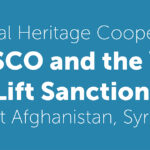

Paris, Feb. 2024 – On Thursday February 22, between 10:00 am and 1:00 pm CET, members and supporters of the International Schiller Institute, founded and presided by Helga Zepp-LaRouche, gathered peacefully in front of one of the main buildings of the headquarters of UNESCO in Paris (1, rue Miollis, Paris 75015). An appeal (see below), endorsed by both Afghans and respected personalities of four continents, was presented to the Secretary General and other officials of UNESCO.
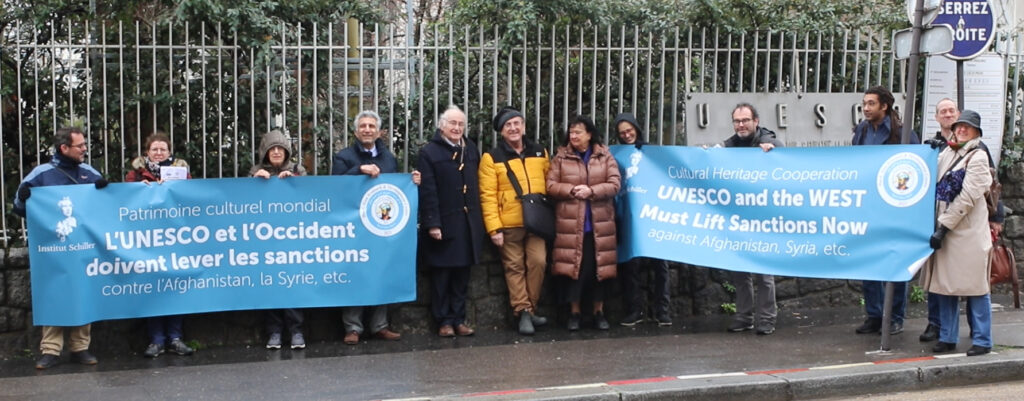
How it started
Following a highly successful conference in Kabul last November by the Ibn-e-Sina Research & Development Center on the reconstruction of Afghanistan, a group of senior archaeologists of the Afghan Academy of Sciences (ASA), in discussion with the organizers and the invited experts of the Schiller Institute, suggested to launch a common appeal to UNESCO and Western governments to “lift the sanctions against cultural heritage cooperation.”

The Call
“We regret profoundly, says the call, that the Collective West, while weeping crocodile tears over destruction of the world’s cultural heritage, has imposed a selective ban of scientific cooperation on nations mistakenly considered as “opposed to its rules and values.” The complete freeze of all cooperation in the field of archaeology between France and both Syria and Afghanistan, is just one example of this tragedy.”
“The dramatic neglect of international cultural institutions and donors to Afghanistan, the lack of sufficient funds in the field of cultural heritage protection, and the political treatment of international cultural heritage institutions have seriously endangered Afghanistan,” underscores the petition.
Specifically, “UNESCO, which should raise its voice against any new form of ‘cultural and scientific apartheid,’ has repeatedly worsened the situation by politicizing issues beyond its prerogatives.”
To conclude, the signers call
“on the international community to immediately end this form of ‘collective punishment,’ which creates suffering and injustice, promotes ignorance, and endangers humanity’s capacity for mutual respect and understanding.”
Living Spirit of Afghanistan
To date, over 550 signatures have been collected, mainly from both Afghan male (370) and female (140) citizens, whose socio-professional profiles indicates they truly represent the « living spirit of the nation ».
Among the signatories: 62 university lecturers, 27 doctors, 25 teachers, 25 members of the Afghan Academy of Sciences, 23 merchants, 16 civil and women’s rights activists, 16 engineers, 10 directors and deans of private and public universities, 7 political analysts, 6 journalists, 5 prosecutors, several business leaders and dozens of qualified professionals from various sectors.
International support
On four continents (Europe, Asia, America, Africa), senior archaeologists, scientists, researchers, members of the Academy of Sciences, historians and musicians from over 20 countries have welcomed and signed this appeal.
Italian Professor Pino Arlacchi, a former member of the European Parliament and the former head of United Nations Office on Drugs and Crime (UNODC) was the first to sign. Award-winning American filmmaker Oliver Stone, is a more recent signer.
In France, Syria, Italy, the UK and Russia, among the signers one finds senior researchers suffering the consequences of what some have identified as a « New Cultural Cold War. » Superseding the very different opinions they have on many questions, the signatories stand united on the core issue of this appeal: for science to progress, all players, beyond ideological, political and religious differences, and far from the geopolitical logic of ‘blocs’, must be able to exchange freely and cooperate, in particular to protect mankind’s historical and cultural heritage.
Testifying to the firm commitment of the Afghan authorities, the petition has also been endorsed by the Deputy Minister of Foreign Affairs, the Minister of Culture and Arts, and the Minister of Agriculture, as well as senior officials from the Ministries of Higher Education, Water and Energy, Mines, Finance, and others.
“The 46th session of UNESCO’s World Heritage Committee, to be held in New Delhi in July this year, offers UNESCO the opportunity to announce Afghanistan’s full return into world heritage cooperation, if we can have our voice heard,” says Karel Vereycken of the Paris Schiller Institute. “We certainly will not miss transmitting this appeal to HE Vishal V Sharma, India’s permanent representative to UNESCO, recently nominated to make the Delhi 46th session a success.”
For all information, interview requests in EN, FR and NL:
Karel Vereycken, Schiller Institute Paris
00 33 (0)6 19 26 69 38
Full text of the appeal
International Call to Lift Sanctions Against Cultural Heritage Cooperation
Following the international conference, organized by the Ibn-e-Sina Research & Development Center’s in Kabul in early November 2023, on the reconstruction of Afghanistan, a group of researchers launched the following petition:
We, the undersigned, researchers and experts in the domains of the history of civilizations, cultural heritage, archaeology, anthropology, sociology, and many other fields, and other enlightened citizens of the world, in Afghanistan, Syria, Russia, China, and many other countries, launch the following call.
1) We regret profoundly that the “Collective West”, while weeping crocodile tears over destruction of the world’s cultural heritage, has imposed a selective ban of scientific cooperation on nations mistakenly considered as “opposed to its rules and values.” The complete freeze of all cooperation in the field of archaeology between France and both Syria and Afghanistan, is just one example of this tragedy.
2) We request particular attention to the case of Afghanistan. Its neighboring countries, national and international institutions, and countries involved in international conventions for the protection of cultural and natural heritage are committed to cooperation in the field of guarding cultural heritage sites and artifacts and preventing their smuggling and destruction. Therefore, it is expected that in the current situation, they will fully play their role in the protection of Afghanistan’s cultural heritage in accordance with international laws and conventions. However, the dramatic neglect of international cultural institutions and donors to Afghanistan, the lack of sufficient funds in the field of cultural heritage protection, and the political treatment of international cultural heritage institutions have seriously endangered Afghanistan. Undoubtedly, the non-recognition of the Afghan government has dimmed the attention of cultural institutions. Considering the above, we expect these international institutions to renew their full support to protect both the tangible and the intangible cultural heritage of Afghanistan.
3) We regret that UNESCO, which should raise its voice against any new form of “cultural and scientific apartheid,” has repeatedly worsened the situation by politicizing issues beyond its prerogatives.
4) Therefore, we call on the international community to immediately end this form of “collective punishment,” which creates suffering and injustice, promotes ignorance, and endangers humanity’s capacity for mutual respect and understanding.
The progress of scientific knowledge, in a positive climate permitting all to share it, is by its very nature beneficial to each and to all and to the very foundation of a true peace.
SIGNERS:
A. FROM AFGHAN CIVIL SOCIETY:
– Hussain Burhani, Archaeologist, Numismatist, Afghanistan ;
– Ketab Khan Faizi, Archaeologist, Director of the Academy of Sciences at the International Centre for Kushan Studies in Kabul, Afghanistan;
– Stora Ishams Mayar, Archaeologist, member of the Academy of Sciences at the International Centre for Kushan Studies in Kabul, editor in chief of the journal of this mentioned center, Afghanistan;
– Mahmood Jan Drost, Senior Architect, head of protection of old cities of Afghanistan, Ministry of Urban Development and Housing, Afghanistan;
– Ghulam Haidar Kushkaky, Archaeologist, associate professor, Archaeology Investigation Center, Afghanistan ;
— Laieq Ahmadi, Archeologist, Former head, Archeology department of Bamiyan University, Afghanistan;
– Shawkatullah Abed, Chief of staff, Afghan Science Academy, Afghanistan;
– Sardar Ghulam Ali Balouch, Head of Afghanistan Balochs Union, Afghanistan;
– Daud Azimi Shinwari, Ibn-e-Sina Research & Development Center, Germany;
– Abdul Fatah Raufi, Ibn-e-Sina Research & Development Center, Kabul, Afghanistan;
– Mirwais Popal, Dip, Master, Ibn-e-Sina Research & Development Center, Germany;
B. FROM ABROAD:
(Russia, China, USA, Indonesia, France, Angola, Germany, Turkiye, Italy, UK, Mexico, Sweden, Iran, Belgium, Argentina, Czech Republic, Syria, Congo Brazzaville, Yemen, Venezuela, Pakistan, Spain, Canada, Democratic Republic of Congo.)
– H.E. Mr Mohammad Homayoon Azizi, Afghanistan’s Ambassador to Paris, UNESCO and ICESCO, France;
— Julio Bendezu-Sarmiento, Researcher at the National Scientific Research Centre (CNRS), Archaeologist specializing in Central Asia; Former director of the Delegation of French Archaeologists in Afghanistan (DAFA) (2014-2018), France;
– Inès Safi, CNRS, Researcher in Theoretical Nanophysics, France;
– Pierre Leriche, Archeologist, Director of Research Emeritus at CNRS-AOROC, Scientific Director of the Urban Archaeology of the Hellenized Orient research program, France;
– Nadezhda A. Dubova, Institute of Ethnology and Anthropology, Dr. in Biology, Prof. in History. Head of the Russian-Turkmen Margiana archaeological expedition, Russian Academy of Science (RAS), Russia;
— Alexandra Vanleene, Archaeologist, specialist in Gandhara Buddhist Art, Researcher, Independant Academic Advisor Harvard FAS CAMLab, France;
– Raffaele Biscione, retired, associate Researcher, Consiglio Nazionale delle Recerche (CNR); former first researcher of CNR, former director of the CNR archaeological mission in Eastern Iran (2009-2022), Italy;
— Sandra Jaeggi-Richoz, Professor, Historian and archaeologist of the Antiquity, France;
– Dr. Razia Sultanova, Professor, Cambridge University, UK;
– Dr. Houmam Saad, Archaeologist, Directorate General of Antiquities and Museums, Syria;
– Estelle Ottenwelter, Institute of Archaeology, Czech Academy of Sciences, Natural Sciences and Archaeometry, Post-Doc, Czech Republic;
– Didier Destremau, author, diplomat, former French Ambassador, President of the Franco-Syrian Friendship Association (AFS), France ;
– Wang Feng, Professor, South-West Asia Department of Chinese Academy of Social Sciences (CASS), China;
– Dr. Engin Beksaç, Professor, Trakya University, Department of Art History, Turkiye;
– Bruno Drweski, Professor, National Institute of Oriental Languages and Civilizations (INALCO), France;
– Maurizio Abbate, National President of National Agency of Cultural Activities (ENAC), Italy;
– Patricia Lalonde, Former Member of the European Parliament, vice-president of Geopragma, author of several books on Afghanistan, France;
– Pino Arlacchi, Professor of sociology, Former Member of the European Parliament, former head of United Nations Office on Drugs and Crime (UNODC), Italy;
– Oliver Stone, Academy Award-winning Film director, Producer, and Screenwriter;
– Graham E. Fuller, Author, former Station chief for the CIA in Kabul until 1978, former Vice-Chair of the National Intelligence Council (1986), USA;
– Prof. H.C. Fouad Al Ghaffari, Advisor to Prime Minister of Yemen for BRICS Countries affairs, Yemen;
– Farhat Asif, President of Institute of Peace and Diplomatic Studies (IPDS), Pakistan;
— Dursun Yildiz, Director, Hydropolitics Association, Türkiye;
– Irène Neto, president, Fundacao Dr. Antonio Agostinho Neto (FAAN), Angola;
– Luc Reychler, Professor international politics, University of Leuven, Belgium;
– Pierre-Emmanuel Dupont, Expert and Consultant in public International Law, Senior Lecturer at the Institut Catholique de Vendée, France;
— Irene Rodríguez, Departamento de Historia, Facultad de Filosofía y Letras, Universidad de Buenos Aires, Argentina;
– Dr. Ririn Tri Ratnasari, Professor, Head of Center for Halal Industry and Digitalization, Advisory Board at Journal of Islamic Accounting and Business Research, Faculty of Economics and Business, Universitas Airlangga, Indonesia;
– Dr. Clifford A. Kiracofe, Author, retired Professor of International Relations, USA;
– Bernard Bourdin, Dominican priest, Philosophy and Theology teacher, Institut Catholique de Paris (ICP), France;
– Dr. jur. Wolfgang Bittner, Author, Göttingen, Germany;
– Annie Lacroix-Riz, Professor Emeritus of Contemporary History, Université Paris-Cité, France;
– Mohammad Abdo Al-Ibrahim, Ph.D in Philology and Literature, University Lecturer and former editor in chief of the Syria Times, Syria;
– Jean Bricmont, Author, retired Physics Professor, Belgium;
– Syed Mohsin Abbas, Journalist, Broadcaster, Political Analyst and Political Justice activist, Pakistan;
– Eduardo D. Greaves PhD, Professor of Physics, Universidad Simón Bolívar, Caracas, Venezuela;
– Dora Muanda, Scientific Director, Kinshasa Science and Technology Week, Democratic Republic of Congo;
– Dr. Christian Parenti, Professor of Political Economy, John Jay College CUNY, New York, USA;
– Diogène Senny, President of the Panafrican Ligue UMOJA, Congo Brazzaville;
– Waheed Seyed Hasan, Journalist based in Qatar, former Special correspondent of IRNA in New Delhi, former collaborator of Tehran Times, Iran;
– Alain Corvez, Colonel (retired), Consultant International Strategy consultant, France;
– Stefano Citati, Journalist, Italy;
– Gaston Pardo, Journalist, graduate of the National University of Mexico. Co-founder of the daily Liberacion, Mexico;
– Jan Oberg, PhD, Peace and Future Research, Art Photographer, Lund, Sweden.
– Julie Péréa, City Councilor for the town of Poussan (Hérault), delegate for gender equality and the fight against domestic violence, member of the Sète Agglopole Méditerranée gender equality committee, France;
– Helga Zepp-LaRouche, Founder and International President of the Schiller Institute, Germany;
– Abid Hussein, independent journalist, Pakistan;
– Anne Lettrée, Founder and President of the Garden of Titans, Cultural Relations Ambassador between France and China for the Greater Paris region, France;
– Karel Vereycken, Painter-engraver, amateur Art Historian, Schiller Institute, France;
– Carlo Levi Minzi, Pianist, Musician, Italy;
– Leena Malkki Brobjerg, Opera singer, Sweden;
– Georges Bériachvili, Pianist, Musicologist, France;
– Jacques Pauwels, Historian, Canada;
C. FROM AFGHAN AUTHORITIES
– Sher Mohammad Abbas Stanikzai, Deputy Foreign Minister, Islamic Emirate of Afghanistan (IEA);
– Mawlawi Muhibullah Wasiq, Head of Foreign Minister’s Office, IEA;
– Waliwullah Shahin, Member of Ministry of Foreign Affairs, IEA;
– Sayedull Afghani, Member of Ministry of Foreign Affairs, IEA;
– Hekmatullah Zaland, Member of Ministry of Foreign Affairs, IEA;
– Shafi Azam, Ministry of Foreign Affairs, IEA;
– Atiqullah Azizi, Deputy Minister of Culture and Art, Ministry of Information and Culture, IEA;
– Ghorzang Farhand, Ministry of Information and Culture, IEA;
– Ghulam Dastgir Khawari, Advisor of Ministry of Higher Education, IEA;
– Mawlawi Rahmat Kaka Zadah, Member of ministry of Interior Affairs, IEA;
– Mawlawi Arefullah, Member of Interior Affairs, IEA;
– Ataullah Omari, Acting Agriculture Minister, IEA;
– Mawlawi Hussain Ahmad, Head of office in Ministry of Agriculture, IEA:
– Musa Noorzai, Member of Ministry of Agriculture, IEA;
– Mawlawi Hussain Ahmad, Head of office, Ministry of Agriculture, IEA;
– Mawlawi Shar Aqa, Head of Kunar Agriculture Administration, IEA;
– Matiulah Mujadidi, Head of Communication of Ministry of Finance, IEA;
– Zabiullah Noori, Executive Manager, Ministry of Finance, IEA;
– Akbar Wazizi, Member of Ministry of Finance, IEA;
– Nasrullah Ebrahimi, Auditor, Ministry of Finance, IEA;
– Mir M. Haroon Noori, Representative, Ministry of Economy, IEA;
– Abdul Qahar Mahmodi, Ministry of Commerce, IEA;
– Dr. Ghulam Farooq Azam, Adviser, Ministry of Water & Energy (MoWE), IEA;
– Faisal Mahmoodi, Investment Facilitation Expert, Ministry of Mines and Petroleum, IEA;
– Rustam Hafiz Yar, Ministry of Transportation, IEA;
– Qudratullah Abu Hamza, Governor of Kunar, IEA;
– Mansor Faryabi, Member of Kabul Municipality, IEA;
– Mohammad Sediq Patman, Former Deputy Minister of Education for Academic Affairs, IEA;
COMPLEMENTARY LIST
A. FROM AFGHANS
- Jawad Nikzad, Ibn-e-Sina R&D Centre, Kabul, Afghanistan ;
- Dr. Akram Azimi, Ibn-e-Sina R&D Centre, Kabul, Afghanistan ;
- Najibullah Totakhel, Ibn-e-Sina R&D Centre, Germany
- Ghulam Farooq Ansari, Professor, Ibn-e-Sina R&D Centre, Kabul, Afghanistan ;
- Imran Zakeria, Researcher at Regional Studies Center, Academy of Sciences of Afghanistan, Ibn Sina R&D Centre, Kabul, Afghanistan ;
- Subhanullah Obaidi, Doctor, Ibn-e-Sina R&D Centre, Germany ;
- Ali Shabeez, Ibn-e-Sina R&D Centre, Kabul, Germany ;
- Mawlawi Wahid Ameen, Ibn-e-Sina R&D Centre, Kabul, Afghanistan ;
- Shar M. Amir Zadah, Ibne-eSina R&D Centre, Kabul, Afghanistan ;
- Sayed Rafiullah Halim, Professor, Ibn-e-Sina R&D Centre, Kabul Afghanistan ;
- Nazar Mohmmad Ragheb, Ibn-e-Sina R&D Centre, Kabul, Afghanistan ;
- Ali Sina Masoumi, Ibn-e-Sina R&D Centre Kabul, Afghanistan ;
- Faisal Mahmoodi, Ibn-e-Sina R&D Centre, Kabul, Afghanistan ;
- Fatima Basir, Ibn-e-Sina R&D Centre, Kabul, Afghanistan ;
- Muneera Aman, Ibn-e-Sina R&D Centre, Kabul, Afghanistan ;
- Abdul Shakoor, Ibn-e-Sina R&D Centre, Kabul, Afghanistan ;
- Abdul Waris Ebad, Employee of Ministry of Foreign Affairs, Afghanistan ;
- Waisullah Sediqi, Ibn-e-Sina R&D Centre, Kabul, Afghanistan ;
- Sayed Hakim Aria, Employee of Ministry of Information and Culture, Afghanistan ;
- Nayebuddin Ekrami, Employee of Ministry of information and Culture, Afghanistan ;
- Latifa Azimi, Former Employee of Ministry of Education, Afghanistan ;
- Latifa Noori, Former Employee of Ministry of Education, Afghanistan ;
- Habibullah Haqani, Employee of Kabul Municipality, Afghanistan ;
- Shafiqullah Baburzai, Cultural Heritage, Afghanistan ;
- Abdullah Kamawal, Cultural Heritage, Afghanistan ;
- Abdul Rashid Lodin, Cultural Heritage, Afghanistan ;
- Asef Nang, Cultural Heritage, Afghanistan ;
- Awal Khan Shekib, Member of Afghanistan Regional Studies Center, Afghanistan ;
- Mohammad Anwar Fayaz, Lecturer, Afghanistan Science Academy, Afghanistan ;
- Farhad Ahmadi, Lecturer, Afghanistan Science Academy, Afghanistan ;
- Fayqa Lahza Faizi, Lecturer, Afghanistan Science Academy, Afghanistan ;
- Dr. Hakim Haidar, Lecturer, Afghanistan Science Academy, Afghanistan ;
- Rahimullah Harifal, Lecturer, Afghanistan Science Academy, Afghanistan ;
- Sharifullah Dost, Lecturer, Afghanistan Science Academy, Afghanistan ;
- Eshaq Momand, Lecturer, Afghanistan Science Academy, Afghanistan ;
- Khalil Rahman Barekzal, Lecturer, Afghanistan Science Academy, Afghanistan ;
- Ghulam Haidar Kushkaki, Lecturer, Afghanistan Science Academy, Afghanistan ;
- Ghulam Nabi Hanifi, Lecturer, Afghanistan Science Academy, Afghanistan ;
- Marina Bahar, Lecturer, Afghanistan Science Academy, Afghanistan ;
- Sayed Muhaidin Hashimi, Lecturer, Afghanistan Science Academy, Afghanistan ;
- Abdul Majid Nadim, Lecturer, Afghanistan Science Academy, Afghanistan ;
- Elaha Maqsoodi, Lecturer, Afghanistan Science Academy, Afghanistan ;
- Khadim Ahmad Haqiqi, Lecturer, Afghanistan Science Academy, Afghanistan ;
- Shahidullah Safi, Member, Afghanistan Science Academy, Afghanistan ;
- Abdul Wahab Hamdard, Member, Afghanistan Science Academy, Afghanistan ;
- Burhanullah Niazi, Member, Afghanistan Science Academy, Afghanistan ;
- M. Alam Eshaq Zai, Member, Afghanistan Science Academy, Afghanistan ;
- Ghulam Hasan Farmand, Member, Afghanistan Science Academy, Afghanistan ;
- Zalmai Hewad Mal, Member, Afghanistan Science Academy, Afghanistan ;
- Abdul Rahman Atash, Head of Afghanistan National Development Company (NDC), Afghanistan ;
- Obaidullah, Head of Public Library, Afghanistan ;
- Sayed Abdul Maqdam, Head of Khawar construction company, Afghanistan ;
- Zaki Zarifi, Head of Zarifi company, Afghanistan ;
- Jamshid Faizi, Head of Faizi company, Afghanistan ;
- M. Yasin Farahman, Head of Agriculture Center, Afghanistan ;
- Mawlawi Nik M. Nikmal, Head of Planning in Technical Administration, Afghanistan ;
- Abdul Wahid Rahimi, Member of Bashtani Bank, Afghanistan ;
- M. Daud Mangal, Head of Ariana Afghan Airlines, Afghanistan ;
- Mostafa Yari, entrepreneur, Afghanistan;
- Gharwal Roshan, Head of Kabul International Airfield, Afghanistan ;
- Eqbal Mirzad, Head of New Kabul City Project, Afghanistan ;
- Najibullah Sadiq, Vice-president of Afghan Chamber of Commerce and Indunstry (ACCI), Afghanistan;
- M. Yunis Mohmand, Vice-president of ACCI, Afghanistan;
- Khanjan Alikozai, Member of ACCI, Afghanistan;
- Mawlawi Abdul Rashid, Kabul Municipality, Afghanistan ;
- Atiqullah Safi, Employee of Kabul Municipality, Afghanistan ;
- Abdul Jalil Safi, Employee of Kabul Municipality, Afghanistan ;
- Hujat Fazli, Head of Harakat, Afghanistan Investment Climate Facility Afghanistan ;
- Dr. Mehrab Hamidi, Member of Economical Commission, Afghanistan;
- Hamid Pazhwak, Economist, Afghanistan ;
- M. Awaz Ali Alizai, Economist, Afghanistan ;
- Shamshad Omar, Economist, Afghanistan ;
- Helai Fahang, Economy Specialist, Afghanistan ;
- Maryam Alikozai, Economy Specialist, Afghanistan ;
- Dunya Farooz, Economy Specialist, Afghanistan ;
- Soman Khamoosh, Economy Specialist, Afghanistan ;
- Drs. Shokoria Yousofi, Bachelor of Economy, Afghanistan;
- Sharifa Wardak, Specialist of Agriculture, Afghanistan;
- M. Asef Dawlat Shahi, Specialist of Chemistry, Afghanistan;
- Pashtana Hamami, Specialist of Statistics, Afghanistan;
- Asma Karimi, Master of Management, Afghanistan;
- Dr. Ahmad Zaki Afghanyar, Vice-President of Herat Health committee, Afghanistan ;
- Dr. Hashem Mudaber, Medical Doctor, Afghanistan ;
- Dr. Hekmatullah Arian, Medical Doctor, Afghanistan ;
- Dr. Abdul Wahab Rahmani, Medical Doctor, Afghanistan ;
- Dr. Karima Rahimyar, Medical Doctor, Afghanistan ;
- Dr. Sayeeda Basiri, Medical Doctor, Afghanistan ;
- Dr. Emran Sayeedi, Medical Doctor, Afghanistan ;
- Dr. Abdul Hadi Dawlatzai, Medical Doctor, Afghanistan ;
- Dr. Ghani Naseri, Medical Doctor, Afghanistan ;
- Dr. Nafisa Naseri, Medical Doctor, Afghanistan ;
- Dr. Abdul Ghani Naseri, Medical Doctor, Afghanistan;
- Dr. Mohammad Younis Shouaib, Medical Doctor, Afghanistan ;
- Dr. Halima Akbari, Medical Doctor, Afghanistan;
- Dr. Manizha Emaq, Medical Doctor, Afghanistan;
- Dr. Shafiq Shinwari, Medical Doctor, Afghanistan ;
- Dr. Akbar Jan Foolad, Medical Doctor, Afghanistan ;
- Dr. Haidar Omar, Medical Doctor, Afghanistan ;
- Dr. Ehsanuddin Ehsan, Medical Doctor, Afghanistan ;
- Dr. Abdul Wakil Matin, Medical Doctor, Afghanistan ;
- Dr. Abdul Matalib, Medical Doctor, Afghanistan ;
- Dr. Azizi Amer, Medical Doctor, Afghanistan ;
- Dr. Nasr Sajar, Medical Doctor, Afghanistan ;
- Dr. Humayon Hemat, Medical Doctor, Afghanistan ;
- Dr. Humaira Fayaq, Medical Doctor, Afghanistan ;
- Dr. Sadruddin Tajik, Medical Doctor, Afghanistan ;
- Dr. Abdul Baqi Ahmad Zai, Surgery Specialist, Afghanistan ;
- Dr. Beqis Kohistani, Medical Doctor, Afghanistan;
- Dr. Nafisa Nasiri, Medical Doctor, Afghanistan;
- Dr. Aziza Yousuf, Head of Malalai Hospital, Afghanistan;
- Dr. Yasamin Hashimi, Medical Doctor, Afghanistan;
- Dr. Zuhal Najimi, Medical Doctor, Afghanistan;
- Dr. Ahmad Salem Sedeqi, Medical Doctor, Afghanistan;
- Dr. Fazel Raman, veterinary, Afghanistan;
- Khatera Anwary, Health, Afghanistan;
- Rajina Noori, Member of Afghanistan Journalists Union, Afghanistan ;
- Sajad Nikzad, Journalist, Afghanistan ;
- Ahmad Suhaib Hasrat, Journalist, Afghanistan ;
- Shar Aqa Karimi, Journalist, Afghanistan ;
- Sayed Mohammad Suhrabi , Journalist, Afghanistan ;
- Mohammad Nasir Kuhzad, Journalist and Political Analyst, Afghanistan ;
- Fazel Menallah, Political Analyst, Afghanistan;
- M. Wahid Benish, Political Analyst, Afghanistan ;
- Mahmood Jan Shafizada, Political Analyst, Afghanistan ;
- Fazel Rahman Orya, Political Analyst, Afghanistan ;
- Zarghon Shah Shinwari, Political Analyst, Afghanistan ;
- Abdul Ghafor Shinwari, Political Analyst, Afghanistan ;
- Dr. Ahmad Yousufi, Dean, Kateb University, Afghanistan ;
- Dr. Yayia Balaghat, Scientific Vice-President, Kateb University, Afghanistan ;
- Chaman Shah Etemadi, Head of Gharjistan University, Afghanistan;
- Dr. Mesbah, Head of Salam University, Afghanistan;
- Dr. Pirzad Ahmad Fawad, Kabul University;
- Dr. Nasir Nawidi, Dean of a Private University, Afghanistan;
- Zabiullah Fazli, Dean of a Private University, Afghanistan;
- Ramish Adib, Vice of a Private University, Afghanistan;
- M. Taloot Muahid, Dean of a Private University, Afghanistan;
- Ebrahim Ansari, School Manager, Afghanistan;
- Abas Ali Zimozai, Univ. Lecturer, Afghanistan ;
- Arshad Rahimi, Univ. Lecturer, Afghanistan ;
- Fasihuddin Fasihi, Univ. Lecturer, Afghanistan ;
- Waisuddin Jawad, Univ. Lecturer, Afghanistan ;
- M. Murtaza Sharzoi, Univ. Lecturer, Afghanistan ;
- M. Matin Monis, Univ. Lecturer, Afghanistan ;
- Mohammad Wahid Benish, Univ. Lecturer, Afghanistan ;
- Hussian Iqbal, Univ. Lecturer, Afghanistan ;
- Muhsin Reshad, Univ. Lecturer, Afghanistan ;
- Mohammad Sadiq Baqori, Univ. Lecturer, Afghanistan ;
- Mohammad Zahir Halimi, Univ. Lecturer , Afghanistan ;
- Rohla Qurbani, Univ. Lecturer, Afghanistan ;
- Murtaza Rezaee, Univ. Lecturer, Afghanistan ;
- Ghulam Rasoul Qarluq, Univ. Lecturer, Afghanistan ;
- Najim Wahidi, Univ. Lecturer, Afghanistan ;
- M. Rashid Iqbal, Univ. Lecturer, Afghanistan ;
- Abdul Rahman Matin, Univ. Lecturer, Afghanistan ;
- M. Mujtaba Amin, Univ. Lecturer, Afghanistan ;
- Amanullah Faqiri, Univ. Lecturer, Afghanistan ;
- Abuzar Khpelwak Zazai, Univ. Lecturer, Afghanistan ;
- Belal Tayab, Univ. Lecturer, Afghanistan ;
- M. Adel Hakimi, Univ. Lecturer, Afghanistan ;
- Wasiqullah Ghyas, Univ. Lecturer, Afghanistan ;
- Faridduin Atar, Univ. Lecturer, Afghanistan ;
- Safiullah Jawhar, Univ. Lecturer, Afghanistan ;
- Amir Jan Saqib, Univ. Lecturer, Afghanistan ;
- Ahmad Shekib Rahmani, Univ. Lecturer, Afghanistan ;
- M. Gulzar Hashimi, Univ. Lecturer, Afghanistan ;
- Taj Mohammad, Univ. Lecturer, Afghanistan;
- Hekmatullah Mirzad, Univ. Lecturer, Afghanistan;
- Abdul Haq Atid, Univ. Lecturer, Afghanistan ;
- M. Fahim Momand, Univ. Lecturer, Afghanistan;
- Ahmad Fawad Ehsas, Univ. Lecturer, Afghanistan;
- Naqibullah Sediqi, Univ. Lecturer, Afghanistan;
- Maiwand Wahidi, Univ. Lecturer, Afghanistan;
- M. Nazir Hayati, Univ. Lecturer, Afghanistan;
- Najiba Rahmani, Univ. Lecturer, Afghanistan;
- Abeda Baba Karkhil, Univ. Lecturer, Afghanistan;
- Dr. M. Qayoum Karim, Univ. Lecturer, Afghanistan;
- Sayed Sharif Shabir, Univ. Lecturer, Afghanistan;
- Ahmad Walid Howaida, Univ. Lecturer, Afghanistan;
- Zalmai Rahib, Univ. Lecturer, Afghanistan;
- Dr. Sadiq Baqori, Univ. Lecturer, Afghanistan;
- Mir Zafaruddin Ansari, Univ. Lecturer, Afghanistan;
- Atta Mohammad Alwak, Univ. Lecturer, Afghanistan;
- Dr. Zabiullah Iqbal, Univ. Lecturer, Afghanistan;
- Dr. Hasan Fazaili, Univ. Lecturer, Afghanistan;
- M. Jawad Jalili, Univ. Lecturer, Afghanistan;
- Mukhtar Ali Nasto, Univ. Lecturer, Afghanistan;
- Namatullah Nabawi, Univ. Lecturer, Afghanistan;
- Ghulam Abas Noori, Univ. Lecturer, Afghanistan;
- Mustafa Anwari, Univ. Lecturer, Afghanistan;
- Fakhria Popal, Univ. Lecturer, Afghanistan;
- Shiba Sharzai, Univ. Lecturer, Afghanistan;
- Marya Hashimi, Univ. Lecturer, Afghanistan;
- Nilofar Hashimi, Univ. Lecturer, Afghanistan;
- Munisa Hasan, Univ. Lecturer, Afghanistan;
- Nazifa Azimi, Univ. Lecturer, Afghanistan;
- Sweeta Sharify, Lecturer; Afghanistan;
- Fayaz Gul, Lecturer, Afghanistan;
- Zakia Ahmad Zai, Lecturer, Afghanistan;
- Nigani Barati, Education Specialist, Afghanistan ;
- Azeeta Nazhand, Teacher, Afghanistan ;
- Sughra, Teacher, Afghanistan;
- Nadia Sharif, Teacher, Afghanistan;
- Maryam Omari, Teacher, Afghanistan;
- Masoud, Teacher, Afghanistan;
- Zubair Ahmad, Teacher, Afghanistan;
- Khalil Ahmad, Teacher, Afghanistan;
- Khadija Omid, Teacher, Afghanistan;
- Haida Rasouli, Teacher, Afghanistan;
- Hemat Hamad, Teacher, Afghanistan ;
- Wazir Safi, Teacher, Afghanistan ;
- Mohammad Qasim, Teacher, Afghanistan ;
- Zamin Shah, Teacher, Afghanistan ;
- Sayed Qayas, Teacher, Afghanistan ;
- Mehrabuddin, Teacher, Afghanistan ;
- Zahidullah Zahid, Teacher, Afghanistan ;
- Akmal Mahros, Teacher, Afghanistan ;
- Sadia Mohammadi, Teacher, Afghanistan;
- Mina Amiri, Teacher, Afghanistan;
- M. Sajad Nikzad, Teacher, Afghanistan ;
- Mursal Nikzad, Teacher, Afghanistan ;
- Abdul Qadir Shahab, Teacher, Afghanistan;
- M. Hasan Sahi, Teacher, Afghanistan ;
- Mirwais Haqmal, Teacher, Afghanistan ;
- Leeda Khurasai, Teacher, Afghanistan ;
- Karishma Hashimi, Instructor, Afghanistan;
- Majeed Shams, Architect, Afghanistan;
- Azimullah Esmati, Master of Civil Engineering, Afghanistan;
- Najibullah Hussaini, Engineer, Afghanistan ;
- Burhanuddin Nezami, Engineer, Afghanistan ;
- Abdul Hafiz Hafizi, Engineer, Afghanistan ;
- Bahir, Engineer, Afghanistan;
- Wali Bayan, Engineer, Afghanistan;
- Abdul Khaliq Najir, Engineer, Afghanistan;
- Diana Niazi, Engineer, Afghanistan;
- Imam Jan, Engineer, Afghanistan ;
- Khalil Ahmad Nadem, Engineer, Afghanistan;
- Sayeed Aqa, Engineer, Afghanistan ;
- Edris Rasouli, Engineer, Afghanistan ;
- Raz Mohammad, Engineer of Mines, Afghanistan ;
- Nasrullah Rahimi, Technical Engineer, Afghanistan ;
- Ehsanullah, Helmand, Construction Engineer, Netherlands;
- Ahmad Hamad, Technologist, Afghanistan ;
- Akmal Ahmadi, Technologist, Afghanistan ;
- Ershad Hurmati, Technologist, Afghanistan ;
- M. Akram Shafim, Technologist, Afghanistan ;
- M. Akbar Ehsan, Technologist, Afghanistan ;
- Raziullah, Technologist, Afghanistan ;
- Zaki Khorrami, IT Officer, Afghanistan ;
- Osman Nikzad, Graphic Designer, Afghanistan ;
- Maryam Ayani, Carpet Weaver, Afghanistan ;
- Be be sima Hashimi, Tailor, Afghanistan ;
- Maryam Masoumi, Tailor, Afghanistan ;
- Roya Mohammadi, Craftsman, Afghanistan ;
- Nadia Sayes, Craftsman, Afghanistan ;
- Nazdana Ebad, Craftsman, Afghanistan ;
- Sima Ahmadi , Bachelor of Biology, Afghanistan;
- Sima Rasouli, Merchant, Afghanistan ;
- Khatera Nawabi, Merchant, Afghanistan ;
- Haji Noor Agha Haqyar, Merchant, Afghanstan;
- Husna Anwari, Merchant, Afghanistan ;
- Nargis Hashimi, Merchant, Afghanistan ;
- Shakira Barish, Merchant, Afghanistan ;
- Nasima Darwish, Merchant, Afghanistan ;
- Wajiha Haidari, Merchant of Jawzjan, Afghanistan ;
- Shagul, Merchant, Afghanistan ;
- Fatima Nik Rasoul, Merchant, Afghanistan ;
- Haji Farid Alikozai, Merchant, Afghanistan;
- Nigina Nawabi, Merchant, Afghanistan ;
- Masouda Nazimi, Merchant, Afghanistan ;
- Najla Kohistani, Merchant, Afghanistan ;
- Kerisma Jawhari, Merchant, Afghanistan ;
- Hasina Hashimi, Merchant, Afghanistan ;
- Husna Anwari, Merchant, Afghanistan ;
- Maaz Baburzai, Merchant, Afghanistan ;
- Freshta Safari, Merchant, Afghanistan;
- Yalda Azimi, Merchant, Afghanistan ;
- Azim Jan Baba Karkhil, Merchant, Afghanistan ;
- Akhtar Mohammad, Merchant, Afghanistan ;
- M. Haroon Ahmadzai, Merchant, Afghanistan ;
- Azizullah Faizi, Former head of Afghanistan Cricket Board, Afghanistan ;
- Wakil Akhar, Prosecutor, Afghanistan ;
- Akhtar M. Azimi, Prosecutor, Afghanistan;
- Shabnam Noori, Prosecutor, Afghanistan;
- Be be Abeda Wayar, Prosecutor, Afghanistan;
- Madina Ahmad Zai, Prosecutor, Afghanistan;
- Shakila Joya, Former Employee of Attorney General, Afghanistan;
- Sardar M. Akbar Bashash, Member, Afghanistan Balochs Union, Afghanistan ;
- Eng. Abdul Dayan Balouch, Spokesperson of Afghanistan Balochs Union, Afghanistan ;
- Shah Mahmood Lahoti, Member of Afghanistan Balochs Union, Afghanistan ;
- Abdul Khaliq Barekzai, Advisor, Afghanistan Balochs Union, Afghanistan ;
- Salahuddin Ayoubi Balouch, Advisor, Afghanistan Balochs Union, Afghanistan ;
- Faizuddin Lashkari Balouch, Member, Afghanistan Balochs Union, Afghanistan ;
- Sayed Ishaq Gilani, head of the National Solidarity Movement of Afghanistan, IEA;
- Haji Zalmai Latifi, Representative, Qizilbash tribes, Afghanistan ;
- Gul Nabi Ahmad Zai, Former Commander of Kabul Garrison, Afghanistan ;
- Ghulam Hussain Rezaee, Member, Habitat Organization, Afghanistan ;
- Dr. Amani Adiba, Doctor of Liberal Arts in Architecture and Urban Planning, Afghanistan;
- Ismael Paienda, Afghan Peace Activist, France;
- Mohammad Belal Rahimi, Head of Peace institution, Afghanistan ;
- M. Mushtaq Hanafi, Head of Sayadan council, Afghanistan ;
- Sabira Waizi, Founder of T.W.P.S., Afghanistan ;
- Majabin Sharifi, Member of Women Network Organization, Afghanistan;
- Shekiba Saadat, Former head of women affairs, Afghanistan ;
- Atya Salik, Women rights activist, Afghanistan ;
- Fatima Mahmoodi, Women rights activist, Afghanistan;
- Diana Rohin, Women rights activist , Afghanistan;
- Amena Hashimi, Head of Women Organization, Afghanistan;
- Fatanh Sharif, Former employee of Gender equality, Afghanistan;
- Sediq Mansour Ansari, Civil Activist, Afghanistan ;
- Sebghatullah Najibi, Civil Activist, Afghanistan ;
- Naemullah Nasiri, Civil Activist, Afghanistan;
- Reha Ramazani, Civil Activist, Afghanistan ;
- Lia Jawad, Civil Activist, Afghanistan;
- Arezo Khurasani, Social Activist, Afghanistan ;
- Beheshta Bairn, Social Activist, Afghanistan;
- Samsama Haidari, Social Activist, Afghanistan;
- Shabnam Nikzad, Humans Rights Activist, Afghanistan;
- Mliha Sadiqi, Head of Young Development Organization, Afghanistan;
- Mehria, Sharify, University Student;
- Shiba Azimi, Member of IPSO Organization, Afghanistan;
- Nadira Rashidi, Master of Management, Afghanistan;
- Sefatullah Atayee, Banking, Afghanistan;
- Khatira Yousufi, Employee of RTA, Afghanistan;
- Yalda Mirzad , Employee of Breshna Company, Afghanistan;
- Izzatullah Sherzad, Employee, Afghanistan;
- Erfanullah Salamzai , Afghanistan;
- Naser Abdul Rahim Khil, Afghanistan;
- Ghulam Rasoul Faizi, Afghanistan;
- Dr. Mir Agha Hasan Khil, Afghanistan;
- Abdul Ghafor Muradi, Afghanistan;
- Gul M. Azhir, Afghanistan;
- Gul Ahmad Zahiryan, Afghanistan;
- Shamsul Rahman Shams, Afghanistan;
- Khaliq Stanekzai, Afghanistan;
- M. Daud Haidari, Afghanistan;
- Marhaba Subhani, Afghanistan;
- Maazullah Nasim, Afghanistan;
- Haji Mohammad Tayeb, Afghanistan;
- Ali Sina Masoumi, Afghanistan ;
- Sweeta Sadiqi Hotak, Afghanistan ;
- Khatira Anwari, Afghanistan ;
- Fatima Sharzad, Afghanistan ; Momen Shah Kakar, Afghanistan ;
- Shah Rukh Raufi, Afghanistan ;
- Hanifa Rasouli, Kabul, Afghanistan ;
- Qudsia Ebrahimi, Afghanistan ;
- Mahmood Haqiqat, Afghanistan ;
- Nasir Abdul Rahim Khan, Kabul, Afghanistan ;
- Abdul Hamid Ahmadzai, Afghanistan ;
- Sardar Khan Sirat, Afghanistan ;
- Zurmatullah Ahmadi, Afghanistan ;
- Yasar Khogyani, Afghanistan ;
- Shar Sha Lodi, Afghanistan ;
- Ahmad Shah Omar, Afghanistan ;
- M. Azam Khan Ahmad Zai, Afghanistan;
- Nadia Farooq Sharzoi, Afghanistan;
- Shar Ali Tazari, Afghanistan ;
- Mayel Aqa Hakim, Afghanistan ;
- Khatira Hesar, Afghanistan ;
- Tamim Mehraban, Afghanistan ;
- Lina Noori, Afghanistan ;
- Khubaib Ghufran, Afghanistan ;
- M. Yasin Farahmand, Afghanistan ;
- Dr. Mir M. Ayoubi, Afghanistan ;
- Dr. Namatullah Nabawi, Afghanistan ;
- Abozar Zazai, Afghanistan ;
- Atiqullah Rahimi, Afghanistan ;
- Fahim Ahmad Sultan, Afghanistan ;
- Humaira Farhangyar, Afghanistan ;
- Imam M. Wrimaj, Afghanistan ;
- Masoud Ashna, Afghanistan ;
- Dr. Yahia Baiza, Afghanistan ;
- Dr. Besmila, Afghanistan ;
- Ehsan Shorish, Germany;
- Irshad, Omer, Afghanistan;
- Musa Noorzai, Afghanistan;
- Lida Noori Nazhand, Afghanistan;
- Dr. Abdul Masood Panah, Afghanistan;
- Gholam Sachi Hassanzadah, Afghanistan;
- Dr. Sayed Ali Eqbal, Afghanistan;
- Hashmatullah Atmar, Afghanistan;
- Ahmad Matin Safi, Afghanistan;
- Ahmad Helmand, Afghanistan;
- Ehsanullah Helmand, Afghanistan;
- Izazatullah Sherzad, Afghanistan;
- Hafizullah Omarzai, Afghanistan;
- Hedayatullah Hilal, Afghanistan;
- Edris Ramez, student, Afghanistan;
- Amina Saadaty, Afghanistan;
- Muska Hamidi, Afghanistan;
- Raihana Ahmadi, Afghanistan;
- Zuhal Sherzad, Afghanistan;
- Meelad Ahmad, Afghanistan;
- Devah Kubra Falcone, Germany;
- Maryam Baburi, Germany;
- Suraya Paikan, Afghanistan;
- Abdul Fatah Ahmadzai, Afghanistan ;
- Dr. Mohammad Zalmai, Afghanistan ;
- Hashmatullah Parwarni, Afghanistan ;
- Asadullah, Afghanistan;
- Hedayat ullah Hillal, Afghanistan;
- Najibullah Zazai, Afghanistan;
- M. Yousuf Ahmadi, Afghanistan;
- Ahmad Reshad Reka, Afghanistan;
- Sayed Ahmad Arghandiwal, Afghanistan;
- Nooria Noozai, Afghanistan;
- Eng. Fahim Osmani, Afghanistan;
- Wafiullah Maaraj, Afghanistan;
- Roya Shujaee, Afghanistan;
- Shakira Shujaee, Afghanistan ;
- Adina Ranjbar, Afghanistan;
- Ayesha Shafiq, Afghanistan;
- Hajira Mujadidi, Afghanistan ;
- Abdul Zahir Shekib, Afghanistan;
- Zuhra Mohammad Zai, Afghanistan;
- Razia Ghaws, Afghanistan;
- Abdul Sabor Mubariz, Afghanistan;
- Abdul Khaliq Ferdows, Afghanistan;
- Abdul Shakoor Salangi, Afghanistan;
- Nasir Ahmad Basharyar, Afghanistan;
- Mohammad Mukhtar Sharifi, Afghanistan;
- Mukhtar Ahmad Haqtash, Afghanistan;
- Yousuf Amin Zazai, Afghanistan;
- Zakiri Sahib, Afghanistan;
- Mirwais Ghafori, Afghanistan;
- Nesar Rahmani, Afghanistan;
- Shar M. Amir Zadah, Afghanistan;
- Yasin Farahmand, Afghanistan;
- Faizul Haq Faizan, Afghanistan;
- Khaibar Sarwary, Afghanistan;
- Ali Sina Masoumi, Afghanistan;
- Hamidullah Akhund Zadah, Afghanistan;
- Dr. Benish, Afghanistan;
- Hayatullah Fazel, Afghanistan;
- Faizullah Habibi, Afghanistan;
- Abdul Hamid Lyan, Afghanistan;
- Abdul Qayoum Qayoum Zadah, Afghanistan;
- Qazi Qudratullah Safi, Afghanistan;
- Noor Agha Haqyar, Afghanistan;
- Maryan Aiany, Afghanistan;
B. FROM ABROAD
- Odile Mojon, Schiller Institute, Paris, France ;
- Johanna Clerc, Choir Conductor, Schiller Institute Chorus, France ;
- Sébastien Perimony, Africa Department, Schiller Institute, France ;
- Christine Bierre, Journalist, Chief Editor of Nouvelle Solidarité, monthly, France ;
- Marcia Merry Baker, agriculture expert, EIR, Co-Editor, USA ;
- Bob Van Hee,Redwood County Minnesota Commissioner, USA ;
- Dr. Tarik Vardag, Doctor in Natural Sciences (RER), Business Owner, Germany;
- Richard Freeman, Department of Physical Economy, Schiller Institute, USA ;
- Liliana Gorini, chairwoman of Movisol and singer, Italy;
- Ulrike Lillge,Editor Ibykus Magazine, Berlin, Germany ;
- Michelle Rasmussen, Vice President, Schiller Institute in Denmark, amateur musician;
- Feride Istogu Gillesberg, Vice President, Schiller Institute in Denmark;
- Jason Ross, Science Department, Schiller Institute, USA ;
- Dennis Small, Director of the Economic Department, Schiller Institute, USA ;
- Robert “Bob” Baker, Agriculture Commission, Schiller Institute, USA ;
- Dr. Wolfgang Lillge, Medical Doctor, Editor, Fusion Magazine, Berlin, Germany ;
- Ulf Sandmark, Vice-Chairman of the Belt and Road Institute, Sweden ;
- Mary Jane Freeman, Schiller Institute, USA ;
- Hussein Askary, South West Asia Coordinator, Schiller Institute, Sweden ;
- David Dobrodt, EIR News, USA ;
- Klaus Fimmen, 2nd Vice-Chairman of the Bürgerrechtsbewegung Solidarität (Büso) party, Germany;
- Christophe Lamotte, Consulting Engineer, France ;
- Richard Burden, EIR production staff, USA ;
- Rolf Gerdes, Electronic Engineer, Germany;
- Marcella Skinner, USA ;
- Delaveau Mathieu, Farm Worker, France ;
- Shekeba Jentsch, StayIN, Board, Germany;
- Bernard Carail, retired Postal Worker, France ;
- Etienne Dreyfus, Social Activist, France ;
- Harrison Elfrink, Social Activist, USA ;
- Jason Seidmann,USA ;

Letter of the minister of Information and Culture
Since Western researchers, based on what happened in the past, wondered about the current Afghan government’s actual policy on the issue of preservation of cultural and historical heritage, the Ibn-e-Sina Research and Development Center questioned the relevant authorities in Kabul.
At the end of January 2024, the Minister of Arts and Culture, in an hand-signed letter, provided them (and the world) with the following response, which completely clarifies the matter.
Transcript below, bold as in the original.
Islamic Emirate of Afghanistan
Ministry of Information and Culture
Letter N° 220, Jan. 31, 2024
To the attention of Ibn-e-Sina R&D Centre, International experts and cultural organizations and to those it concerns:
The ministry of Information and culture of the Emirate of Afghanistan (IEA) has, among others, the following tasks in its portfolio:
–To establish a suitable environment for the growth of genuine Afghan culture;
–To protect national identity, cultural diversity, and national unity;
–To preserve tangible and intangible cultural heritage;
–To support the development of creativities, initiatives and activities of various segments of the society in general and of the Afghan youth in particular;
–To support the freedom of speech;
–Development of tourism industry;
–Introduction and presentation of Afghan culture regionally and internationally, to transform Afghanistan into an important cultural hub and crossroads in the near future.
We would like to confirm that with preservation of tangible and intangible cultural heritage we mean all Afghan cultural heritage belonging to all periods of history, whether it belongs to Islamic or non/pre-Islamic periods of history.
This ministry expresses its concerns that due to insufficient means it is not able to preserve the Afghan cultural heritage sufficiently.
Therefore this ministry asks UNESCO and other international organizations, working on preservation of the world’s tangible and intangible cultural heritage, to support Afghanistan in preservation of its tangible and intangible cultural heritage, including the ones belonging to Islamic and non/pre-Islamic periods of its history. The cultural heritage of Afghanistan does deserve to be preserved without any political motivations.
Besides, this ministry also confirms it is ready for all kind of cooperation with all national and international organizations, working on preservation of world cultural heritage.
The ministry of Information and culture of the Islamic Emirate of Afghanistan (IEA) supports and appreciates all efforts of the Ibn-e-Sina R&D centre and their international experts in appealing for urgent attention of national and international organizations and experts to resume their support and cooperation with Afghanistan to preserve its cultural heritage, an important part of world cultural and historical heritage.
Sincerely,
Mowlavi Atiqullah Azizi
Deputy Minister of Culture and Art
moicdocymentsliaison@gmail.com
Afghanistan: Qosh Tepa canal and prospects of Aral Sea basin water management


Presentation of Karel Vereycken at the second panel discussion of the « Water for Peace » seminar organized by the Schiller Institute on January 9, 2024 in Paris.
Let’s start with current events. In August 2021, faced with the Taliban takeover, the United States hastily withdrew from Afghanistan, one of the world’s poorest countries, whose population has doubled in 20 years to 39.5 million.
While the UN acknowledged that the country was facing « the worst humanitarian crisis » in the post-war era, overnight all international aid, which represented more than half of the Afghan budget, was suspended. At the same time, $9.5 billion of the country’s central bank assets, held in accounts at the US Federal Reserve and a number of European banks, were frozen.
Qosh Tepa canal
Despite these dramatic conditions, the Afghan government, via its state construction group, the National Development Company (NDC), committed $684 million to a major river infrastructure project, the Qosh Tepa Canal, which had been suspended since the Soviet invasion.
In less than a week, over 7,000 drivers flocked from the four corners of the country to work day and night on the first section of the canal, the first phase of which was completed in record time.

Politically, the canal project is a clear expression of the re-birth of an inclusive Afghanistan, as the region is mainly inhabited by Turkmen and Tajik populations, whereas the government is exclusively in the hands of the Pashtuns. The latter represent 57% rather than 37% of the country.
According to the FAO, 62.5% of the Abu Darya’s water comes from Tajikistan, 27.5% from Afghanistan (22 million m3), 6.3% from Uzbekistan, 1.9% from Kyrgyzstan and 1.9% from Turkmenistan.

The river irrigates 469,000 ha of farmland in Tajikistan, 2,000,000 ha in Turkmenistan and 2,321,000 ha in Uzbekistan.
So it’s only natural that Afghanistan should harness some of the river’s waters (10 million m³ out of a total of 61.5 to 80 million m³ per year) to irrigate its territory and boost its ailing agricultural production

By harnessing part of the waters of the Amu Daria river, the new 285 km-long canal will eventually irrigate 550,000 ha of arid land in ancient Bactria to the north, the « Land of a 1000 Cities » and« The Land of Oases » whose incomparable fertility was already praised by the 1st-century Greek historian Strabo.
In October 2023, the first 108 km section was impounded.
Agricultural production has been kick-started to consolidate the riverbanks, and 250,000 jobs are being created.
While opium poppy cultivation has been virtually eradicated in the Helmhand, the aim is to double the country’s wheat production and to become a grain net exporter.
Today, whatever one may think of the regime, the Afghans, who for 40 years have been self-destructing in proxy wars in the service of the Soviets and Americans, have decided to take their destiny into their own hands. Putting an end to the systemic corruption that has enriched an international oligarchy, they are determined to build their country and give their children a future, notably by making water available for irrigation, for health and for the inhabitants.
How did the world react?
On November 7, in The Guardian, Daanish Mustafa, a professor of « critical geography », explains that Pakistan must rid itself of the colonial spirit of water.
In his view, the floods that hit Pakistan in 2010 and 2022 demonstrate that « colonial » river and canal development is a recipe for disaster. It’s time, he concludes, to « decolonize » our imaginations on the subject of water by abandoning all our vanitous desires to manage water.
On November 9, the Khaama Press News agency reported:

« Tensions have risen between the de facto authorities of Afghanistan and Pakistan due to the ongoing deportation of Afghan migrants. Most recently, Pakistan has called for a halt to the Qush Tepa project. Abdul Haq Hamad, former head of media publications supervision, said in a televised debate that the Pakistani authorities had made it explicitly known at an official meeting with Taliban administration leaders that they must ‘stop operations on the Qush Tepa channel’.
« According to him, the Pakistani authorities are not satisfied with the completion of the Qosh Tepa Canal, as Afghanistan gains autonomy through this canal in managing its waters. »

Two days earlier, on November 7, Cédric Gras, Le Figaro‘s correspondent in Tashkent, published an article entitled:
« En Afghanistan, les Talibans creusent le canal de la discorde » (« In Afghanistan, the Taliban are digging the canal of discord »):
« The Afghanistan of the Taliban is in the process of digging a gigantic irrigation canal upstream from the Amou-Daria river. To the detriment of downstream countries and the Aral Sea, whose water supply and agricultural crops are threatened ».
Obviously, the aim is to create scare. But if the accusation is hasty, it touches on a fundamental issue that deserves explanation.
Endoreic basin

The Amu Daria, the 2539 km long river that the Greeks called the Oxus, and its brother, the 2212 km long Syr Daria, feed, or rather used to feed, the Aral Sea, which straddles the border between Uzbekistan and Kazakhstan. The water of both rivers were increasingly redirected by soviet experts to irrigate mainly cotton cultivation causing the Aral Sea to disappear.
I won’t go into detail here on the history of the ecological disaster that everyone has heard about but I am ready to answer your questions on that later;

The « Aral Sea Basin » essentially covers five Central Asian « stan » countries. To the North, these are Kazakhstan, followed by Kyrgyzstan, Tajikistan, Uzbekistan and Turkmenistan.
In fact, Afghanistan, whose border with the latter three countries is formed by sections of the Amu Darya, is geologically and geographically part of the « Aral Sea Basin ».
This is a so-called « endoreic basin ». (endo = inside; rhein = carried).


In Europe, we see falling rain and snowmelt flowing into rivers that discharge it into the sea. Not so in Central Asia. Rainwater, or water from melting snow, flows down mountain ranges. They eventually form rivers that either disappear under the sands, or form « inland seas » having no connection whatever to a larger sea and no outlet to the oceans. 18% of the world’s emerged surface is endoreic.
Among the best-known endoreic basins are the Dead Sea in Israel and Lake Chad in Africa.

In Asia, there are plenty of them. Just think of the Tarim Basin, the world’s largest endoreic river basin in Qinjiang, covering over 400,000 km². Then there’s the vast Caspian Sea, the Balkhach and Alakoll lakes in Kazakhstan, the Yssyk Kul in Kyrgyzstan and, as we’ve just said, the Aral Sea.
The very nature of an endoreic basin strongly reinforces the fear that water is a scarce limited source. That realty can either bolster the conviction that problems cannot but be solved true cooperation and discussion, or push countries to go to war one against the other. Democraphic growth, economic progress and climate/meteorogical chaos can worsen that perception and make water issues appear as a « time-bomb ».
The early Soviet planners started with a strict quota system laid down in 1987 by Protocol 566 of the Scientific and Technical Council of the Soviet Ministry of Water Resources. The system fixed quotas for all countries, both in percentage and in BCM (Billions of Cubic Meters).

That simple quota system looks 100 % functional on paper. However, nations are not abstractions.
First, this system created quite rigid procedures and even would forbid some upstream countries to invest in their own agriculture since they had to deliver the water to their neighbors.
Second, conflict arose about dissymetric seasonal use of the water. The use of the water was completely different between « Upstream countries » such as Kyrgyzstan and Tajikistan and « Downstream countries » such as Uzbekistan and Turkmenistan.
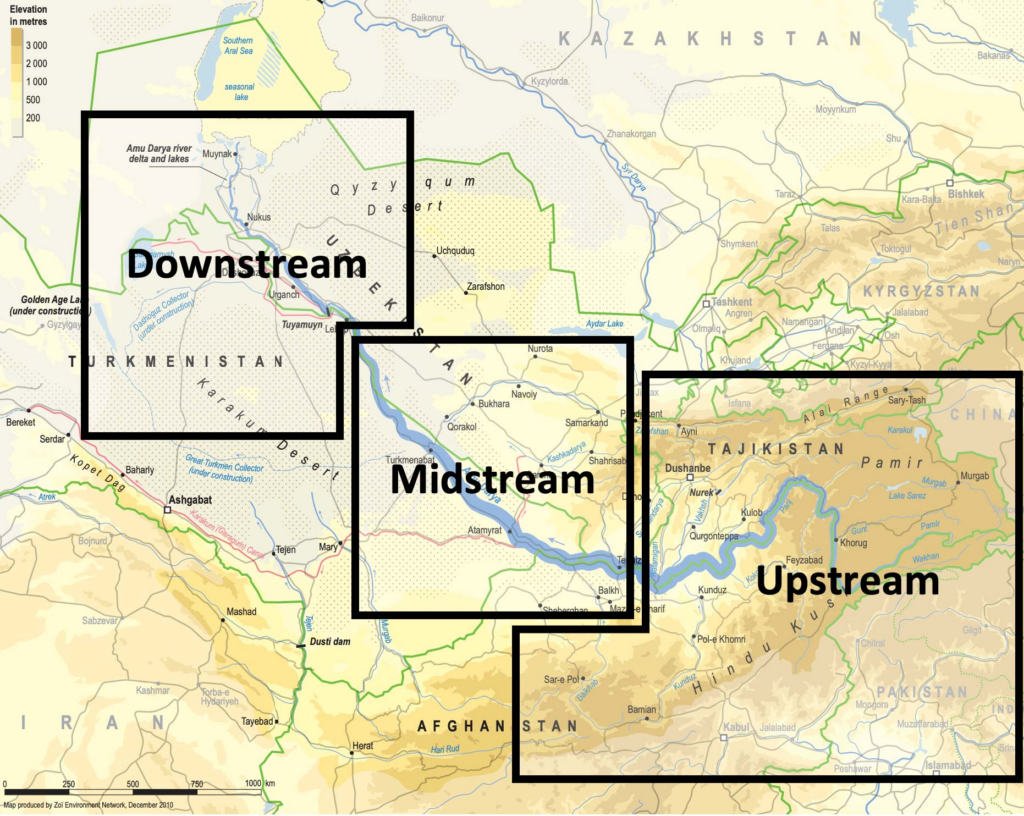
Upstream countries could accept releasing their water resources in autumn and winter since the release of the water provides them up to 90 % of their electricity via hydrodams.
Downstream countries however don’t need the water at that time but in spring and summer when their farmland needs to be irrigated.
However, in Central Asia, their seems to exist some sort of « geological justice » since downstream countries lacking water (Kazakhstan, Uzbekhistan and Turkmenistan) have vast hydrocarbon energy reserves such as coal, oil and gaz.
Therefore, not always stupid, Soviet planners, which realized that a simple quota system was insufficient to prevent conflict, created a compensation mechanism. Downstream nations, in exchange for water, would supply parts of their oil and gas to upstream nations to compensate the loss of potential energy that water represents.
However imperfect that mechanism, for want of a better one, it remained in place after the collapse of the Soviet Union in 1991.
It can be said that by appealing to an external factor of a given problem, in this case to bring energy in the equation to solve the water problem, soviet planners conceived in a rudimentary form what became known as the « Water, Energy, Food Nexus ». One cannot deal with theses factors as separate factors. They have to be conceived as part of a single, dynamic Monad.
Today, we should avoid the geopolitical trap. If we consider the water resources to be shared between the states of Central Asia and Afghanistan to be « limited », or even « declining » due to meteorological phenomena such as El Nino, we might hastily and geopolitically conclude that, with the construction of the Qosh Tepa canal, which will tap water from the Amu Daria, the « water time bomb » cannot but explode.
Solutions
So we need to be creative. We don’t have all the solutions but some ideas about where to find them:
- In Central Asia, especially in Turkmenistan but also Uzbekistan, huge quantities of water from the Abu Daria water basin are wasted. In 2021, Chinese researchers, looking at Central Asia’s potential in terms of food production, estimated that with improvements in irrigation, better seeds and other « agricultural technology », 56 % of the water can be saved farming the same crops, meaning that today, about half of the water is simply wasted.
- The lack of investment into new water infrastructure and maintenance cannot but lead to the kind of disasters the world has seen in Libya or Pakistan where, predictably, systems collapsed for lack of mere maintenance;
- Uncontrolled and controlled flooding are very primitive and inefficient forms of irrigation and should be outphased and replaced by modern irrigation techniques;
- Therefore, a water emergency should be declared and a vast international effort should assist all the countries of the Abu Daria basin, including Afghanistan, to modernize and improve the efficiency of their water infrastructure, be it lakes, canals, rivers and irrigation systems.
- Such and effort can best organized within the framework of the « One Belt, One Road » initiative and the Shanghai Cooperation Organization. BRICS countries such as China, Russia and India could help Afghanistan with data from their satellites and space programs.
- By improving the efficiency of water use, notably through targeted irrigation using « drip irrigation » as seen in the case of the Tarim basin in Xinjiang, it is possible to reduce the total amount of water used to obtain an even higher yield of agriculture production, while considerably increasing the availability of the water to be shared among neighbors. The know how and experience of African, South American, Israeli and Chinese agronomists, specialized in food production in arid countries, can play a key role.
- In the near future, Pumped Hydro Energy Storage (PHES), which means storing water in high altitude reservoirs for a later use, can massively increase the independance and autonomy of countries such as Afghanistan and others. Having sufficient water at hand at any time means also having the water security required to operate mining activities and handle thermal and nuclear electricity production units. PHES infrastructure would be greatly efficient on both sides of the Abu Daria and jointly operated among friendly nations.

Over the past 1,200 years, nations bordering waterways have concluded 3,600 treaties on the sharing of river usufructs, whether for fishing, river transport or the sharing of water for domestic, agricultural and industrial uses.
Afghanistan’s Qosh Tepa canal project is a laudable and legitimate initiative. But it is true that by breaking the status quo, it obliges a new dialogue among nations allowing each and all of them to rise to a higher level, a willing to live together increasingly the opposite to the dominant paradigm in the Anglosphere and its european followers.
It’s up to all of us to make sure it works out fine.
The science of Oases, from the Indus Valley to Persian qanats


Presentation of Karel Vereycken at the first panel discussion of the « Water for Peace » seminar organized by the Schiller Institute on January 9, 2024 in Paris.
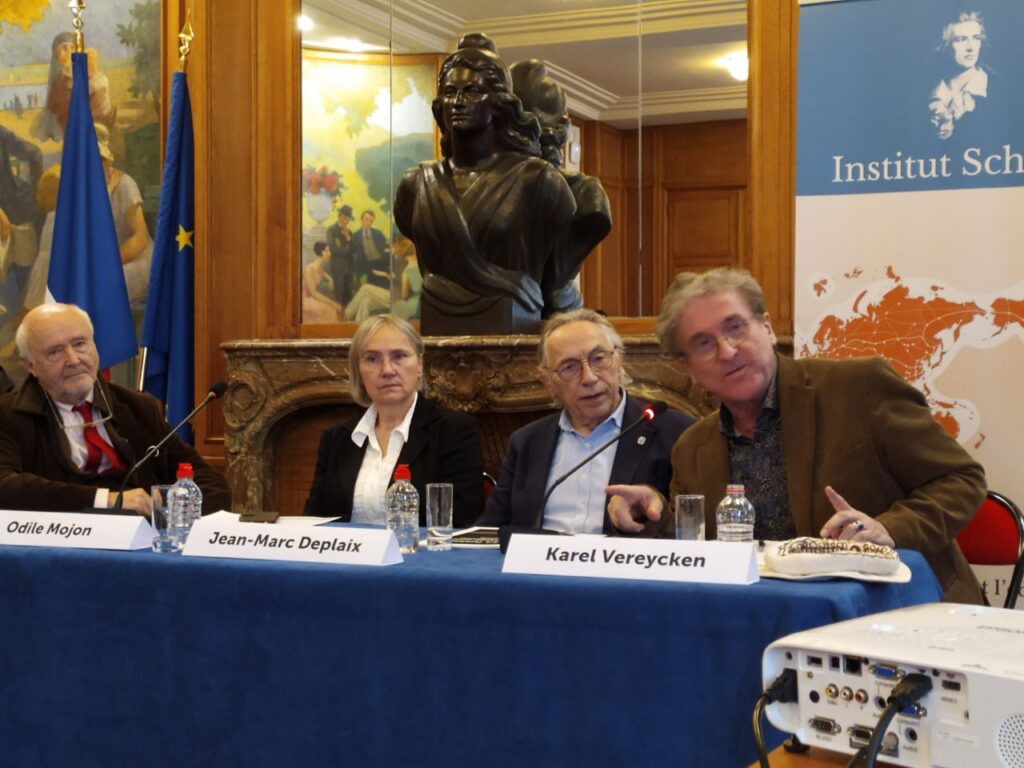
While the dog was domesticated as early as 15,000 years BC, we associate the first human activities aimed at managing water with the Neolithic period, which began around 10,000 BC.
It is thought to be the moment at which mankind moved from a « tribal subsistence economy of hunter-gatherers » to agriculture and animal husbandry, giving rise to villages and cities, where pottery, weaving, metallurgy and the arts would start blooming.
Key to this, the domestication of animals. The goat was domesticated around 11,000 BC, the cow around 9,000 BC, the sheep around -8,000 BC, and finally the horse around 2,200 BC in the steppes of Ukraine.

The oldest archaeological sites showing agricultural activities and irrigation techniques were discovered in the Indus Valley and the « Fertile Crescent ».
The site of Mehrgarh, in the Indus Valley, now Pakistan Balochistan, discovered in 1974 by François and Cathérine Jarrige, two French archaeologists, demonstrates important agricultural practices from 7000 BC onward.
Cotton, wheat and barley were grown, and beer was brewed. Cattle, sheep and goats were raised. But Mehrgarh was much more than that.

Contradicting the linear « developmental » schema, since we’re in the middle of the Neolithic, Mehrgarh is also home to the oldest pottery in South Asia and, above all, to the “Mehrgahr amulet”, the oldest bronze object casted with the « lost-wax » method.

The first seals made of terracotta or bone and decorated with geometric motifs were found here.
On the technological side, tiny bow drills were used, possibly for dental treatment, as evidenced by the pierced teeth of some skeletons found on site.
At the same time, or shortly afterwards, around 6000 B.C., Mesopotamia, between the Tigris and Euphrates rivers, witnessed rapid urban development in terms of demographics, institutions, agriculture, techniques and trade.
A veritable « fertile crescent » emerged in the region stretching from Sumer to Egypt, passing through the whole of Mesopotamia and the Levant, i.e. Syria and the Jordan Valley.
Irrigation
Whether in the Indus Valley, Mesopotamia or Egypt, the earliest irrigation techniques are nothing but retaining as much water as possible when Mother Nature has the sweet kindness to offer it to mankind.
Rainwater was collected in cisterns and, as much as possible, when snowmelt or monsoon rains swell the rivers, the objective was to amplify and steer seasonal « flooding » by canals and trenches carrying the water as far away as possible to areas to be cultivated, while at the same time protecting crops.

In Egypt, for example, where the Nile rises by around 8 meters, the water brings not only moisture but also silt to the soil near the river, providing crops with the nutrients they need to grow and thus maintain the soil’s fertility.
While the Egyptians complained about the harsh labor condition of their farmers, for the Greek historian Herodotus, this was the place in the world where work was least arduous. Of Egypt he says:
“Its soil is black and crumbly, made of silt and alluvium brought from Ethiopia by the river. Certainly, these people are today, of all the human race in Egypt as elsewhere, those who go to the least trouble to obtain their crops.
« They don’t bother to plough and weed. When the river has come of its own accord to water their fields and, its task done, has withdrawn, each man sows his land and lets the pigs loose: by trampling, the beasts sink the seeds into the earth, and the man has only to wait for the harvest.”
In Mehrgarh, where agriculture was born from 7000 BC, the work was indeed far more demanding.
However, the drainage system around the village and the rudimentary dams to control water-logging indicate that the inhabitants understood most of the basic principles involved. The cultivation of cotton, wheat and barley, as well as the domestication of animals, show that they were also familiar with canals and irrigation systems.
Constantly refined, this know-how enabled the civilization of the Indus Valley to create great cities that impress us by their modernity, notably Harappa and Mohenjo Daro, a city of 40,000 inhabitants with a public bath in its center, not a palace.
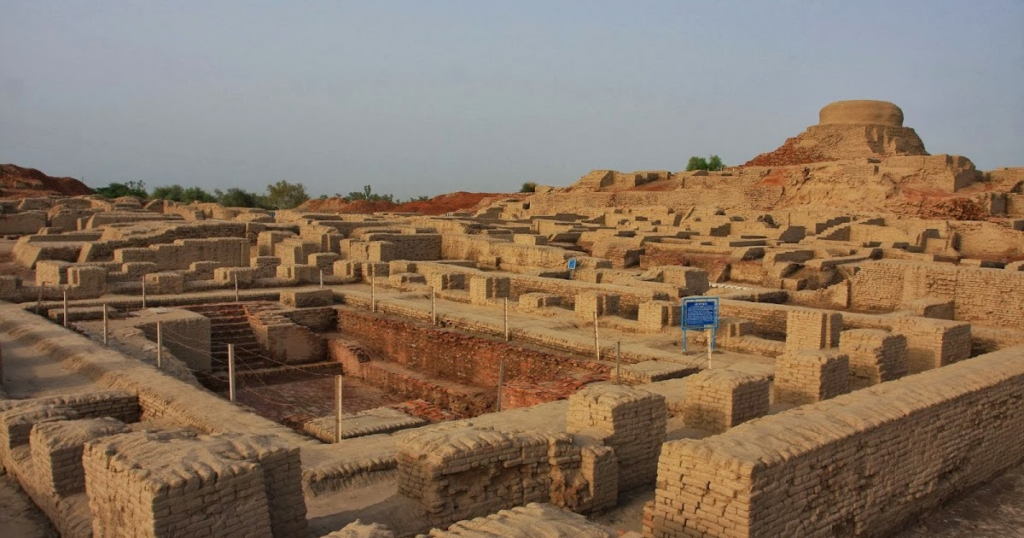
Pioneers of modern hygiene, these towns were equipped with small containers where residents could deposit their household waste.
Anticipating our « all-to-the-sewer » systems imagined in the early XVIth century by Leonardo da Vinci, for example in his plans for the new french capital of Romorantin, many towns had public water supplies as well as an ingenious sewage system.
In the port city of Lothal (now India), for example, many homes had private brick bathrooms and latrines. Wastewater was evacuated via a communal sewage system leading either to a canal in the port, or to a soaking pit outside the city walls, or to buried urns equipped with a hole for the evacuation of liquids, which were regularly emptied and cleaned.
Excavations at the Mohenjo Daro site reveal the existence of no fewer than 700 brick wells, houses equipped with bathrooms and individual and collective latrines.

Many of the city’s buildings had two floors or more. Water trickled down from cisterns installed on the roofs was channeled through closed clay pipes or open gutters that emptied into the covered sewers beneath the street.


This hydraulic and sanitary know-how was passed on to the civilization of Crete, the mother of Greece, before being implemented on a large scale by the Romans.
It was forgotten with the collapse of the Roman Empire, only to return during the Renaissance.
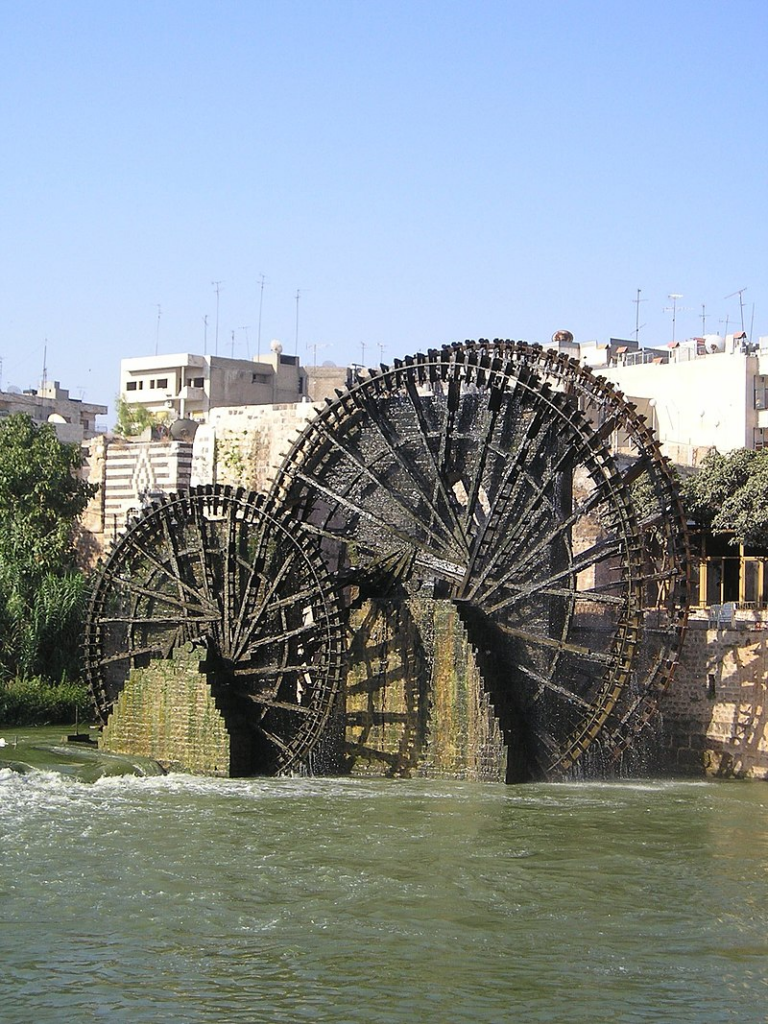
The first human contributions were aimed at maximizing water reservoirs and their gravity-flow capacity. To achieve this, it was necessary to transfer water from a lower level to higher ground and build « water towers ».
To this end, the Mesopotamian « chadouf » was widely used in Egypt, followed by the « Archimedean screw ».
Next came the « saquia » or « Persian wheel », a geared wheel driven by animal power, and finally the « noria », the best-known water-drawing machine, powered by the river itself.
Persian qanats
Before Alexander the Great, Persia’s Achaemenid Empire (6th century BC) developed the technique of underground qanats or underground aqueducts. This « draining gallery” cut into the rock or built by man, is one of the most ingenious inventions for irrigation in arid and semi-arid regions.
Whatever displeases our environmentalist friends, it’s not nature that magically produces « oases » in the desert.
It’s a scientific man who digs a drainage gallery from a water table close enough to the ground surface, or sometimes from an aquifer that flows into the desert.
On the website of ArchéOrient, archaeologist Rémy Boucharlat, Director of Emeritus Research at the French CNRS, an expert on Iran, explains:
« Whatever the origin of the water, deep or shallow, the gallery construction technique is the same. The first step is to identify the presence of the water, either its underflow near a river, or the presence of a deeper water table on a foothill, which requires the science and experience of specialists.
A motherwell reaches the upper part of this layer or water table, which indicates the depth at which the gallery should be dug. The slope of the gallery must be very shallow, less than 2‰, to ensure a calm and regular flow of water, and to gradually lead the water to the surface, at a gradient much lower than the slope of the piedmont.
The gallery is then excavated, not from the mother well, as it would be flooded immediately, but from downstream, from the arrival point. The pipe is first dug as an open trench, then covered, and finally gradually tunnelled into the ground.
Shafts are dug from the surface at regular intervals, between 5 and 30 m depending on the nature of the terrain, to evacuate soil and provide ventilation during excavation, and to mark the direction of the tunnel.”

Historically, the majority of the populations of Iran and other arid regions of Asia and North Africa depended on the water supplied by qanats; settlement areas thus corresponded to the places where their construction was possible.
The technique offers a significant advantage: as the water moves through an underground conduit, not a drop of water is lost through evaporation.
This technique spread throughout the world under various names: qanat and kareez in Iran, Syria and Egypt, kariz, kehriz in Pakistan and Afghanistan, aflaj in Oman, galeria in Spain, kahn in Balochistan, kanerjing in China, foggara in North Africa, khettara in Morocco, ngruttati in Sicily, bottini in Siena, etc.).
Improved by the Greeks and amplified by the Etruscans and the Romans, the qanats technique was carried by the Spaniards across the Atlantic to the New World, where numerous underground canals of this type still operate in Peru, Chile and western Mexico.
After Alexander the Great, Bactria, covering parts of today’s Uzbekistan, Turkmenistan and the northern part of Afghanistan, was even known as the « Oasis civilization » or the “Land of a 1000 Golden Cities”.
Iran boasts it had the highest number of qanats in the world, with approximately 50,000 qanats covering a total length of 360,000 km, about 9 times the circumference of the Earth !
Thousands of them are still operational but increasingly destabilized by erratic well digging and demographic overconcentration.
Shared responsability
In 1017, the Baghdad-based hydrologist Mohammed Al-Karaji provided a detailed description of qanat construction and maintenance techniques, as well as legal considerations about the collective management of wells and pipes.

While each qanat is designed and supervised by a mirab (dowser-hydrologist and discoverer), building a qanat is a collective task that takes several months or years for a village or group of villages. The absolute necessity of collective investment in the infrastructure and its maintenance calls for a superior notion of the common good, an indispensable complement to the notion of private property that rains and rivers are not accustomed to respecting.
In North Africa, the management of water distributed by a khettara (the local name for qanâts) is governed by traditional distribution norms known as « water rights ».
Originally, the volume of water granted per user was proportional to the work involved in building the khettara, and translated into an irrigation period during which the beneficiary could use all the khettara’s flow for his or her fields. Even today, when the khettara has not dried up, this rule of water rights still applies, and a share can be bought or sold. The size of each family’s fields to be irrigated must also be taken into account
All of this demonstrates that good cooperation between man and nature can do miracles if man decides so.
Thank you for your attention and questions welcome!

Derrière les « chevaux célestes » chinois, la science terrestre


Le fait qu’aujourd’hui encore, en parlant d’une voiture, on utilise l’unité « cheval » (CV) pour indiquer la puissance et donc le « travail » que le moteur peut fournir, en dit long sur le rôle majeur que les chevaux ont joué dans l’histoire de l’humanité.
Récemment invité à une conférence à Kaboul, en Afghanistan, j’ai évoqué à propos du besoin d’investissement en infrastructures hydrauliques, la domestication du cheval comme un bel exemple du passage d’une « plateforme infrastructurelle donnée » à une « plateforme supérieure », le terme plateforme faisant référence ici non pas à l’impact direct de l’infrastructure en question, mais à l’effet beaucoup plus large induit dans l’ensemble de l’économie d’un pays.
Nul besoin d’être anthropologue pour comprendre que l’histoire de l’humanité a radicalement changé avec la domestication du cheval, certaines choses considérées comme impossibles auparavant devenant, du jour au lendemain, la normalité.
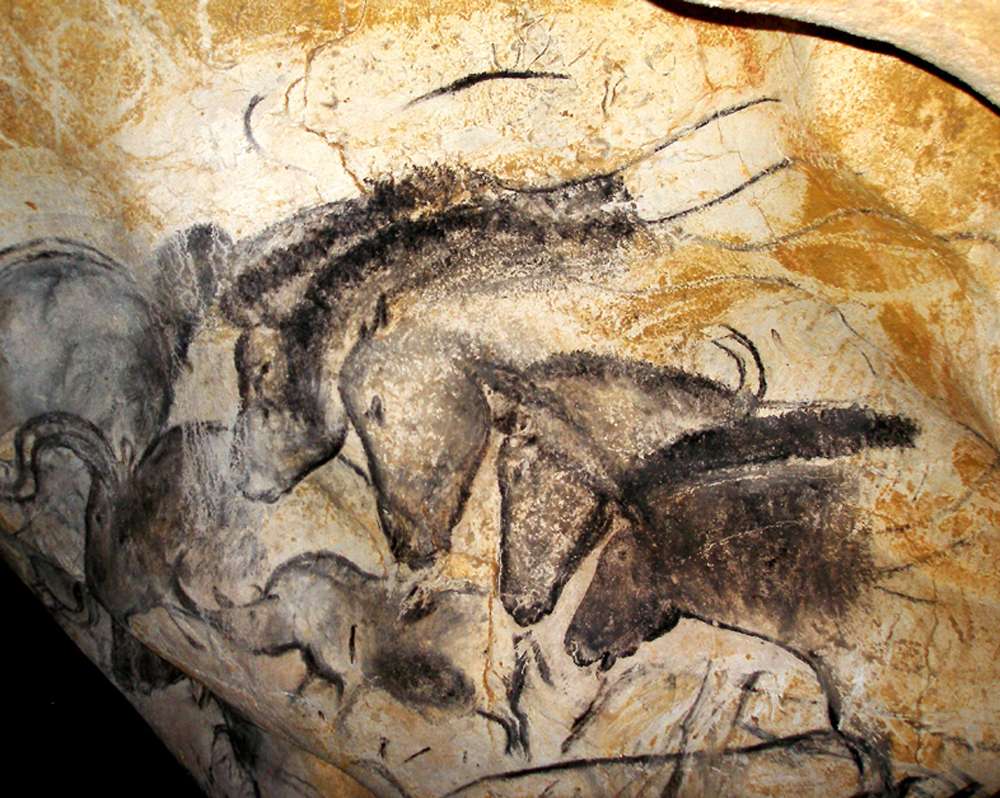
La question de savoir quand et comment l’animal a été domestiqué reste sujet à controverse. Bien que des chevaux apparaissent dans l’art rupestre du paléolithique dès 36 000 ans avant notre ère (grotte Chauvet, France), il s’agissait alors de chevaux sauvages sans doute chassés pour leur viande.
Pour les zoologistes, la domestication se définit comme la maîtrise de l’élevage, pratique confirmée par des restes de squelettes anciens indiquant des changements dans la taille et la variabilité des populations de chevaux anciens.
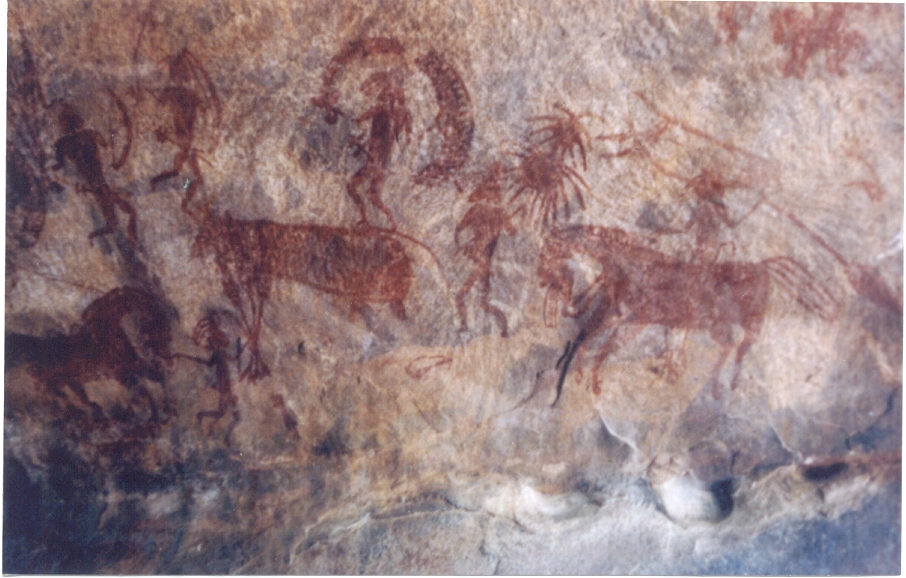
D’autres chercheurs s’intéressent à des éléments plus généraux de la relation homme-cheval, notamment les preuves squelettiques et dentaires de l’activité professionnelle, les armes, l’art et les artefacts spirituels, ainsi que les modes de vie. Il est prouvé que les chevaux furent une source de viande et de lait avant d’être dressés comme animaux de travail.
En Inde, près de Bhopal, les abris-sous-roche du Bhimbetka, qui constituent le plus ancien art rupestre connu du pays (100 000 av. JC)), représentent des scènes de danse et de chasse de l’âge de pierre ainsi que des guerriers à cheval d’une époque plus tardive (10 000 av. JC).

Les preuves les plus évidentes de l’utilisation précoce du cheval comme moyen de transport sont les sépultures présentant des chevaux avec leurs chars. Les plus anciens vrais chars, datant d’environ 2000 av. JC, ont été retrouvés dans des tombeaux de la culture de Sintachta, dans des sites archéologiques situés le long du cours supérieur de la rivière Tobol, au sud-est de Magnitogorsk en Russie. Il s’agit de chars à roues à rayons tirés par deux chevaux.
Kazakhstan et Ukraine

Jusqu’à récemment, on pensait que le cheval le plus communément utilisé aujourd’hui était un descendant des chevaux domestiqués par la culture de Botaï, vivant dans les steppes de la province d’Akmola au Kazakhstan.
Cependant, des recherches génétiques récentes (2021) indiquent que les chevaux de Botaï ne sont que les ancêtres du cheval de Przewalski, une espèce qui a failli disparaître.
Selon les chercheurs, notre cheval commun, Equus ferus caballus, aurait été domestiqué il y a 4200 ans en Ukraine, dans la région du Don-Volga, c’est-à-dire la steppe pontique-caspienne de l’Eurasie occidentale, vers 2200 av. JC. Au fur et à mesure de leur domestication, ces chevaux ont été régulièrement croisés avec des chevaux sauvages.
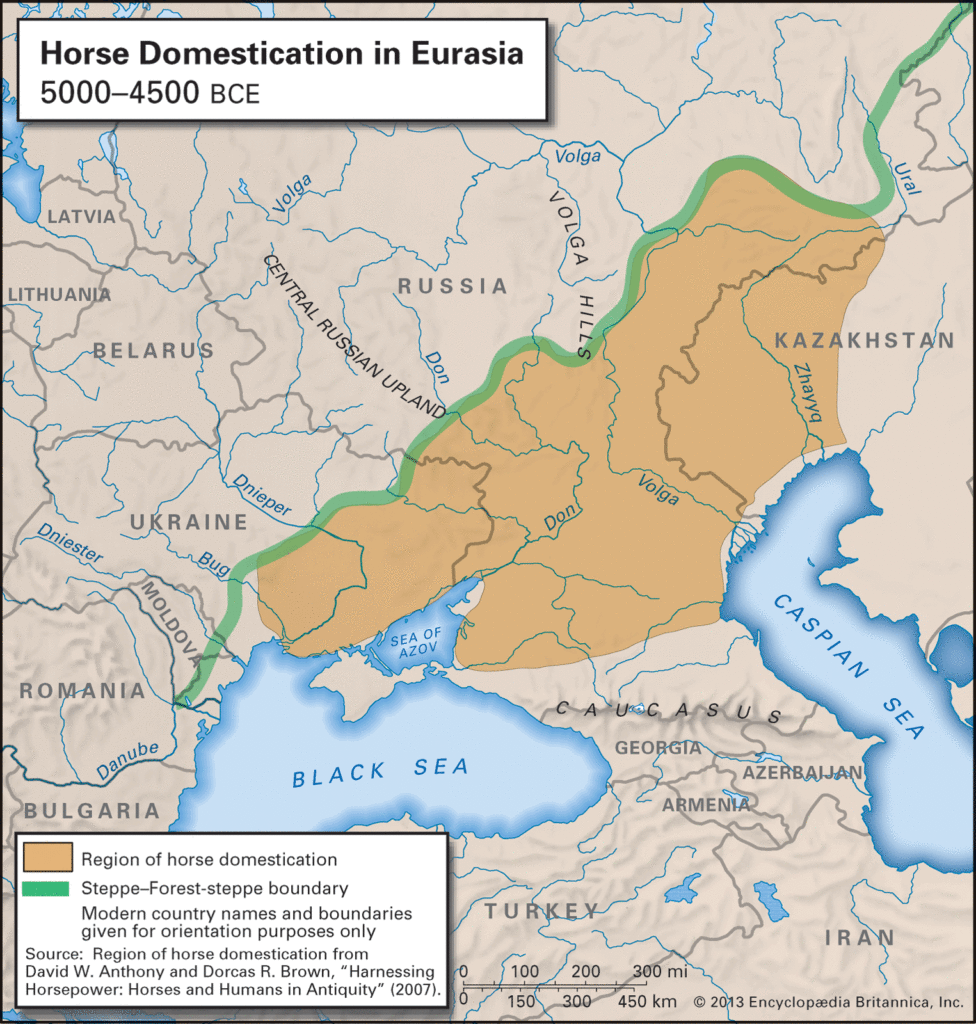
Il est intéressant de noter à cet égard que, selon « l’hypothèse kourgane » formulée par Marija Gimbutas en 1956, c’est depuis cette région que la plupart des langues indo-européennes se sont répandues dans toute l’Europe et certaines parties de l’Asie.
Le nom vient du terme russe d’origine turque, « kourgane », qui désigne les tumuli caractéristiques de ces peuples et qui marquent leur expansion en Europe.
La Route du thé, du cheval ou de la soie?
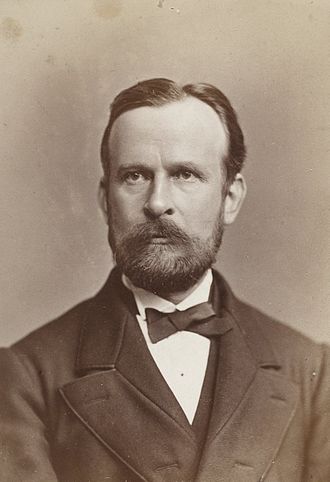
La description des échanges commerciaux, culturels et humains tout au long des « Routes de la soie » a fait couler beaucoup d’encre. Or, ce terme est récent. Ce n’est qu’en 1877 que le géographe allemand Ferdinand von Richthofen l’utilise pour la première fois afin de désigner ces axes Est-Ouest structurant les échanges mondiaux.
En réalité, il s’avère que l’une des principales marchandises échangées sur ladite Route de la soie était… les chevaux et autres animaux de labour (mules, chameaux, ânes et onagres).
Si l’on y échangeait effectivement la soie et le thé, ces produits constituaient, comme la porcelaine et l’or, un moyen pour régler d’autres achats, notamment les chevaux que les Chinois cherchaient à acquérir.
Ce que l’on appelait la « Route du thé et du cheval » (route de la soie du sud) partait de la ville de Chengdu, dans la province du Sichuan, en Chine, traversait le Yunnan vers le sud, jusqu’en Inde et dans la péninsule indochinoise, et s’étendait vers l’ouest jusqu’au Tibet.
C’était une route importante pour le commerce du thé en Chine du Sud et en Asie du Sud-Est, et elle a contribué à la diffusion de religions comme le taoïsme et le bouddhisme dans la région. Il est vrai que « Route de la soie » est plus poétique que « route du crottin » !
La Steppe et ses nomades


Constamment harcelée par les peuples nomades des steppes du Nord, la Chine entreprit la construction de sa Grande Muraille dès le VIIe siècle av. JC.
La liaison entre les premiers éléments fut réalisée par Qin Shi Huang (220-206 avant JC.), le premier empereur de Chine, et l’ensemble du mur, achevé sous la dynastie des Ming (1368-1644), est devenu l’un des exploits les plus remarquables de l’histoire humaine.
Le terme générique de « nomades eurasiens » englobe les divers groupes ethniques peuplant la steppe eurasienne, se déplaçant à travers les steppes du Kazakhstan, du Kirghizistan, du Tadjikistan, du Turkménistan, d’Ouzbékistan, de Mongolie, de Russie et d’Ukraine.
En domestiquant le cheval vers 2200 av. JC., ces peuples augmentèrent considérablement les possibilités de vie nomade.

Par la suite, leur économie et leur culture se concentrèrent sur l’élevage de chevaux, l’équitation et le pastoralisme nomade, permettant de riches échanges commerciaux avec les peuples sédentaires vivant en bordure de la steppe, que ce soit en Europe, en Asie ou en Asie centrale.
On pense qu’ils opéraient souvent sous forme de confédérations. Par définition, les nomades ne créent pas d’empires. Sans forcément les occuper, en contrôlant les points névralgiques, ils règnent en maître sur d’immenses territoires.
Ce sont eux qui développèrent le char, le chariot, la cavalerie et le tir à l’arc à cheval, introduisant des innovations telles que la bride, le mors, l’étrier et la selle, qui traversèrent rapidement toute l’Eurasie et furent copiées par leurs voisins sédentaires.
Durant l’âge du fer, des cultures scythes (iraniennes) apparurent parmi les nomades eurasiens, caractérisées par un art distinct, dont la joaillerie en or force l’admiration.
Le cheval en Chine

Les objets funéraires chinois fournissent une quantité extraordinaire d’informations sur le mode de vie des Chinois de l’Antiquité. La cavalerie militaire, mise sur pied dès le IIIe siècle avant J.C., s’y développe afin de faire face aux guerriers nomades et archers à cheval qui menacent la Chine le long de sa frontière septentrionale. Leurs grands et puissants chevaux étaient nouveaux pour les Chinois.
Échangés contre de la soie de luxe, comme nous l’avons dit, ils sont la première importation majeure en Chine depuis la Route de la soie. Des vestiges archéologiques montrent qu’en l’espace de quelques années, les merveilleux destriers arabes deviennent extrêmement populaires auprès des militaires et des aristocrates chinois, et les tombes des classes supérieures sont remplies de représentations de ces grands chevaux destinés à être utilisés dans l’au-delà. Ils restent cependant difficiles à trouver sur place…
Les diplomates chinois et le royaume de Dayuan (Ferghana)

À la fin du IIe siècle av. JC., Zhang Qian, diplomate et explorateur de la dynastie Han, se rend en Asie centrale et découvre trois civilisations urbaines sophistiquées créées par des colons grecs appelés Ioniens.
Le récit de sa visite en Bactriane, et son étonnement d’y trouver des marchandises chinoises sur les marchés (acquises via l’Inde), ainsi que ses voyages en Parthie et au Ferghana, sont conservés dans les œuvres de Sima Qian, l’historien des premiers Han.

À son retour, son récit incite l’empereur chinois à envoyer des émissaires à travers l’Asie centrale pour négocier et encourager le commerce avec son pays. « Et c’est ainsi que naquit la route de la soie », affirment certains historiens.

Outre la Parthie et la Bactriane, Zhang Qian visite, dans la fertile vallée de Ferghana (aujourd’hui essentiellement au Tadjikistan), un État que les Chinois baptisèrent le royaume de Dayuan (« Da » signifiant « grand » et « Yuan » étant la translittération du sanskrit Yavana ou du pali Yona, utilisé dans toute l’Antiquité en Asie pour désigner les Ioniens, ou colons grecs).
Les Actes du grand historien et le Livre des Han décrivent Dayuan comme un pays de plusieurs centaines de milliers d’habitants, vivant dans 70 villes fortifiées de taille variable.
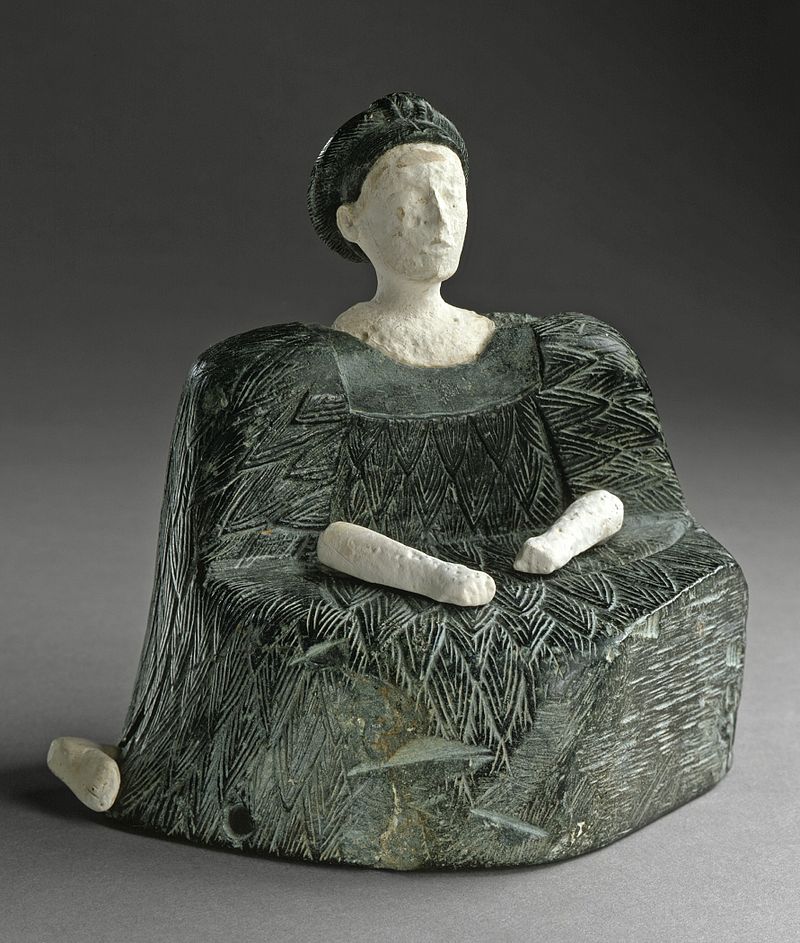
Ils cultivent le riz et le blé et produisent du vin à partir de leurs vignes. Ils avaient des traits caucasiens et des « coutumes identiques à celles de la Bactriane » (l’État le plus hellénistique de la région depuis Alexandre le Grand), dont l’épicentre se trouve alors au nord de l’Afghanistan. (voir notre article)
En outre, le diplomate chinois rapporte un fait d’un grand intérêt stratégique : la présence, dans la vallée de la Ferghana, de chevaux incroyables, rapides et puissants, élevés par ces Ioniens !

Or, comme nous l’avons déjà dit, la Chine, se sentant menacée en permanence par les peuples nomades des steppes, était en train de construire sa Grande Muraille. Elle avait également conscience de son infériorité militaire par rapport aux nomades des steppes et déplorait son manque cruel de puissants chevaux.
Sans oublier que, dans l’échelle des valeurs chinoises, le cheval possédait une valeur spirituelle et symbolique presque aussi forte que le dragon : il pouvait voler et représentait l’esprit divin et créatif de l’univers lui-même, chose essentielle pour tout empereur désireux d’acquérir aussi bien la sécurité militaire pour son empire que son immortalité personnelle.
Bref, posséder de bons chevaux est alors une question allant au-delà de la sécurité nationale, tout en l’incluant. À tel point qu’en 100 av. JC., lorsque le souverain de la vallée de Ferghana refuse de lui fournir des chevaux de qualité, la dynastie Han déclenche contre Dayuan la « guerre des chevaux célestes ».
Guerre des chevaux célestes
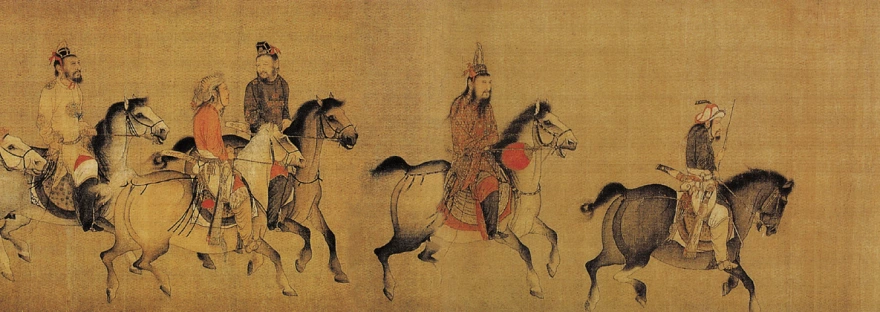
C’est un conflit militaire qui se déroule entre 104 et 102 av. JC. entre la Chine et Dayuan, Etat peuplé d’Ioniens (entre l’Ouzbékistan, le Kirghizstan et le Tadjikistan actuels
Tout d’abord, l’empereur Wu décide d’infliger une défaite décisive aux nomades des steppes, les Xiongnu, qui harcèlent la dynastie Han depuis des décennies.
Pour les faire plier, en 139 av. JC, il envoie le diplomate Zhang Qian avec pour mission d’arpenter l’ouest et d’y forger une alliance militaire avec les nomades chinois Yuezhi contre les Xiongnu.
Zhang Qian, comme nous l’avons dit, se rend en Parthie, en Bactriane et à Dayuan. À son retour, il impressionne l’empereur en lui décrivant les « chevaux célestes » de la vallée de Ferghana, qui pourraient grandement améliorer la qualité des montures de la cavalerie Han lors des combats contre les Xiongnu.
La cour des Han envoie alors jusqu’à dix groupes de diplomates pour acquérir ces « chevaux célestes ».
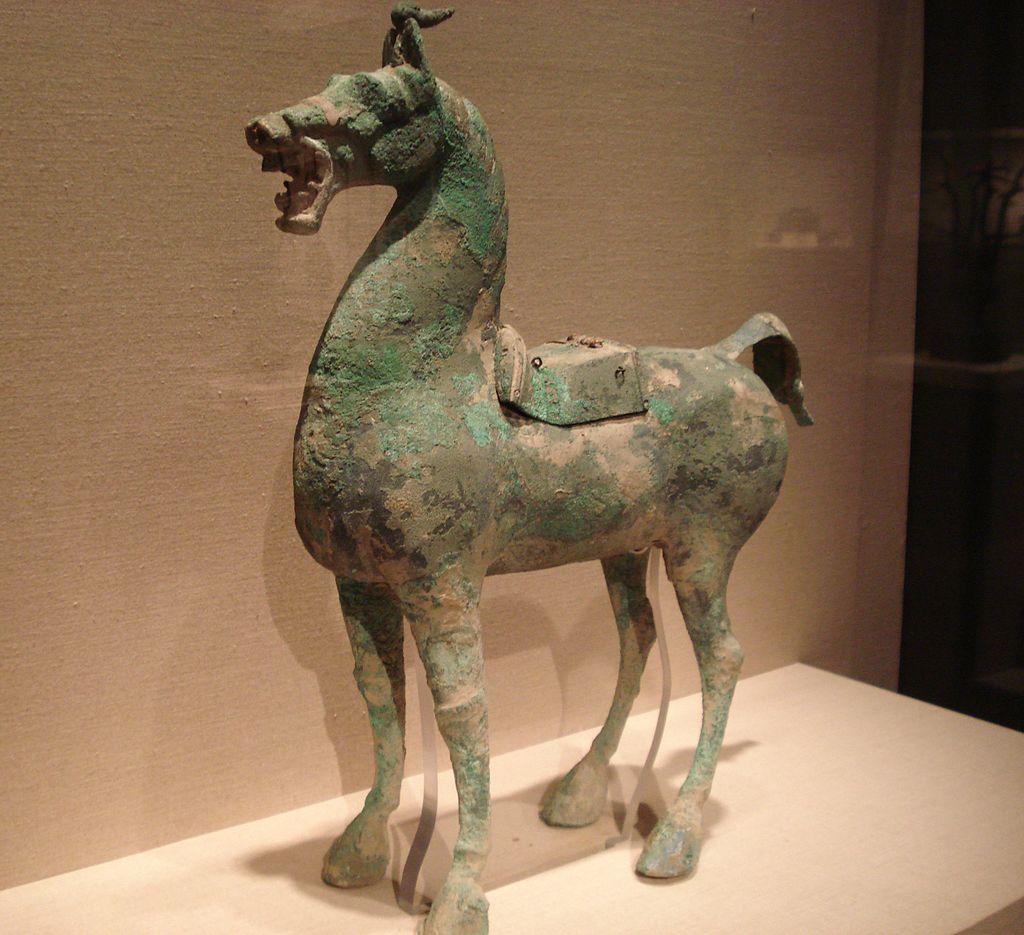
Une mission commerciale et diplomatique arrive donc à Dayuan avec 1000 pièces d’or et un cheval d’or pour acheter les précieux animaux. Dayuan, qui était à cette époque l’un des États les plus occidentaux à avoir des émissaires à la cour des Han, commerce déjà avec eux depuis un certain temps à son grand avantage. Non seulement sa population accède aux marchandises orientales, mais apprend des soldats Han la fonte des métaux pour fabriquer des pièces et des armes. Cependant, contrairement aux autres envoyés à la cour des Han, ceux de Dayuan ne se conforment pas aux rituels des Han et se montrent arrogants, pensant que leur pays est trop éloigné pour avoir à craindre une invasion.
Dès lors, dans un élan de folie et par pure arrogance, le roi du Dayuan non seulement refuse le marché, mais confisque l’or. Les envoyés des Han maudissent les hommes de Dayuan et brisent le cheval d’or qu’ils avaient amené. Furieux de cet acte de mépris, les nobles de Dayuan ordonnent aux militaires de Yucheng, qui se trouvent à leur frontière orientale, d’attaquer les envoyés, de les tuer et de s’emparer de leurs marchandises.
Humiliée et furieuse, la cour des Han envoie alors une armée dirigée par le général Li Guangli pour soumettre Dayuan, mais leur première incursion s’avère mal organisée et insuffisamment approvisionnée.
Deux ans plus tard, une seconde expédition, plus importante et mieux approvisionnée, parvient à assiéger la capitale des Dayuan, « Alexandria Eschate » (aujourd’hui proche de Khodjent, au Tadjikistan), forçant les Dayuan à se rendre sans condition.
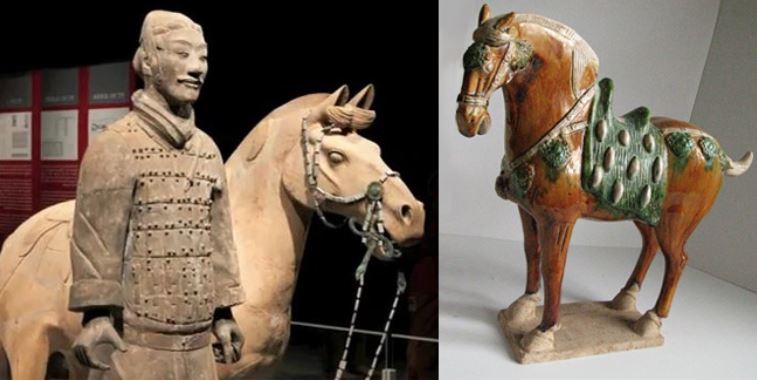
Les forces expéditionnaires y installent alors un régime pro-Han et repartent avec 3000 chevaux. Il n’en restera que 1000 à leur arrivée en Chine, en 101 av. JC.
Le Dayuan accepte également d’envoyer chaque année deux chevaux célestes à l’empereur et des semences de luzerne sont ramenées en Chine, fournissant des pâturages de qualité supérieure pour élever de beaux chevaux afin de fournir une cavalerie capable de faire face aux Xiongnu qui menacent le pays.
Les chevaux ont depuis lors captivé l’imagination populaire en Chine, inspirant des sculptures, faisant l’objet d’élevage dans le Gansu et dotant la cavalerie de 430 000 chevaux de ce type sous la dynastie des Tang.
La Chine et la Révolution agricole
Après avoir imposé son rôle dans la stratégie militaire pour les siècles à venir, le cheval devient, avec la maîtrise de l’eau, le facteur clé permettant d’accroître la productivité agricole.
Contrairement aux Romains, qui préféraient utiliser du « bétail humain » (esclaves) plutôt que des animaux (qu’ils élevaient pour les courses), les Chinois ont contribué de façon décisive à la survie de l’humanité avec deux innovations cruciales concernant l’attelage des chevaux.
Rappelons que pendant toute l’Antiquité, que ce soit en Égypte ou en Grèce, charrues et chariots sont tirés à l’aide d’une bande de cuir encerclant le cou de l’animal.
Cet attelage s’apparente au joug utilisé pour les bœufs, la charge étant attachée au sommet du collier, au-dessus du cou. Le cheval se trouvant ainsi constamment étranglé, ce système réduit considérablement sa capacité à travailler, et plus il tire, plus il a du mal à respirer.
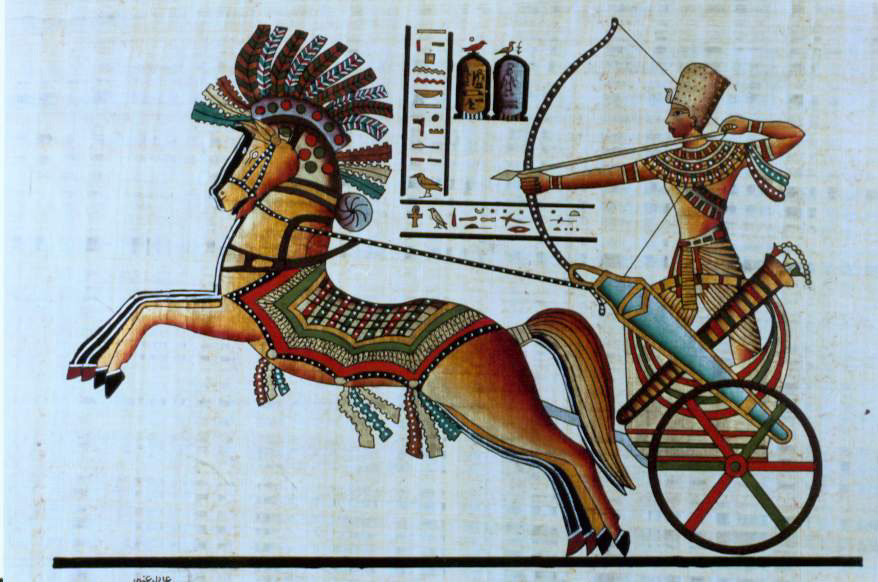
En raison de cette contrainte physique, le bœuf restera l’animal préféré pour les travaux lourds tels que le labourage. Cependant, il est lent, difficile à manœuvrer et n’a pas l’endurance du cheval, qui est deux fois supérieure pour une puissance équivalente.
La Chine aurait d’abord inventé la « bricole », large courroie de cuir enserrant le poitrail du cheval, ce qui était un premier pas dans la bonne direction.
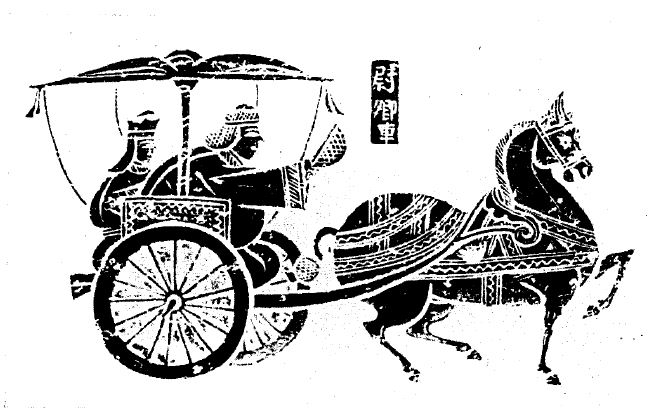
Au Ve siècle, la Chine invente « le collier d’épaule », conçu comme un ovale rigide qui s’adapte au cou et aux épaules du cheval sans lui couper le souffle.
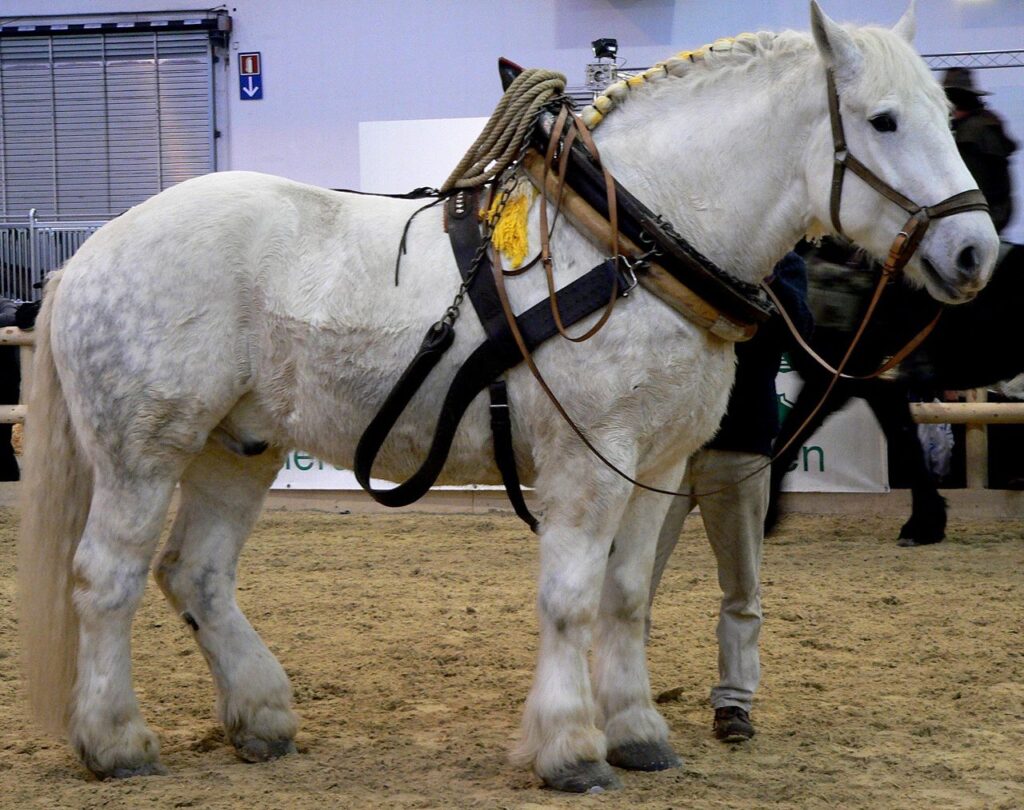
Il présente les avantages suivants :
— Il soulage la pression exercée sur la gorge du cheval, libérant les voies respiratoires de toute constriction, ce qui améliore considérablement le débit d’énergie de l’animal.
— Les traits peuvent être attachés de chaque côté du collier, ce qui permet au cheval de pousser sur ses pattes postérieures, plus puissantes, au lieu de tirer avec celles de devant, plus faibles.
Vous me direz qu’il s’agit là d’une simple anecdote. Vous avez tort, car ce qui semble n’être qu’un changement mineur aura des conséquences gigantesques.
La Renaissance européenne

Dans le cadre d’une alliance stratégique et d’une coopération avec le califat humaniste des Abbassides de Bagdad (voir notre article), Charlemagne et ses successeurs ont défriché de vastes terrains pour l’agriculture, amélioré l’usage de l’eau et généralisé le collier d’épaule pour les chevaux de trait.
Grâce à ce nouvel outil beaucoup plus efficace, les agriculteurs européens ont pu tirer pleinement parti de la force du cheval, qui sera alors capable de tirer une autre innovation récente, la lourde charrue. Cela s’est avéré particulièrement appréciable pour les sols durs et argileux, ouvrant de nouvelles terres à l’agriculture.
Le collier, la charrue lourde et le fer à cheval ont contribué à l’essor de la production agricole.
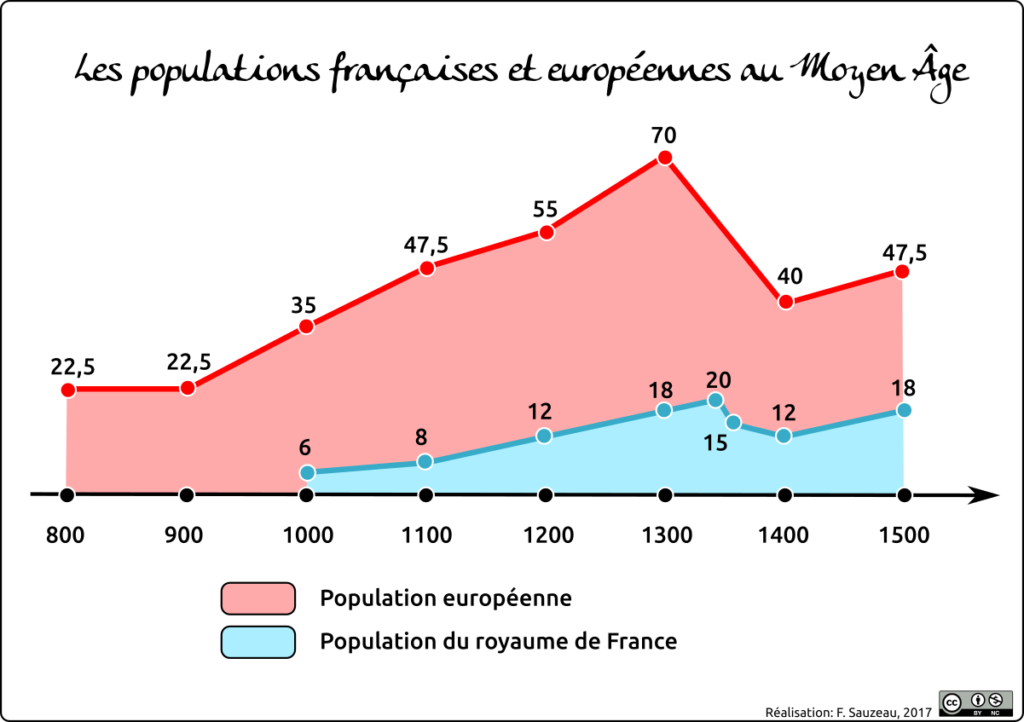
Ainsi, entre l’an 1000 et l’an 1300, on estime qu’en Europe, les rendements agricoles ont triplé, permettant de nourrir un nombre croissant de citoyens dans les villes urbaines apparues au XVe siècle et de donner le coup d’envoi à la Renaissance européenne. Merci la Chine !
Certains chiffres laissent néanmoins perplexes :
–Il aura fallu des milliers d’années à l’humanité pour domestiquer le cheval, en 2200 av. JC. (bien après la vache).
— Il faudra encore 2700 ans à l’humanité pour trouver, au Ve siècle de notre ère, la façon la plus efficace d’utiliser sa force motrice…
Le passage d’une plateforme d’infrastructure inférieure à une plate-forme d’infrastructure supérieure peut certes prendre un certain temps. Les nouvelles plateformes supérieures d’aujourd’hui s’appellent l’espace et l’énergie de fusion.
N’attendons pas encore un millénaire pour savoir comment les utiliser correctement !
Horse-power, the Earthly Science behind China’s “Heavenly Horses”


Indicating the major role horses have played in the history of mankind, the fact that still today, when people talk about the engine of their cars, they use the term “horsepower” (hp) to indicate how much “work” the engine is capable of.
In a lecture on hydro-infrastructure in Kabul, Afghanistan, I recently used the domestication of the horse as an example of what one should understand when we talk about moving from a “lower” to a “higher infrastructure platform”.
The history of mankind completely changed with the domestication of the horse. Things considered “impossible” before the domestication of the horse became the “new normal”. How and when horses became domesticated has been disputed. Although horses appear in Paleolithic cave art as early as 36,000 BC (Chauvet cave, France), these were wild horses and were probably hunted for meat.

Zoologists define « domestication » as human control over breeding, which can be detected in ancient skeletal samples by changes in the size and variability of ancient horse populations. Other researchers look at the broader evidence, including skeletal and dental evidence of working activity; weapons, art, and spiritual artifacts; and lifestyle patterns of human cultures. There is evidence that horses were kept as a source of meat and milk before they were trained as working animals.

In India, close to Bopal, the “Bhimbetka rock shelters”, which are the oldest known rock art of the country, figures dance and hunting scenes from the Stone Age as well as of warriors on horseback from a later time (10 000 BC).
Horses were a late addition to the barnyard. Dogs were domesticated 15,000 years ago; sheep, pigs and cattle, about 8,000 to 11,000 years ago. But clear evidence of horse domestication doesn’t appear in the archaeological record until about 5,500 years ago.

The clearest evidence of early use of the horse as a means of transport is from chariot burials. The earliest true chariots known are from around 2,000 BC, in burials of the Sintashta-Petrovka culture in modern Russia in a cluster along the upper Tobol river, southeast of Magnitogorsk.
They contain spoke-wheeled chariots drawn by teams of two horses.
Kazakhstan and Ukraine

Up till recently, it was thought that the most common horse used today was a descendant of the horses domesticated by the Botai culture living in the steppes of the Akmola Province of Kazakhstan, around 3500 BC.
Recent genetic research points to the fact that the Botai horses were the forefathers of the Przewalski horse, a species that nearly disappeared.
Our common horse, the Equus ferus caballus, genetic research says, has been domesticated 4,200 years ago in Ukraine, in an area known as the Volga-Don, in the Pontic-Caspian steppe region of Western Eurasia, around 2,200 BC.
As these horses were domesticated, they were regularly interbred with wild horses.

Interesting in this respect, is the fact that according to the “Kurgan” or “steppe hypothesis”, most Indo-European languages spread from the same region throughout Europe and parts of Asia.
It postulates that the people of a Kurgan culture in the Pontic steppe north of the Black Sea were the most likely speakers of what some call the Proto-Indo-European language (PIE).
The term is derived from the Turkic word kurgan, meaning tumulus or burial mound.
Tea Road, Horse Road or Silk Road?


As a matter of fact, the main commodities traded on the “Silk Road” (a term only coined in 1877 by the German geographer Ferdinand Von Richthofen), were… horses, mules, camels, donkeys and onagers.
Silk and tea were of course traded, but appeared mainly as a means… to pay for horses. People “paid” with silk, gold, porcelain and tea, the animals they needed to secure the survival of their society!
What was known as the « Tea-Horse Road » (Southern Silk Road) extended from the city of Chengdu in Sichuan Province, China, south through Yunnan into India and the Indochina Peninsula, and extended westwards into Tibet. It was an important route for the tea trade throughout South China and Southeast Asia and contributed to the spread of religions like Taoism and Buddhism across the region.
Eurasian Steppe

China, feeling itself under constant threat from the nomadic steppe people from the North, started building the first parts of its “Great Wall” as early as the VIIth Century BC, with selective stretches joined by Qin Shi Huang (220–206 BC), the first emperor of China and completed under the Ming dynasty (1368–1644) to become one of the most impressive feats in history.
The Eurasian nomads were groups of nomadic peoples living throughout the Eurasian Steppe. The generic title encompasses the varied ethnic groups who have at times inhabited the steppes of Kazakhstan, Kyrgyzstan, Tajikistan, Turkmenistan, Uzbekistan, Mongolia, Russia, and Ukraine.
By the domestication of the horse around 2,200 BC (i.e. 4,200 years ago), they vastly increased the possibilities of nomadic life and subsequently their economy and culture emphasized horse breeding, horse riding, and nomadic pastoralism, usually engaging in trade with settled peoples around the steppe edges, be it in Europe, Asia or Central Asia.

Nomads, by definition, don’t create empires. It is thought they operated often as confederations. But it was them who developed the chariot, wagon, cavalry, and horseback archery and introduced innovations such as the bridle, bit, stirrup, and saddle and the very rapid rate at which innovations crossed the steppe-lands spread these widely, to be copied by settled peoples bordering the steppes.
During the Iron Age, Scythian (Persian) culture emerged among the Eurasian nomads, which was characterized by a distinct Scythian art.
China and the Horse

Throughout China’s long and storied past, no animal has impacted its history as greatly as the horse. Its significance was such that as early as the Shang dynasty (ca.1600-1100 BC), military might was measured by the number of the war chariots available to a particular kingdom.
The mounted cavalery, which emerged in the IIIrd century BC grew rapidly during the IInd century BC to meet the challenge of horse-riding peoples threatening China along the northern frontier.
Their large, powerful, horses were very new to China. As said before, traded for luxurious silk, they were the first major import to China from the “Silk Road.”
Chinese grave goods provide extraordinary amounts of information about how the ancient Chinese lived. Archaeological evidence shows that within a few years, the marvelous Arabian steeds had become immensely popular with military and aristocracy alike and upper-class tombs began to be filled with images of these great horses for use in the afterlife. But horses were hard to find in China.
Chinese diplomats and the Kingdom of Dayuan (Ferghana)

Something had to be done. In the late IInd Century BC, Zhang Qian, a Han dynasty diplomat and explorer, travels to Central Asia and discovers three sophisticated urban civilizations created by Greek settlers he named « Ionians ». The account of his visit to Bactria, including his recollection of his amazement at finding Chinese goods in the markets (acquired via India), as well as his travels to Parthia and Ferghana, are preserved in the works of the early Han historian Sima Qian.

Upon returning to China, his account prompts the Emperor to dispatch Chinese envoys across Central Asia to negotiate and encourage trade with China. Some historians say that this dicision gave « birth of the Silk Road.«

Besides Parthia and Bactria, where Chinese goods were being traded via Indian imports, Zhang Qian visited, in the fertile Ferghana valley (today essentially in Tajikistan), a State the Chinese called the “Kingdom of Dayuan” (“Da” meaning “great”, and “Yuan” being the transliteration of Sanskrit Yavana or Pali Yona, used throughout antiquity in Asia to designate « Ionians », i.e. Greek settlers).
The Records of the Grand Historian and the Book of Han describe the Dayuan as numbering several hundred thousand people living in 70 walled cities of varying size. They grew rice and wheat, and made wine from grapes. They had Caucasian features and “customs identical to those of Bactria” (the most Hellenistic state of the region since Alexander the Great) which is today’s northern Afghanistan.
The Chinese diplomat reported something of great strategic interest: unbelievable, fast and powerful horses raised by these Ionians in the Ferghana Valley!

Now, as said before, China felt under permanent threat by the nomadic people from the steppes and was in the process of building the “Great Wall”. China also was acutely aware that the nomadic steppe people derived their military superiority from something dramatically lacking at home: powerful horses !
Added to that, the fact that in terms of China’s scale of values, horses where nearly of the same mythological nature as dragons: they could fly and represented the divine, creative spirit of the universe itself, something essential for any Chinese emperor eager to acquire both military security for his Empire and for his personal immortality.
In short, having good horses became an issue of national security. So much, that in 100 BC, the Han dynasty started what is known as the “War of the Heavenly Horses” with Dayuan, when its ruler refused to provide high quality horses to China !
The War of the Heavenly Horses

The War of the Heavenly Horses was a military conflict fought in 104 BC and 102 BC between China and a part of the Saka-ruled (Scythian) Greco-Bactrian kingdom known to the Chinese as Dayuan, in the Ferghana Valley (between modern-day Uzbekistan, Kyrgyzstan and Tajikistan).
First, Emperor Wu decided to defeat the nomadic steppe Xiongnu, who had harassed the Han dynasty for decades.
As said earlier, in 139 BC, the emperor sent diplomat Zhang Qian to survey the west and forge a military alliance with the Yuezhi nomads against another group of nomads, the Xiongnu. On the way to Central Asia through the Gobi desert, Zhang was captured twice. On his return, he impressed the emperor with his description of the « Heavenly Horses » of Dayuan, that could greatly improve the quality of Han cavalry mounts when fighting the Xiongnu.
The Han court sent at least five or six, and perhaps as many as ten diplomatic groups annually to Central Asia during this period to get a hold on these “Heavenly Horses”.

A trade mission arrived in Dayuan with 1000 pieces of gold and a golden horse to purchase these precious animals.
Dayuan, who was one of the furthest western states to send envoys to the Han court at that point, had already been trading with the Han for quite some time and benefited greatly from it. Not only were they overflowed by eastern goods, they also learned from Han soldiers how to cast metal into coins and weapons. However unlike the other envoys to the Han court, the ones from Dayuan did not conform to the proper Han rituals and behaved with great arrogance and self-assurance, believing they were too far away to be in any danger of invasion.
Hence, in a stroke of folly and taken by pure arrogance, the Dayuan king not only refused the deal, but confiscated the payment in gold. The Han envoys cursed the men of Dayuan and smashed the golden horse they had brought. Enraged by this act of contempt, the nobles of Dayuan ordered Yucheng, which lay on their eastern borders, to attack and kill the envoys and seize their goods.
Upon receiving word of the trade mission’s demise, humiliated and enraged, the Han court sent an army led by General Li Guangli to subdue Dayuan, but their first incursion was poorly organized and under-supplied.
A second, larger and much better provisioned expedition was sent two years later and successfully laid siege to the Dayuan capital at Alexandria Eschate, and forced Dayuan to surrender unconditionally.

The Han expeditionary forces installed a pro-Han regime in Dayuan and left with 3,000 horses, although only 1,000 remained by the time they reached China in 101 BCE.
The Ferghana also agreed to send two Heavenly horses each year to the Emperor, and lucerne seed was brought back to China providing superior pasture for raising fine horses in China, to provide cavalry which could cope with the Xiongnu who threatened China.
The horses have since captured the popular imagination of China, leading to horse carvings, breeding grounds in Gansu, and up to 430,000 such horses in the cavalry during the Tang dynasty.
China and the agricultural revolution
After imposing its role in military strategy for the next centuries, horsepower, together with water management, became a crucial factor to raise the productivity of the world’s food production.
First, contrary to the Romans, who preferred to use “human cattle” (slaves) rather than animals (which they raised for race contests), the Chinese greatly contributed to the survival of mankind with two crucial innovations respecting a more efficient use of horse power.

As can be seen in murals and paintings, through the ancient world, be it in Egypt or Greece, plows and carts were pulled using animal harnesses that had flat straps across the neck of the horse, with the load attached at the top of the collar, above the neck, in a manner similar to a yoke used for oxen.
In reality, this greatly limited a horse’s ability to exert itself as it was constantly choked at the neck. The harder the horse pulled, the harder it became to breathe.
Due to this physical limitation, oxen remained the preferred animal to do heavy work such as plowing. Yet oxen are hard to maneuver, are slow, and lack the quality of horses, whose power is equivalent but whose endurance is twice that of oxen.

China reportedly first invented the “breast strap” which was the first step in the right direction.
Then, in the Vth Century, China also invented what is called the “rigid horse collar”, designed as an oval that fits around the neck and shoulders of the horse.

It has the following advantages:
–First, it relieved the pressure of the horse’s windpipes. It left the airway of the horse free from constriction improving massively the animal’s energy through-put.
–Second, the traces could be attached to the sides of the collar. This allowed the horse to push forward with its more powerful hind-legs rather than pulling with the weaker front legs.
Now you can argue that this is anecdotal. It is NOT, because what appears as only a slight change had absolutely monumental consequences.
European Renaissance

In a strategic alliance and cooperation with the humanist Baghdad Abbasid caliphate, Charlemagne and his successors introduced the “rigid horse collar” in Europe.
With that new, far more efficient tool, European farmers finally could take full advantage of a horse’s strength. The horse was able to pull another recent innovation, the heavy plow. This became particularly important in areas where the soil was hard and clay-like. This opened up new plots of lands to agriculture. The rigid horse collar, the heavy plow, and horseshoes helped usher in a period of increased agricultural production.

As a result, between 1000 CE and 1300 CE, it is estimated that in Europe, crop yields increased by threefold, allowing to feed a rising number of citizens in the urban cities appearing in the XVth century and kick starting the global “Golden” European Renaissance. Thank you, China!
Some numbers are nevertheless disturbing:
–it took humanity thousands of years to finally domesticate the horse (long after the cow), in 3200 BC.
–it took humanity another 3700 years to learn how to find out, in the Vth century AD, the most efficient way to use horse-power…
Shifting from a “lower” infrastructure platform to a “higher” infrastructure platform might take some time. Today’s new “higher” platforms are called “space data” and “fusion power.” Let’s not wait another century to find out how to use them correctly!
Afghanistan : « Le pays des 1000 cités d’or » et l’histoire d’Aï Khanoum
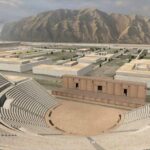

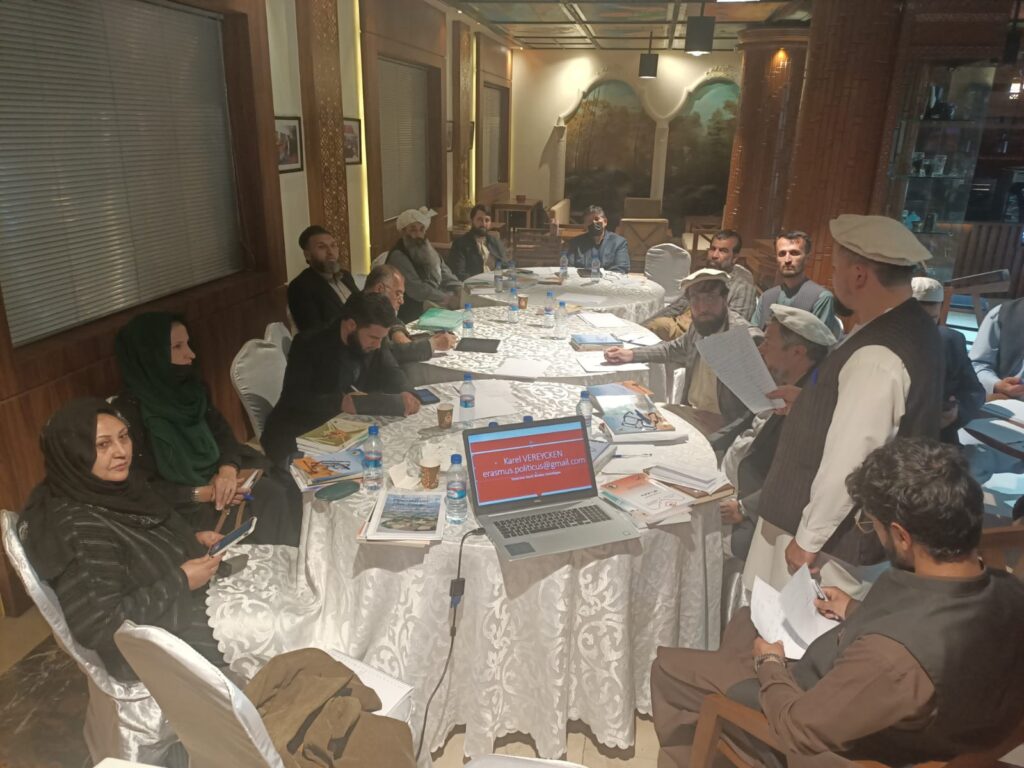
Invité par le Centre de recherche et de développement Ibn-e-Sina en tant que représentant de l’Institut Schiller, Karel Vereycken est intervenu le 7 novembre à la conférence sur la reconstruction du pays.
Son propos introductif, devant un groupe de travail composé d’historiens, d’archéologues et de membres de l’Académie des sciences d’Afghanistan, a donné lieu à une longue après-midi d’échanges sur le rôle de l’art, la méthodologie scientifique et les combats à mener pour sortir l’Afghanistan de son isolement et préserver un héritage culturel qui certes est afghan, mais appartient à toute l’humanité.
Parler de la culture d’un pays étranger est toujours une chose difficile, surtout si l’on n’en connaît pas la langue et si l’on n’a pas pu séjourner et voyager dans le pays pendant de longues périodes. Par conséquent, je ne peux que vous offrir mes impressions de l’extérieur et commenter ce que j’ai découvert dans des livres. Vous allez donc m’aider en me corrigeant et en me signalant ce qui a échappé à mon attention.
L’Afghanistan est un pays fascinant. Sa réputation de « tombeau des Empires » a capté mon imagination. Récemment, votre pays s’est émancipé de l’occupation américaine et de l’OTAN. Une poignée de combattants déterminés a mis en déroute un immense empire déjà en train de s’autodétruire. 34 ans plus tôt, le pays avait chassé l’occupant russe, après avoir résisté à l’Empire britannique au cours des trois guerres anglo-afghanes du XIXe siècle (1839-42, 1878-80 et 1919), alors que Londres, engagé dans le « Grand Jeu » (Great Game), tentait d’empêcher la Russie d’accéder aux mers chaudes.
Pour éviter d’être colonisé à la fois par la Russie et la Grande-Bretagne, l’Afghanistan a même courageusement refusé d’avoir des chemins de fer, ce qui explique qu’il n’existe aujourd’hui que 300 km de voies ferrées, une situation bien sûr inacceptable aujourd’hui.
Cette capacité de résistance et ce sentiment de dignité découlent, j’en suis convaincu, du fait que votre pays a su faire siennes les diverses influences qui s’y sont rencontrées. Voilà ce qui est devenu au fil des siècles le socle d’une forte identité afghane, totalement à l’opposé de l’étiquette tribale que les colonisateurs cherchent à lui coller.

J’aborderai uniquement, aujourd’hui, l’influence grecque, qui s’est avérée majeure à partir du moment où Alexandre le Grand traverse le Hindou Kouch, en 329 av. JC.
Dès lors, des dizaines de milliers de colons grecs, appelés Ioniens, s’installent en Asie centrale.

Sous le règne de ses successeurs concurrents, l’immense empire d’Alexandre le Grand se décompose en plusieurs entités et royaumes.
En 256 av. JC, Diodote Ier Soter fonde en Afghanistan le royaume gréco-bactrien, connu sous le nom de « Bactriane », dont le territoire englobe une grande partie de l’Afghanistan, de l’Ouzbékistan, du Tadjikistan et du Turkménistan actuels, ainsi que certaines parties de l’Iran et du Pakistan. L’influence grecque y perdure au moins jusqu’à l’arrivée de l’Islam au VIIIe siècle.
La Bactriane
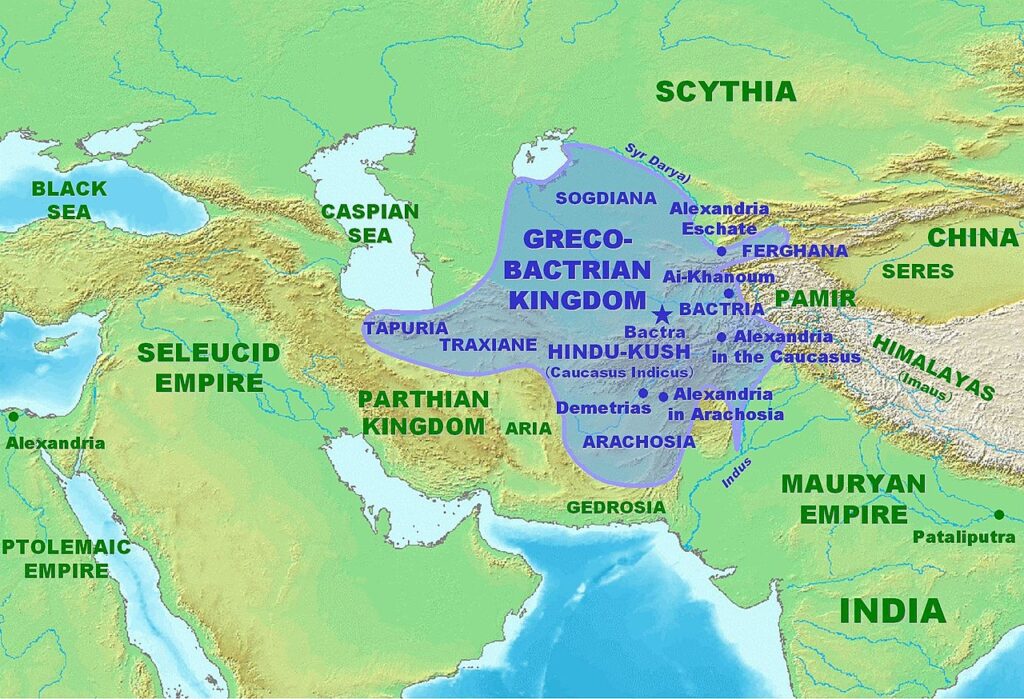
De nombreuses fouilles archéologiques confirment un développement urbain, économique, social et culturel remarquable.
Strabon (64 av. JC – 24 après JC), comme d’autres historiens grecs, qualifiait déjà la Bactriane de « Terre des mille cités », une terre que tous les écrivains, anciens et modernes, louaient pour la douceur de son climat et sa fertilité, car « la Bactriane produit tout, sauf de l’huile d’olive. »
Pour le naturaliste romain Pline l’Ancien (23 – 79 après JC), en Bactriane,
« les grains de blé poussent si gros qu’un seul grain est aussi gros que nos épis. »
Sa capitale Bactres (aujourd’hui Balkh, proche de Mazâr-e Charîf au nord de l’Afghanistan), « Mère des cités », figure parmi les villes les plus riches de l’Antiquité.
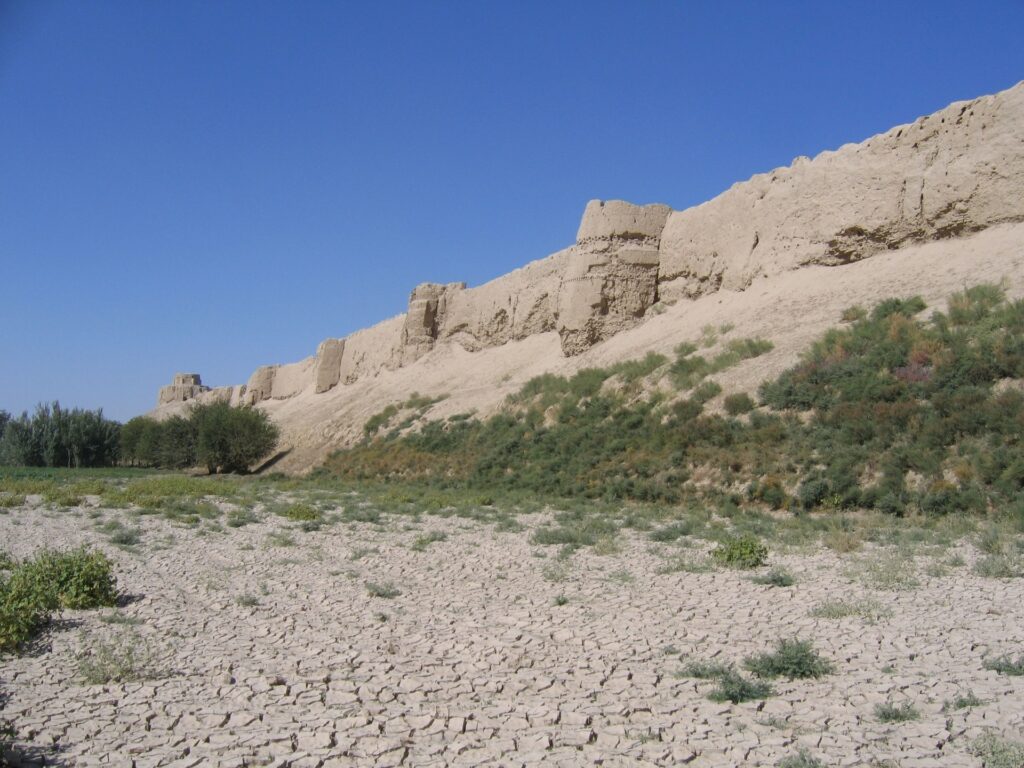

C’est là qu’Alexandre le Grand épouse Roxana (« Petite étoile ») et adopte l’habit perse pour pacifier son Empire. C’est également là que naîtra le père du grand médecin et philosophe Ibn Sina (Avicenne), avant de s’installer à Boukhara (Ouzbékistan).
Au fil du temps, la Bactriane sera le creuset de cultures et de civilisations où se mêlent, sur le plan artistique, architectural et religieux, traditions grecques et cultures locales.
Si le grec y est la langue de l’administration, les langues locales y foisonnent. Rien que les noms des villes démontrent la prédominance de la culture hellénique.
Ainsi, Ghazni s’appelle « Alexandrie en Opiana », Bagram « Alexandrie au Caucase », Kandahar « Alexandrie Arachosia », Hérat « Alexandria Ariana », etc., et la liste ne s’arrête pas là.

La ville de Gonur Depe (actuellement au Turkménistan, au nord de Mary, l’ancienne Merv), capitale du Royaume de Margiane, est un autre exemple de ce qu’on s’accorde maintenant à appeler la « Culture de l’Oxus »)
Aï Khanoum, la grecque

Si certaines villes ne font que changer de nom, d’autres sont construites ex nihilo. C’est le cas d’Aï Khanoum (« Dame Lune » en ouzbek), cité érigée au confluent du grand fleuve Amou Daria (l’Oxus des Grecs) et de la rivière Kokcha.
En 1961, le roi d’Afghanistan (Mohammed Zahir Shah), voulant marquer son indépendance vis-à-vis des Soviétiques et des Américains, invite la France à participer aux fouilles.
C’est le Département des archéologues français en Afghanistan (DAFA) qui met au jour les vestiges d’un immense palais dans la ville basse, ainsi qu’un grand gymnase, un théâtre pouvant accueillir 6000 spectateurs, un arsenal et deux sanctuaires.

Entourée de terres agricoles bien irriguées, la ville elle-même était divisée entre une ville basse et une acropole de 60 mètres de haut.
Bien qu’elle n’est pas située sur une route commerciale majeure, Aï Khanoum commande l’accès aux mines du Hindou Koush. De vastes fortifications, continuellement entretenues et améliorées, entourent la ville.
Un monument au cœur de la ville y présente une stèle inscrite en grec avec une longue liste de maximes incarnant les idéaux de la vie grecque. Celles-ci sont copiées de Delphes et se terminent par :
« Dès l’enfance, apprends les bonnes manières ;
dans la jeunesse, maîtrise tes passions ;
dans la vieillesse, sois de bon conseil ;
dans la mort, n’aie aucun regret. »
L’architecture du site indique que les colons grecques y vivent en bonne entente avec les populations locales. Elle est très grecque mais intègre en même temps diverses influences artistiques et éléments culturels que les Ioniens ont pu observer au cours de leur voyage du bassin méditerranéen à l’Asie centrale. Par exemple, ils utilisent les styles néo-babylonien et achéménide pour la construction de leurs cours.

Shortugai et la Civilisation de la vallée de l’Indus

La date précise des premières fondations d’Aï Khanoum reste inconnue.
A une jetée de là, Shortugai, avant-poste commercial et minier de la fameuse civilisation de l’Indus (dite « harappéenne ») qui, au IIIe millénaire avant notre ère, était à l’avant-garde sur le plan de l’irrigation et de la maîtrise de l’eau. (voir notre article)
Des scientifiques de l’Institut indien de technologie de Kharagpur et du Service archéologique d’Inde ont publié le 25 mai 2016, dans la revue Nature, les fruits d’une recherche qui permettrait de dater la civilisation harappéenne d’au moins 8000 ans avant JC et non 5500 ans, comme on le croyait jusqu’à présent. Cette découverte majeure signifierait qu’elle serait encore plus ancienne que les civilisations mésopotamienne et égyptienne.
Shortugai est construite avec des briques standardisées typiques de la vallée de l’Indus. Des sceaux de la civilisation de la vallée de l’Indus ont également été trouvés sur d’autres sites archéologiques d’Afghanistan.

Pendant plusieurs siècles, Shortugai a fonctionné comme un site minier exceptionnel pour l’extraction de l’étain (un minerai indispensable pour la fabrication du bronze), de l’or et du fameux lapis-lazuli, cette pierre précieuse bleue qui, avec l’or, habille de sa splendeur la tombe du pharaon égyptien Toutankhamon et d’autres tombes religieuses majeures en Mésopotamie (Irak).
Les données archéologiques démontrent que Shortugai commerçait avec ses voisins d’Aï Khanoum et construisit les premiers systèmes d’irrigation de la région, une spécialité de la civilisation de la vallée de l’Indus.
Bien des sites restent inexplorés en Afghanistan, pays où les guerres, les occupations étrangères et les pillages ont perturbé ou rendu impossible les recherches archéologiques.
Voici quelques-unes des découvertes de la DAFA, dont certaines restent exposées au Musée national de Kaboul.


Relations avec l’Inde

Ce qu’on a trouvé à Aï Khanoum, les pièces de monnaie, les objets et les céramiques, notamment d’origine indienne, témoigne qu’il s’agissait d’une importante plaque tournante du commerce avec l’Inde.
En 258 avant notre ère, Ashoka le Grand, souverain de l’empire Maurya (l’État dominant en Inde), fait ériger ce que l’on appelle « l’Edit grec d’Ashoka à Kandahar », une inscription rupestre bilingue, en grec et en araméen. Une autre inscription d’Ashoka était rédigée uniquement en grec.
Le contenu même de ces édits donne également une indication claire du niveau des échanges entre l’Inde et le monde hellénistique. Par exemple, dans son XIIIe édit, Ashoka, faisant preuve d’érudition, énumère avec précision tous les souverains du monde hellénistique de son époque.
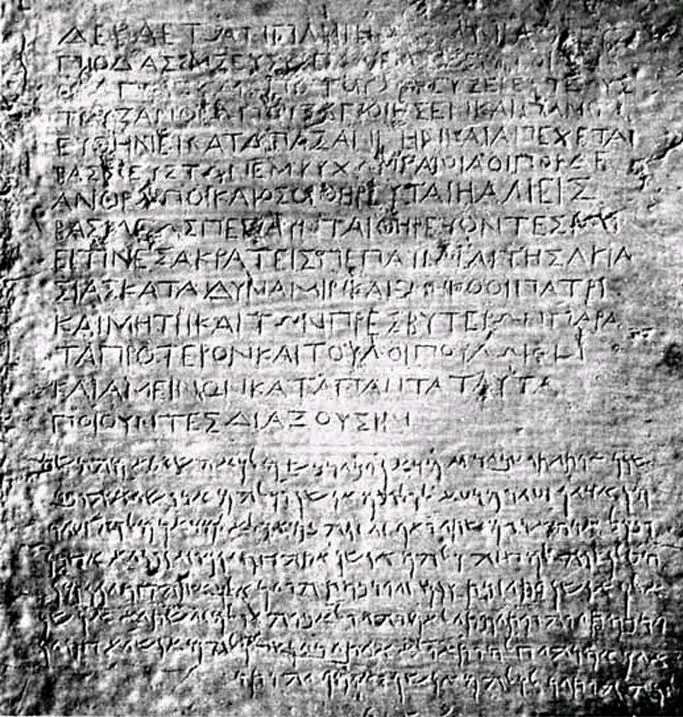
Relations avec la Chine
Outre son interaction avec le sous-continent indien, la Bactriane établira des contacts avec une puissance située encore plus à l’est : la Chine.
À la fin du IIe siècle avant JC, Zhang Qian, diplomate et explorateur de la dynastie Han, arrive en Bactriane. Le récit de sa visite, y compris son étonnement d’y trouver des marchandises chinoises sur les marchés (acquises via l’Inde), ainsi que ses voyages dans le reste de l’Asie centrale, sont conservés dans les œuvres de l’historien Sima Qian.

À son retour en Chine, Zhang Qian informe l’empereur de l’existence de civilisations urbaines sophistiquées en Asie centrale : le Dayuan (vallée de la Ferghana), la Bactriane (Afghanistan) et la Partie (nord-est du plateau iranien).
Les découvertes de Zhang Qian incitent l’empereur à envoyer des émissaires chinois en Asie centrale pour y favoriser le commerce avec la Chine. Certains historiens n’hésitent pas à qualifier cette décision de l’Empereur chinois de « naissance de la Route de la soie ».
Déclin et chute

Une grande partie des ruines actuelles d’Aï Khanoum datent de l’époque d’Eucratides Ier (172-145 av. JC), qui a considérablement réaménagé la ville et l’a peut-être rebaptisée Eucratideia, d’après son nom.
Il fut assassiné en 145 av. JC. par son fils. Un an plus tard, le royaume s’effondre face à l’invasion des nomades.
Aï Khanoum est pillée une première fois en 145 av. JC par les Sakas, des tribus iraniennes d’origine scythe, suivis quinze ans plus tard par les nomades chinois Yuezhi.
Le « complexe du trésor » d’Aï Khanoum montre des signes de pillage lors de deux assauts, à quinze ans d’intervalle. D’après des témoins oculaires, certaines villes se sont arrangées avec les envahisseurs et organisèrent une coexistence pacifique. Les villes qui ont résisté, comme Aï Khanoum, ont été pillées et incendiées.
L’empire Kouchan
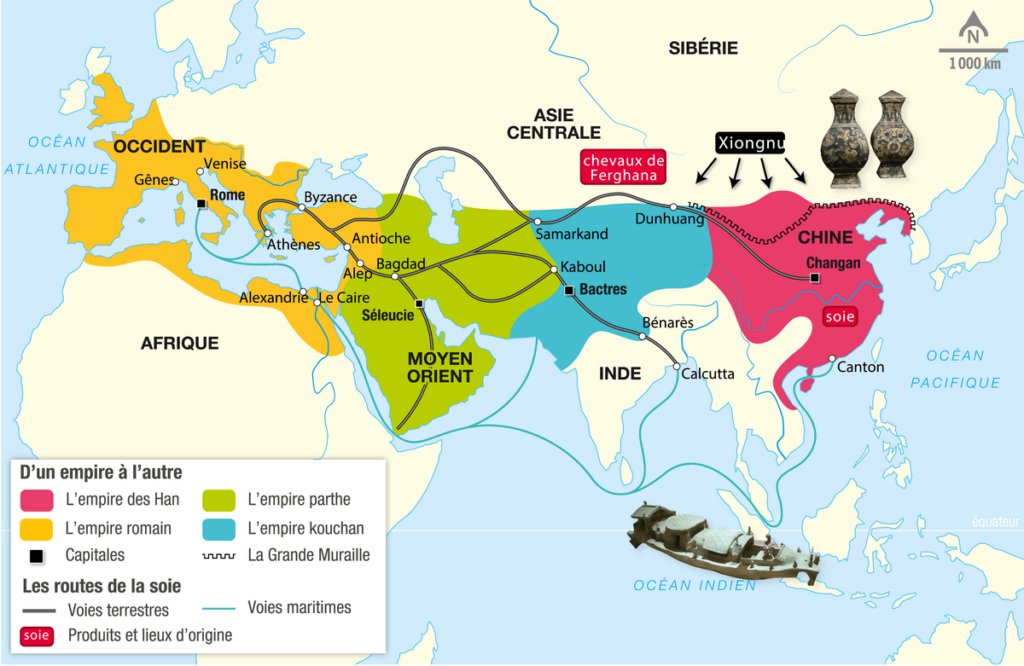
Les nomades chinois Yuezhi se sédentarisent et créent au début du Ier siècle l’Empire kouchan, qui englobe une grande partie de ce qui est aujourd’hui l’Ouzbékistan, l’Afghanistan, le Pakistan et l’Inde du Nord.
Son territoire s’étend de l’Asie centrale et du Gandhara (frontière occidentale actuelle du Pakistan) à Pataliputra, dans la plaine du Gange (Inde d’aujourd’hui). La capitale principale de son empire était située à Purushapura (aujourd’hui Peshawar au Pakistan).
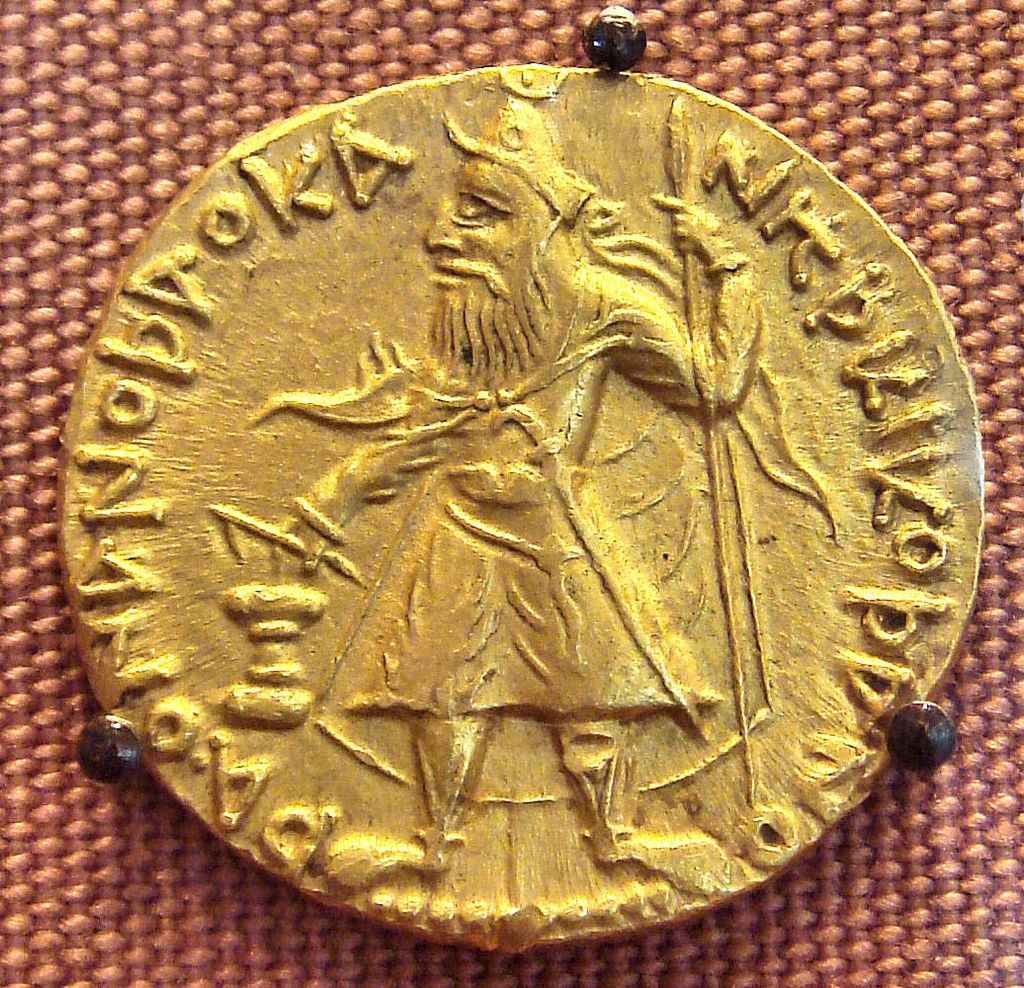
C’est sous le règne de Kanishka le Grand (vers 127-150) que l’Empire kouchan deviendra célèbre pour ses réalisations militaires, politiques et spirituelles. Kanishka échange des ambassadeurs avec l’empereur romain Marc Aurèle (161-180) et l’empereur Han de Chine. Il noue des contacts diplomatiques avec la Perse sassanide et le royaume d’Aksoum (Yémen et Arabie saoudite d’aujourd’hui).
Si la dynastie kouchane reprend la tradition gréco-bactrienne, elle se forge peu à peu sa propre identité.
Les artistes kouchans enrichirent la sculpture bouddhique en donnant à Bouddha la forme humaine, innovation qui fut la plus importante de l’époque.
En 127, Kanishka remplace le grec par le bactrien, une langue moyenne iranienne utilisant l’alphabet grec.
Le bouddhisme
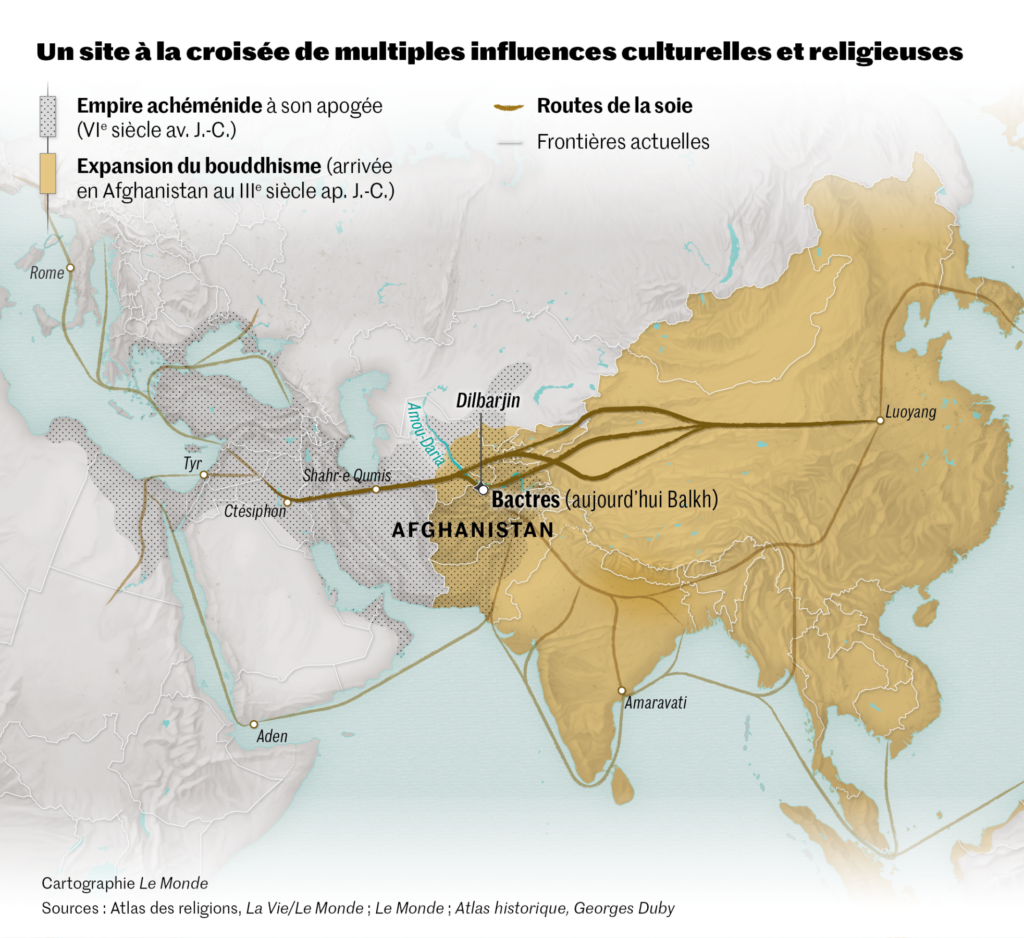
Les Kouchans joueront également un rôle majeur dans la transmission du bouddhisme. Le rayonnement de cette religion venue des rives du Gange favorisera celui des Routes de la soie.
Dans le domaine de la religion, les Kouchans, initialement attirés par l’hindouisme, joueront un rôle majeur dans la transmission du bouddhisme mahayana du Gandhara vers la Chine, l’Asie centrale et même le Sri Lanka, favorisant ainsi l’expansion de la route de la soie.
Tous ces facteurs ont inauguré une période de paix relative de 200 ans, connue comme la « Pax Kouchana ».
À partir du milieu du IIIe siècle après JC, l’Empire kouchan, affaibli, commence à se désintégrer. Dans sa partie occidentale, il passe sous le contrôle des Kushanshahs, c’est-à-dire les Indo-Sassanides (perses), progressivement supplantés au nord par les Hephtalites (appelés également les « Huns blancs » ou « Huns iraniens ») venus de la steppe d’Asie centrale.
Le bouddhisme connaît néanmoins une période de grande prospérité, comme l’illustrent les descriptions du moine chinois Xuanzang du VIIe siècle ainsi que la construction des statues géantes de bouddhas dans la vallée de Bamiyan en Afghanistan.

L’Islam
Après avoir conquis l’Iran, l’islam pénètre l’Afghanistan par le nord. Il n’y a pas de preuve d’un rejet massif de la nouvelle religion, sauf dans des régions isolées. Cependant, la volonté de rester indépendants des gouverneurs nommés par Damas (Omeyyades) puis par Bagdad (Abassides) se manifeste rapidement. C’est même à partir d’une province couvrant une partie du nord de l’Afghanistan, le Khorasan, que se répand initialement une partie de l’insurrection contre les Omeyyades pour les remplacer par le califat abbasside d’Haroun-al-Rachid, plus humaniste, et la création de Bagdad (voir notre article).
À partir de la fin du Xe siècle, une dynastie d’origine turque, les Ghaznévides, bâtit autour de leur capitale Ghazni (Afghanistan) un vaste sultanat qui s’étend jusqu’en Inde et fonde une communauté musulmane durable.

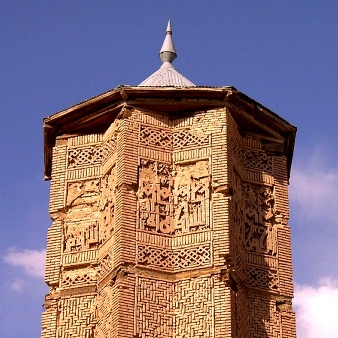
Leur influence culturelle se mesure par la beauté de l’architecture qu’ils nous ont laissée, mais aussi par le patronage qu’ils accordèrent au grand poète épique Ferdowsi (940-1025), à qui l’on doit la grande épopée nationale en langue persane, le Shahnameh : Le livre des rois.
Les Ghaznévides ont été suivis par une nouvelle dynastie, les Ghorides, originaire de la partie centrale de l’Hindou Kouch. C’est à eux que l’on doit l’impressionnant minaret de Jam.
Ce riche patrimoine culturel, qui a jeté les bases de leur identité et qui a donné sa dignité au peuple afghan, a été ignoré, détruit par les guerres successives, pillé et saccagé.
Fortement combattu par les talibans au pouvoir à Kaboul, ISIS, Daech et d’autres groupes terroristes, dont certains encouragés en sous-main par des agences de renseignement occidentales se sont livrés à un pillage à échelle quasi-industrielle du patrimoine culturel afghan. Pour eux, la revente d’objets d’art et d’antiquités est une des principales sources de revenus.
Recommandations
Aujourd’hui, le temps est venu d’un nouveau départ. L’Afghanistan peut changer complètement son image dans le monde, qui a été polluée par des adversaires et des ennemis qui veulent maintenir l’Afghanistan comme une zone de non-développement pour leur propre grand jeu géopolitique.
Ma proposition pour renouveler la contribution de l’Afghanistan à la culture mondiale est simple.
Avec Mes Aynak, qui signifie « petite mine », située à 35 km au sud de Kaboul, l’Afghanistan dispose du deuxième plus grand gisement de cuivre au monde. Alors que la Chine et les autres pays du BRICS ont besoin de ce métal précieux pour leur développement industriel, la mine offrira un revenu substantiel dont l’Afghanistan a un besoin urgent pour reconstruire le pays.
Le 25 mai 2008, Ibrahim Adel, ministre des Mines, et Shen Heting, directeur général de MCC, l’actionnaire majoritaire du consortium MCC-Jiangxi Copper MJAM, ont signé le contrat minier de Mes Aynak.
Ce contrat décrivait les conditions du premier grand projet minier et du plus important investissement étranger en Afghanistan. Cependant, suite à des incidents de sécurité qui ont créé d’importants problèmes d’insécurité, et sous la pression des puissances étrangères, le projet a été bloqué.

Paradoxalement, cela a donné aux archéologues le temps de mettre au jour sur le site minier une zone de 40 ha d’une valeur culturelle exceptionnelle de classe mondiale, principalement un vaste complexe de monastères bouddhistes, comprenant des stupas (temples), des peintures murales, des sculptures et des centaines d’artefacts archéologiques, etc.
Même si le contrat (fichier pdf) a pu être modifié depuis 2008, on ne peut que constater que le contrat initial contient une série d’aspects potentiellement très intéressants, à la fois pour la Chine mais surtout pour l’Afghanistan lui-même.
- EXPORTER DU MÉTAL, PAS DU MINERAI
De même que la Bolivie ne veut pas exporter du lithium (matière première) mais des batteries (produit fini transformé à haute valeur ajoutée), l’Afghanistan ne veut pas exporter du minerai de cuivre mais du cuivre métal. Pour atteindre cet objectif, le contrat prévoit la construction d’une fonderie sur le site.
Paragraphe IV, 33 : « Afin de respecter son engagement envers le gouvernement de financer, construire et exploiter une fonderie en Afghanistan, la MCC a demandé au gouvernement de lui donner accès à des gisements de phosphates, de calcaire et de quartz qu’elle pourra utiliser dans le cadre du projet Aynak. » - ACHATS LOCAUX
Paragraphe VII, 38 : « MCC s’efforce d’acheter des biens et des services en Afghanistan s’ils sont disponibles. » - MAIN-D’ŒUVRE LOCALE
Paragraphe VIII, 39, a : « MCC emploie du personnel afghan, dans toute la mesure du possible. » - APPROVISIONNEMENT EN EAU
Paragraphe IV, 32 : « MCC s’est engagée auprès du gouvernement à construire des puits d’approvisionnement en eau et des systèmes de canalisation … pour répondre aux besoins en eau douce du projet. La MCC s’est également engagée à réutiliser et à recycler l’eau de traitement dans la mesure du possible. » - CENTRALE AU CHARBON
Paragraphe IV, 31 : « MCC s’est engagée auprès du ministère des Mines à construire … une centrale au charbon d’une capacité de 400 mégawatts pour fournir de l’énergie électrique au projet et à Kaboul. » - CHEMIN DE FER
Paragraphe IV, 30 : « MCC s’est engagée à construire un chemin de fer associé au projet ». - LOGEMENT
Paragraphe IV, 24 : « MCC doit fournir des logements de qualité et en quantité suffisante à ses salariés et à leurs familles immédiates, à un prix de location raisonnable. » - SOINS MÉDICAUX
Paragraphe IV, 25 : « MCC fournira des soins médicaux gratuits à tous ses salariés et à leurs familles… et établira, dotera en personnel et entretiendra des dispensaires, des cliniques et des hôpitaux en nombre suffisant … » - ÉCOLES
Paragraphe IV, 26 : « MCC doit fournir gratuitement un enseignement primaire et secondaire adéquat aux enfants de tous les salariés et résidents de la zone entourant Aynak. » - CADRE DE VIE
Paragraphe IV, 27 : « MCC construira et financera le fonctionnement de centres d’activités récréatives adéquats tels que des gymnases et des terrains de sport. … En outre, il construira un marché/une zone commerciale. » - RELIGION
Paragraphe IV, 28 : « MCC respectera et protégera les convictions religieuses du peuple afghan. »
Le monde serait stupéfait en constatant que l’Afghanistan mobilise ses meilleurs architectes et urbanistes pour construire une nouvelle ville à Mes Aynak qu’il baptisera poétiquement, l’« Aï Khanoum du XXIe siècle ».
A Kaboul, un archéologue de premier plan qui travaille sur le site depuis une décennie, m’a confié avec une joie non-dissimulée que, suite à d’intenses discussions en octobre dernier entre les autorités afghanes et l’entreprise chinoise, une issue heureuse a été trouvée.
A l’heure actuelle, dit-il, les deux parties ont convenu de préserver, non plus une infime partie du site archéologique (la partie centrale avec les temples bouddhistes), mais l’ensemble des vestiges historiques du site en surface. A en croire mon interlocuteur, la décision est prise que l’ensemble du site sera désormais exclusivement exploité par la technique d’exploitation minière souterraine. N’en déplaise à la presse occidentale, le sauvetage de Mes Aynak révèle au monde le vrai visage du nouveau gouvernement afghan.
Il rendra également pensable, d’ici un certain temps, la reconstruction des bouddhas géants de la vallée de Bamiyan, l’un de 55 mètres et l’autre de 38 mètres, détruits en 2001. Plusieurs experts, lors de colloques récents de l’UNESCO, ont précisé que les difficultés techniques ne sont pas insurmontables, les bouddhas étant fabriqué en stuc. Le soi-disant « danger » que les sculptures soient considérées comme « fausses » n’a aucun sens, tant que l’intention d’atteindre un bien supérieur par leur reconstruction est réelle.
La « Proposition technique pour la revitalisation des statues du Bouddha de Bâmiyân » de 2017, élaborée par le département d’architecture de l’université japonaise Mukogawa Women’s University, mérite d’être examinée. Sans doute pourra-t-on faire mieux, mais elle a le mérite d’exister. Des chercheurs chinois se disent également prêts à donner un coup de main.
Rappelons que le monde compte 620 millions de bouddhistes qui considèrent Bamiyan comme une partie de leur culture et pourraient envisager de venir en Afghanistan pour mieux comprendre leur propre histoire.
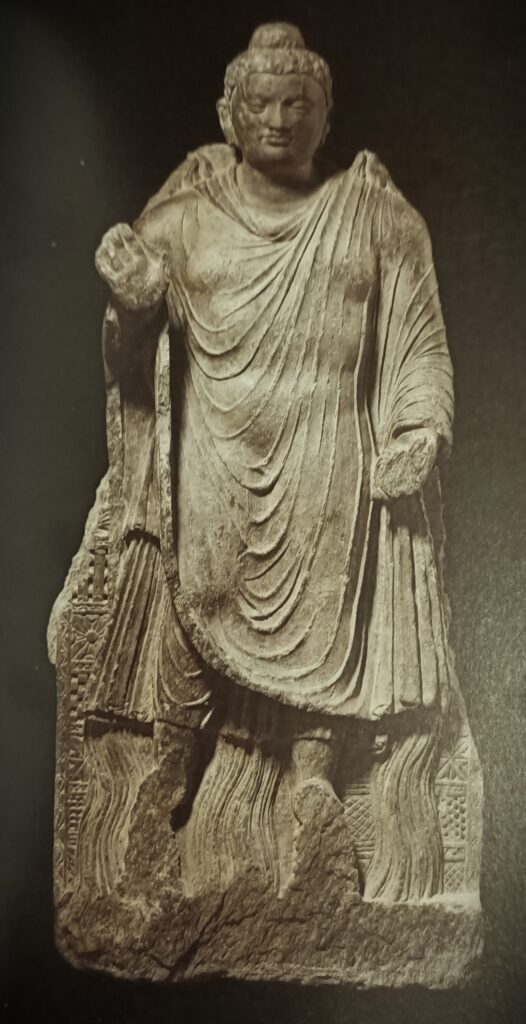
Si l’Afghanistan indiquait clairement au monde qu’il a décidé de renforcer ses activités économiques et minières tout en protégeant, notamment grâce à l’aide généreuse de la Chine, le patrimoine culturel mondial sur son sol, il apparaîtra aux yeux de tous ce qu’il est désormais aujourd’hui : une force du bien, de la tolérance et de la paix dans le monde, en cohérence avec sa propre identité et son histoire.
L’Afghanistan apparaîtra comme le « Bouddha de feu » (IIe-IIIe siècle) du Musée national de Kaboul, où l’on voit la réponse donnée par Bouddha à un défi lancé par des hérétiques selon lequel il ne pouvait pas faire de miracles.
Connu sous le nom de « miracles jumeaux », on y voit Bouddha confiant avec des flammes sortant de ses épaules et des cours d’eau de ses pieds ! En altérant ces deux flux, dit la légende, Bouddha a même fait apparaître un arc-en-ciel !
En augmentant sa production d’énergie et en gérant d’une façon plus intelligence ses ressources en eau, l’Afghanistan démontrera, j’en suis convaincu, sa splendide force spirituelle !
Merci à tous et j’ouvre le débat à vos questions.
Omar Merzoug: Avicenne ou l’islam des lumières
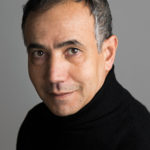

En avril 2022, Karel Vereycken s’est entretenu avec Omar Merzoug, docteur en philosophie et spécialiste de la pensée au Moyen Âge. Il a publié en 2018 Existe-t-il une philosophie islamique ? (Cahiers de l’Islam). Pendant sept ans, il a enseigné la philosophie et la civilisation islamique à l’Institut Al-Ghazâli de la Grande Mosquée de Paris.
This interview in EN (pdf)
Karel Vereycken : Monsieur Merzoug, bonjour. Après sept ans de recherches, d’études et de vérification de documents historiques, vous venez de publier en 2021, chez Flammarion, une biographie enthousiaste et fouillée d’Avicenne (980-1037). Qui était ce personnage et pourquoi avoir publié ce livre maintenant ?

Omar Merzoug : Il s’agit de l’illustre Ali Ibn Sînâ (que l’Occident nomme Avicenne), savant, médecin, philosophe et homme d’Etat, qui a eu une vie passionnante et fort mouvementée, et dont l’influence sur les penseurs chrétiens du Moyen Âge, de l’avis même des spécialistes les plus autorisés, fut considérable. Ce ne fut pas, comme on a tendance à le croire, un commentateur, mais c’était un penseur qui a créé tout un système s’inspirant d’Aristote, mais qui l’enrichit, le contredit.
Un penseur indépendant, par conséquent. Il fut lu comme philosophe jusqu’au XVIIe siècle et l’on retrouve dans les écrits des philosophes des Temps modernes, Malebranche, Leibniz et Spinoza, des échos de son œuvre. Comme médecin, ses travaux furent longtemps au programme des universités européennes. C’est donc une figure fort intéressante en tant que savant, mais aussi en tant qu’homme.
Publier ce livre maintenant, c’est d’abord saluer cette figure éminente du monde musulman à l’heure où, il faut bien le dire, l’islam n’a pas bonne presse. Le rationalisme d’Avicenne, sa curiosité intellectuelle, sa capacité à assimiler toutes sortes de savoir, son esprit encyclopédique et son inventivité philosophique sont autant de traits qui pourraient contribuer à une renaissance de la véritable culture philosophique dans le monde musulman, culture philosophique qui est bien malmenée aujourd’hui.
De père afghan, né en Ouzbékistan et d’éducation perse, de nombreux pays (qui n’existaient pas à son époque dans leurs frontières actuelles) se réclament les héritiers de sa gloire. Qui a raison ?
On ne prête qu’aux riches. Plus sérieusement, Avicenne est un persan d’Ouzbékistan. Tout l’indique, mais cela ne saurait empêcher Turcs, Arabes et Européens de se réclamer de lui, de le lire et même de le critiquer, et c’est d’ailleurs ce qui s’est produit.
La deuxième partie du titre de votre livre, L’islam des lumières, sous-entend qu’il y aurait plusieurs islams…
Il n’y a certes pas plusieurs islams, mais il y a des lectures et des approches différentes, et même contradictoires, de l’islam. Et cela ne date pas d’aujourd’hui. Il y a, pour résumer, une lecture littérale des textes fondamentaux de l’islam et il y a des lectures plus subtiles, plus soucieuses de faire prévaloir l’esprit sur la lettre. Au reste, le Coran lui-même autorise cette disparité des lectures (Sourate III, verset 7).
Comment Avicenne a-t-il concilié théologie et philosophie ?
Comme tous les grands penseurs du Moyen Âge et même des Temps modernes, Avicenne s’est attaqué à ce problème essentiel et inévitable du rapport entre la théologie et la philosophie. Il ne s’est pas tant agi de concilier la raison avec la foi, mais plutôt la Loi religieuse et la raison. Sur ce point, Avicenne présente notamment sa théorie de l’émanation comme la seule interprétation véritable de la création. Partant du principe qu’il ne faut pas prendre à la lettre les récits, les allégories, les métaphores et toute la symbolique du Coran, il conclut qu’il faut l’interpréter à l’aune des principes de la raison. C’est en définitive la raison qui garde la primauté en matière d’interprétation des textes religieux.
A son époque, Avicenne était-il apprécié pour son travail en médecine ou pour ses idées philosophiques ?
Sur ce point, les spécialistes d’Avicenne ne sont pas tous d’accord. En Orient on l’estime beaucoup plus comme médecin que comme philosophe. En Occident, on a plutôt tendance à le considérer comme philosophe, d’autant que sa médecine n’a plus, compte tenu des progrès de la science, qu’un intérêt historique.
Néo-platoniciens, aristotéliciens et thomistes se prétendent souvent disciples d’Avicenne, mais en le lisant, on constate que ce dernier n’entre dans aucune case. Quelle qualité faut-il donc avoir pour pouvoir se dire disciple d’Avicenne ?
Être disciple d’Avicenne aujourd’hui voudrait signifier être rationaliste, pas au sens d’une sorte d’agnosticisme ou d’athéisme, mais au sens où la raison a qualité pour examiner toutes choses, que peu de domaines sont soustraits à son empire. Bien entendu, dans sa mystique qui est intellectualiste, Avicenne ménage une transition vers un au-delà de la raison, qui ne peut être atteint que par une sorte d’illumination. C’est bien la raison pour laquelle certains penseurs chrétiens du Moyen Âge ont pu établir un lien entre saint Augustin et Avicenne.
Sans avoir vécu à Bagdad et né après la grande période des Abbassides, sous Al-Mamoun et ses Maisons de la sagesse réunissant penseurs arabes, juifs et chrétiens nestoriens pour traduire l’héritage grec et syriaque, voyez-vous en Avicenne un héritier de la démarche mutazilite qui fit la grandeur de Bagdad ?
Avicenne est certainement plus proche des Mu’tazila que des partisans de l’approche littéraliste et anthropomorphiste. Les Mu’tazila combattaient pour la liberté de l’esprit et c’est, à peu de chose près, le combat d’Avicenne, convaincu que tout outrage à ce principe serait catastrophique. S’il n’y a pas de débat, de controverse, de libre dialogue et de recherche indépendante, il ne saurait y avoir au bout du compte qu’un recul de la pensée. La grandeur de la civilisation de Bagdad a été précisément, sous Al-Ma’mûn et ses successeurs immédiats, de permettre, par une politique délibérée et réfléchie, ce bouillonnement culturel, cette effervescence intellectuelle extraordinaire qu’on n’a pas revue depuis dans le monde musulman.
En lisant votre biographie d’Avicenne, qui nous introduit à lui en partant de sa vie quotidienne, on découvre qu’il n’avait rien d’un intellectuel de salon. Activement engagé pour le bien commun et la santé de tous, sa vie est loin d’être une sinécure et on le voit souvent contraint de s’exiler. Pourquoi ?
Se situant dans la tradition platonicienne qui voulait que les philosophes gouvernent les Etats parce qu’ils sont les plus savants, Avicenne a directement exercé les responsabilités du pouvoir. A deux reprises, il a géré un Etat et cela a failli lui coûter la vie. Introduisant les réformes indispensables et luttant contre les privilèges qu’il estimait indus de l’armée, il a déclenché une mutinerie des prétoriens. Oui, s’engager dans la cité pour des causes méritoires, c’est être d’une certaine manière avicennien. Comme Platon, il a échoué dans son entreprise, mais elle méritait d’être tentée, comme elle le mérite toujours.
Pourquoi le Canon de la médecine d’Avicenne a-t-il permis tant de progrès en médecine ?
C’est un livre fort intéressant sous plusieurs angles. C’est une somme du savoir médical, qui a d’ailleurs, en tant que telle, une postérité exceptionnelle. Dans cet ouvrage, il y a plusieurs avancées intéressantes. C’est un livre fort bien composé et qui est fondé de part en part sur les règles et les principes de la logique. Il a été de surcroît conçu dans une perspective pédagogique. Des fragments entiers du Canon sont rédigés sous forme d’abrégés pour permettre une assimilation plus rapide du savoir médical.
Avicenne estime qu’on ne saurait comprendre la maladie et donc lui trouver un remède que si on établit des liens de causalité. Reprenant la théorie des quatre causes d’Aristote, il les adapte à sa recherche médicale et juge qu’on n’atteint la pleine connaissance d’une maladie que si on en recherche les causes, écartant ainsi une approche strictement empirique.
A ses yeux, il y a une unité entre les organes et les fonctions du corps, de la même manière qu’il établit un rapport entre l’organisme et le monde extérieur. C’est d’ailleurs pour cela qu’il accordait, en tant que médecin, une importance essentielle aux mesures prophylactiques et à l’environnement.
Autre chose à signaler, Avicenne fut certainement le premier à proposer une approche de l’anatomie de l’œil, à émettre le diagnostic de la pleurésie et de la pneumonie, à distinguer la méningite infectieuse des autres infections aiguës.
D’autre part, il accordait une importance primordiale aux exercices physiques. C’est sans doute le premier, dix siècles avant Freud, à avoir insisté sur l’importance de la sexualité et de son rôle dans l’équilibre psychologique de la personne. Enfin, il fut sans doute l’un des pionniers de la médecine psychosomatique. En témoigne le cas de l’amoureux transi que je rapporte dans ma biographie.
Estimant sa personnalité hors du commun capable d’inspirer le meilleur de la civilisation islamique, Mme Helga Zepp-LaRouche, la fondatrice de l’Institut Schiller, a lancé une grande « initiative Ibn Sînâ » pour reconstruire l’Afghanistan et de son système de santé. Comment voyez-vous cette démarche ?
C’est sans doute une initiative extrêmement louable qui réintègre Avicenne dans son milieu (son père était afghan) et qui, sous deux perspectives, la santé et la grandeur de sa gloire, lui rend hommage.
Les raisons du succès de votre livre ?
C’est toujours délicat pour un auteur de dire quelles sont les raisons qui expliquent le succès, relatif dans mon cas, d’un livre. Je l’attribue d’abord au genre biographique qui s’apparente un peu au roman – au reste, la vie d’Avicenne est très romanesque. Ensuite, à l’effort pédagogique qui rend accessible la présentation de cette éminente figure du savoir, et peut-être aussi, à un style littéraire agréable et délié.
On connaît bien, d’Avicenne, ses travaux en médecine et maintenant, grâce à votre biographie, sa vie. A quand un nouveau livre dédié plus spécifiquement à ses idées philosophiques ?
Il n’existe pas sur le marché d’exposé systématique de la pensée d’Avicenne. Ce qui existe, fruit du travail de certains universitaires travaillant dans le champ avicennien, ce sont des monographies sur des thèmes ou des concepts avicenniens.
C’est de toute façon un travail d’une tout autre nature que la biographie et pour un tout autre public, plus restreint. Je me laisserai peut-être tenté par un tel projet, qui sait ?



